Financial Crisis Prediction: Assessment of Early Warning Signs Report
VerifiedAdded on 2021/04/21
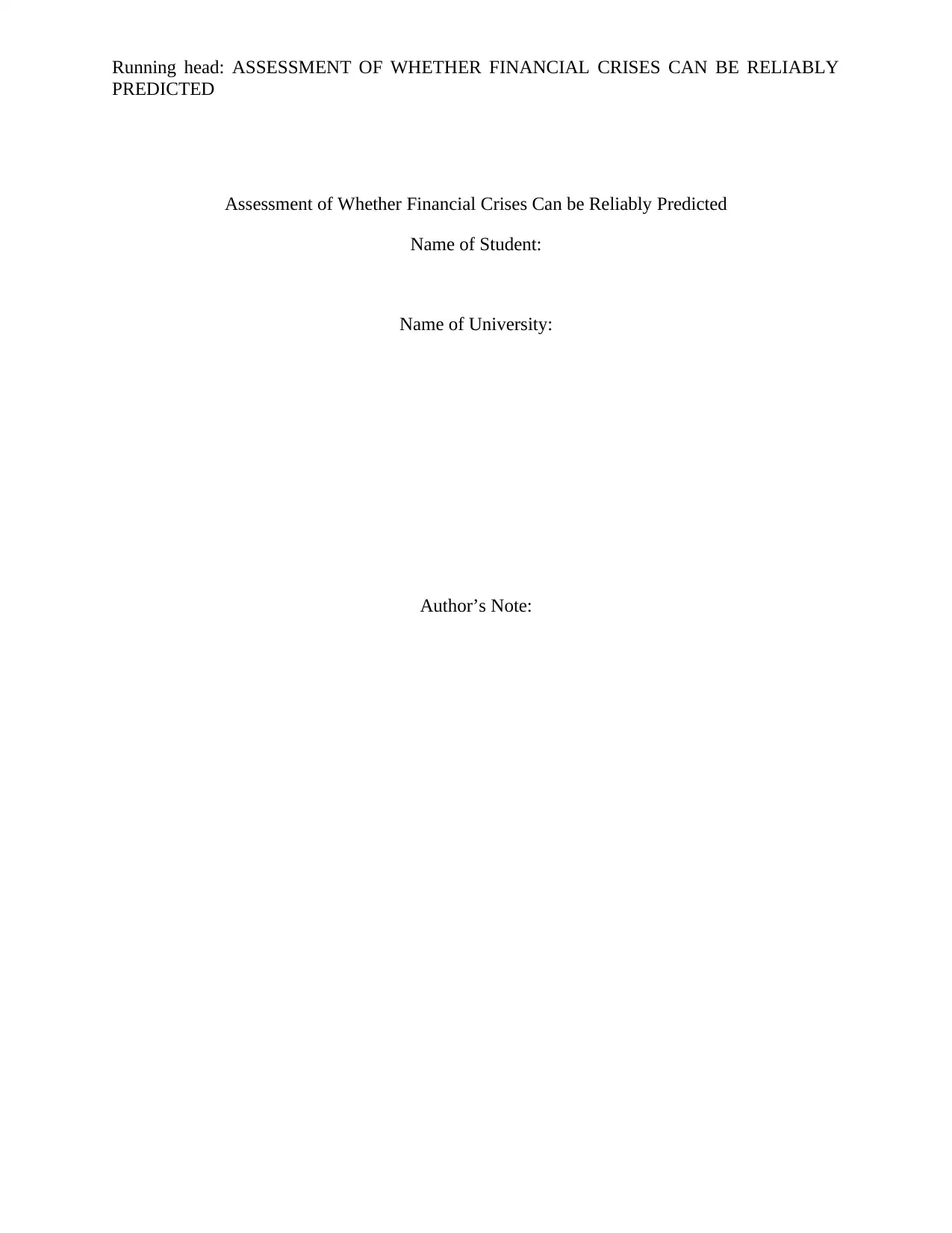
PREDICTED
Assessment of Whether Financial Crises Can be Reliably Predicted
Name of Student:
Name of University:
Author’s Note:
Paraphrase This Document
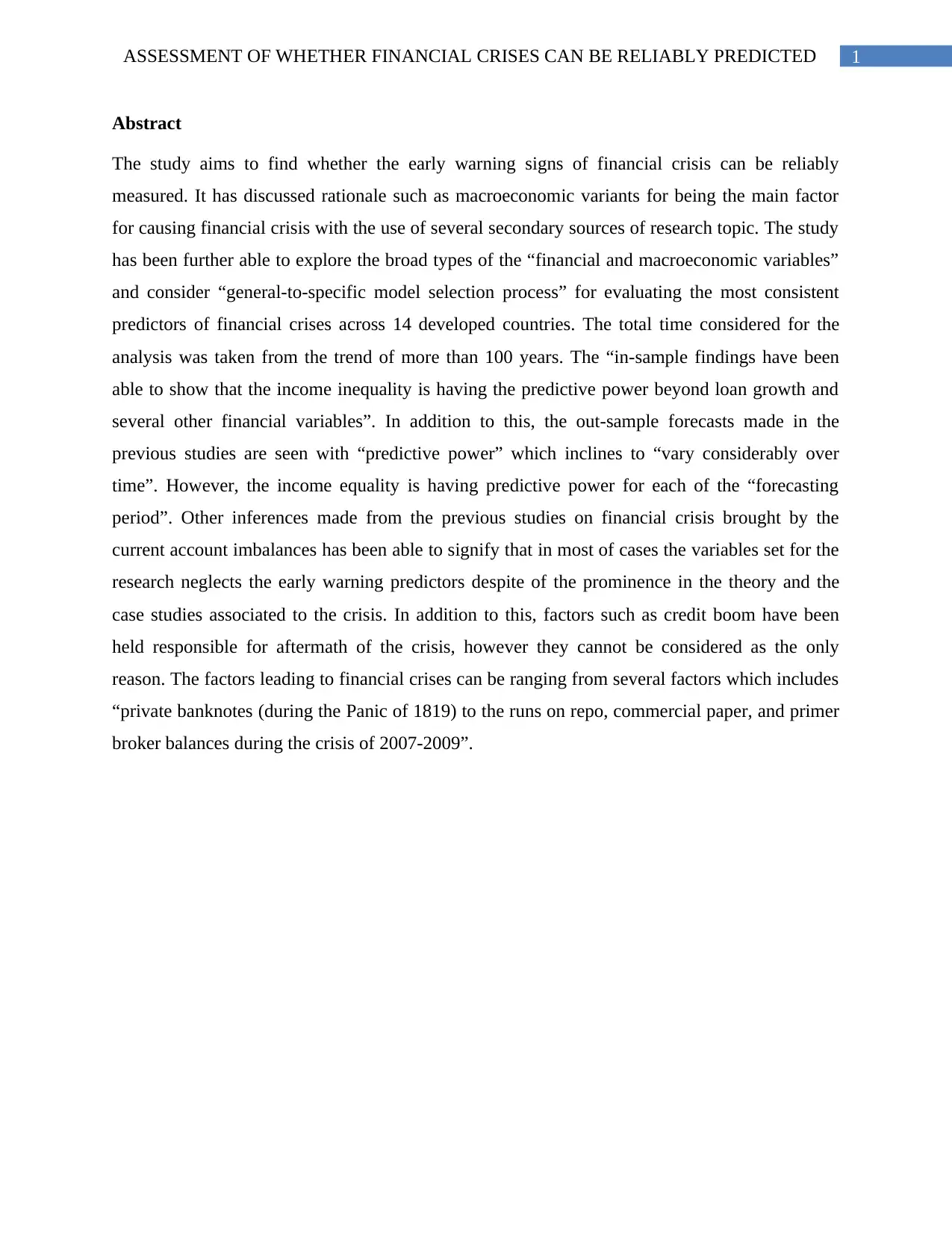
Abstract
The study aims to find whether the early warning signs of financial crisis can be reliably
measured. It has discussed rationale such as macroeconomic variants for being the main factor
for causing financial crisis with the use of several secondary sources of research topic. The study
has been further able to explore the broad types of the “financial and macroeconomic variables”
and consider “general-to-specific model selection process” for evaluating the most consistent
predictors of financial crises across 14 developed countries. The total time considered for the
analysis was taken from the trend of more than 100 years. The “in-sample findings have been
able to show that the income inequality is having the predictive power beyond loan growth and
several other financial variables”. In addition to this, the out-sample forecasts made in the
previous studies are seen with “predictive power” which inclines to “vary considerably over
time”. However, the income equality is having predictive power for each of the “forecasting
period”. Other inferences made from the previous studies on financial crisis brought by the
current account imbalances has been able to signify that in most of cases the variables set for the
research neglects the early warning predictors despite of the prominence in the theory and the
case studies associated to the crisis. In addition to this, factors such as credit boom have been
held responsible for aftermath of the crisis, however they cannot be considered as the only
reason. The factors leading to financial crises can be ranging from several factors which includes
“private banknotes (during the Panic of 1819) to the runs on repo, commercial paper, and primer
broker balances during the crisis of 2007-2009”.
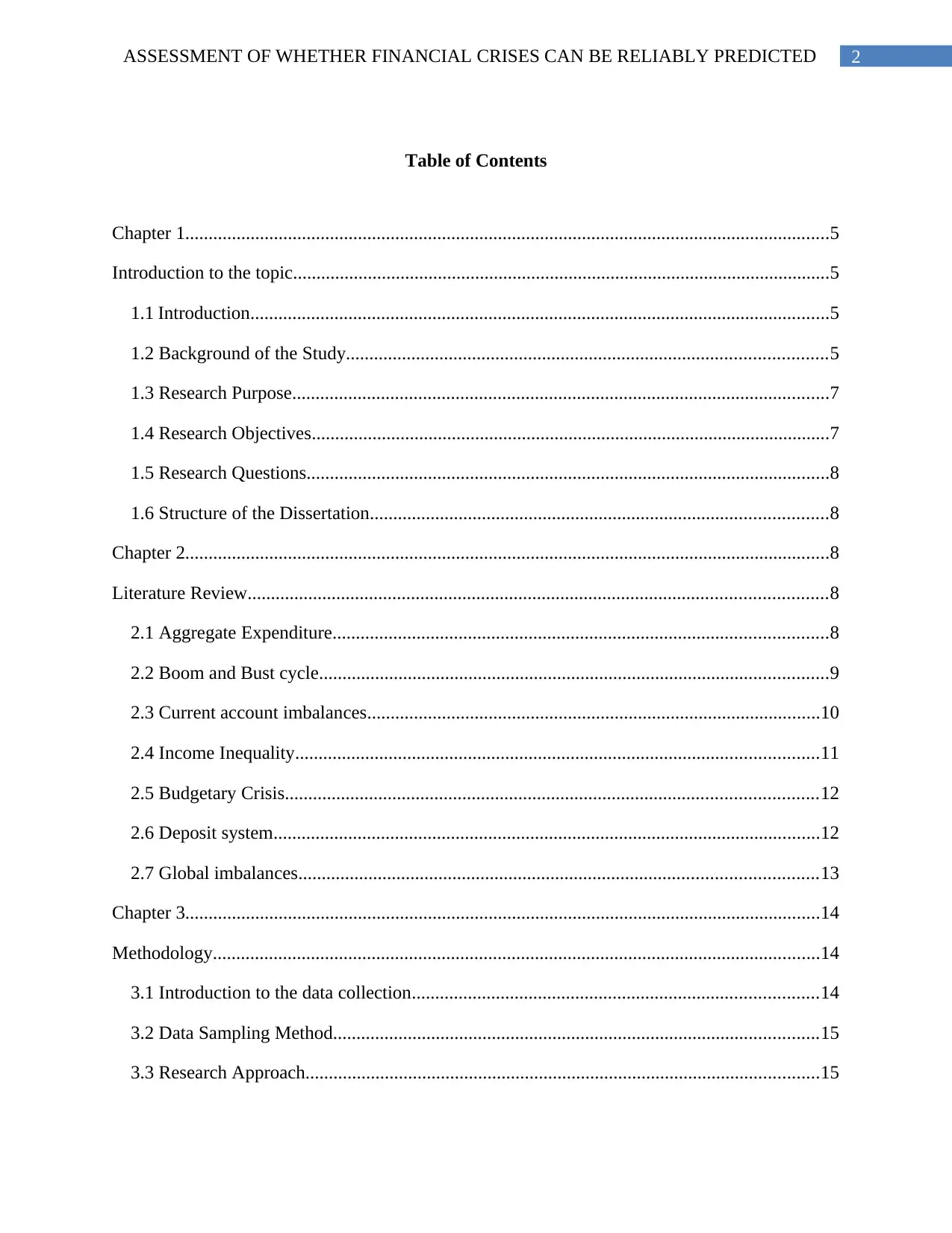
Table of Contents
Chapter 1..........................................................................................................................................5
Introduction to the topic...................................................................................................................5
1.1 Introduction............................................................................................................................5
1.2 Background of the Study.......................................................................................................5
1.3 Research Purpose...................................................................................................................7
1.4 Research Objectives...............................................................................................................7
1.5 Research Questions................................................................................................................8
1.6 Structure of the Dissertation..................................................................................................8
Chapter 2..........................................................................................................................................8
Literature Review............................................................................................................................8
2.1 Aggregate Expenditure..........................................................................................................8
2.2 Boom and Bust cycle.............................................................................................................9
2.3 Current account imbalances.................................................................................................10
2.4 Income Inequality................................................................................................................11
2.5 Budgetary Crisis..................................................................................................................12
2.6 Deposit system.....................................................................................................................12
2.7 Global imbalances...............................................................................................................13
Chapter 3........................................................................................................................................14
Methodology..................................................................................................................................14
3.1 Introduction to the data collection.......................................................................................14
3.2 Data Sampling Method........................................................................................................15
3.3 Research Approach..............................................................................................................15
You're viewing a preview
Unlock full access by subscribing today!
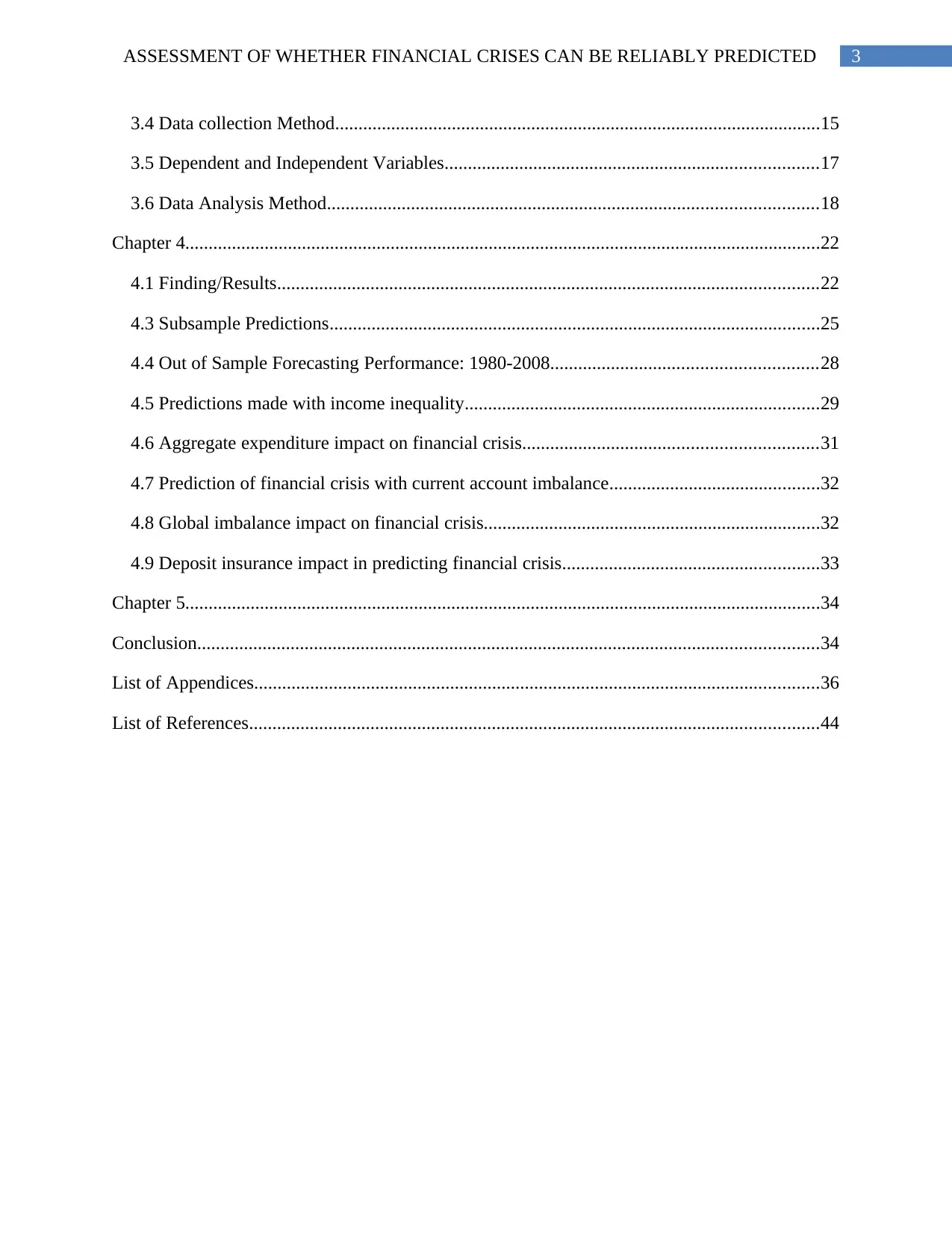
3.4 Data collection Method........................................................................................................15
3.5 Dependent and Independent Variables................................................................................17
3.6 Data Analysis Method.........................................................................................................18
Chapter 4........................................................................................................................................22
4.1 Finding/Results....................................................................................................................22
4.3 Subsample Predictions.........................................................................................................25
4.4 Out of Sample Forecasting Performance: 1980-2008.........................................................28
4.5 Predictions made with income inequality............................................................................29
4.6 Aggregate expenditure impact on financial crisis...............................................................31
4.7 Prediction of financial crisis with current account imbalance.............................................32
4.8 Global imbalance impact on financial crisis........................................................................32
4.9 Deposit insurance impact in predicting financial crisis.......................................................33
Chapter 5........................................................................................................................................34
Conclusion.....................................................................................................................................34
List of Appendices.........................................................................................................................36
List of References..........................................................................................................................44
Paraphrase This Document
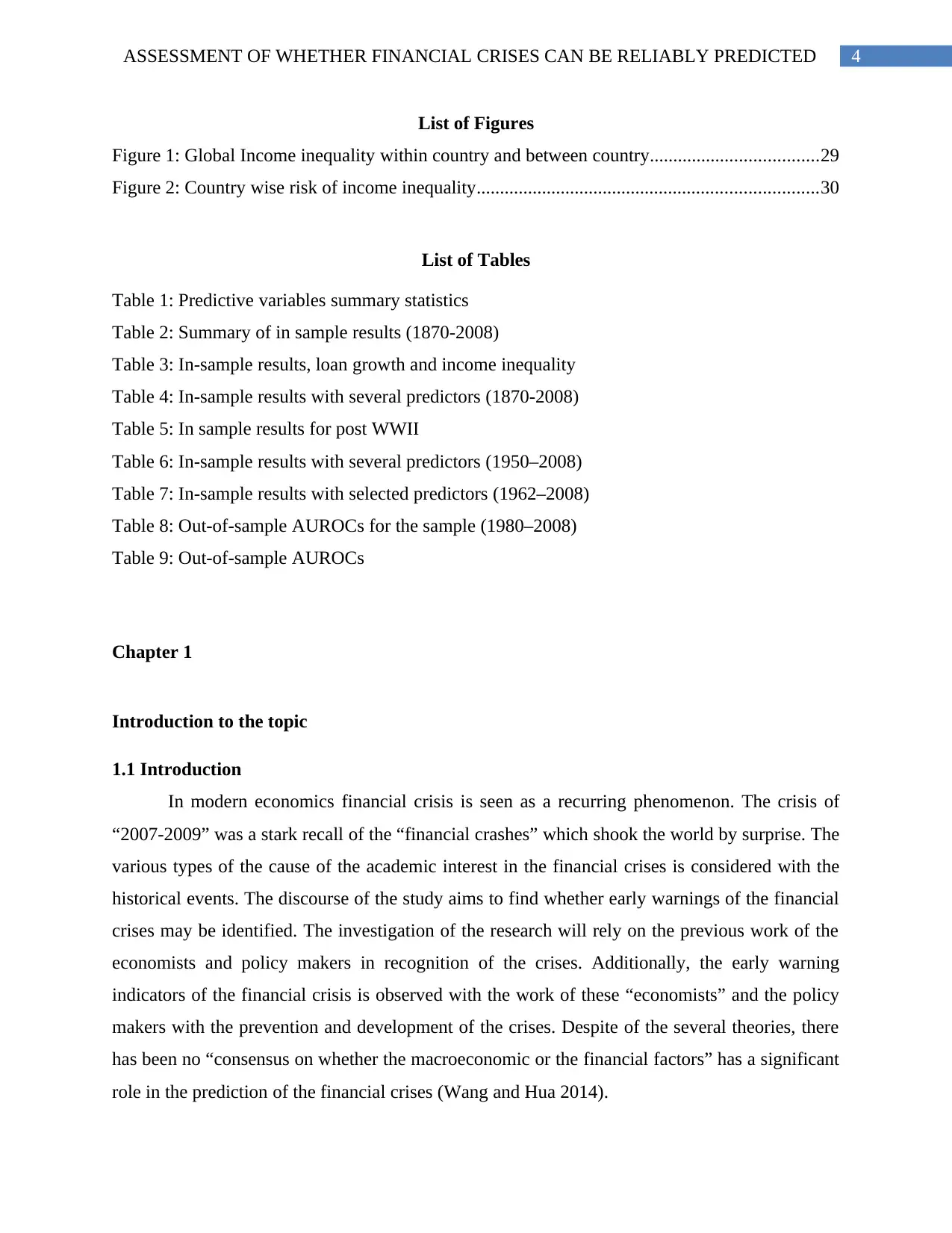
List of Figures
Figure 1: Global Income inequality within country and between country....................................29
Figure 2: Country wise risk of income inequality.........................................................................30
List of Tables
Table 1: Predictive variables summary statistics
Table 2: Summary of in sample results (1870-2008)
Table 3: In-sample results, loan growth and income inequality
Table 4: In-sample results with several predictors (1870-2008)
Table 5: In sample results for post WWII
Table 6: In-sample results with several predictors (1950–2008)
Table 7: In-sample results with selected predictors (1962–2008)
Table 8: Out-of-sample AUROCs for the sample (1980–2008)
Table 9: Out-of-sample AUROCs
Chapter 1
Introduction to the topic
1.1 Introduction
In modern economics financial crisis is seen as a recurring phenomenon. The crisis of
“2007-2009” was a stark recall of the “financial crashes” which shook the world by surprise. The
various types of the cause of the academic interest in the financial crises is considered with the
historical events. The discourse of the study aims to find whether early warnings of the financial
crises may be identified. The investigation of the research will rely on the previous work of the
economists and policy makers in recognition of the crises. Additionally, the early warning
indicators of the financial crisis is observed with the work of these “economists” and the policy
makers with the prevention and development of the crises. Despite of the several theories, there
has been no “consensus on whether the macroeconomic or the financial factors” has a significant
role in the prediction of the financial crises (Wang and Hua 2014).
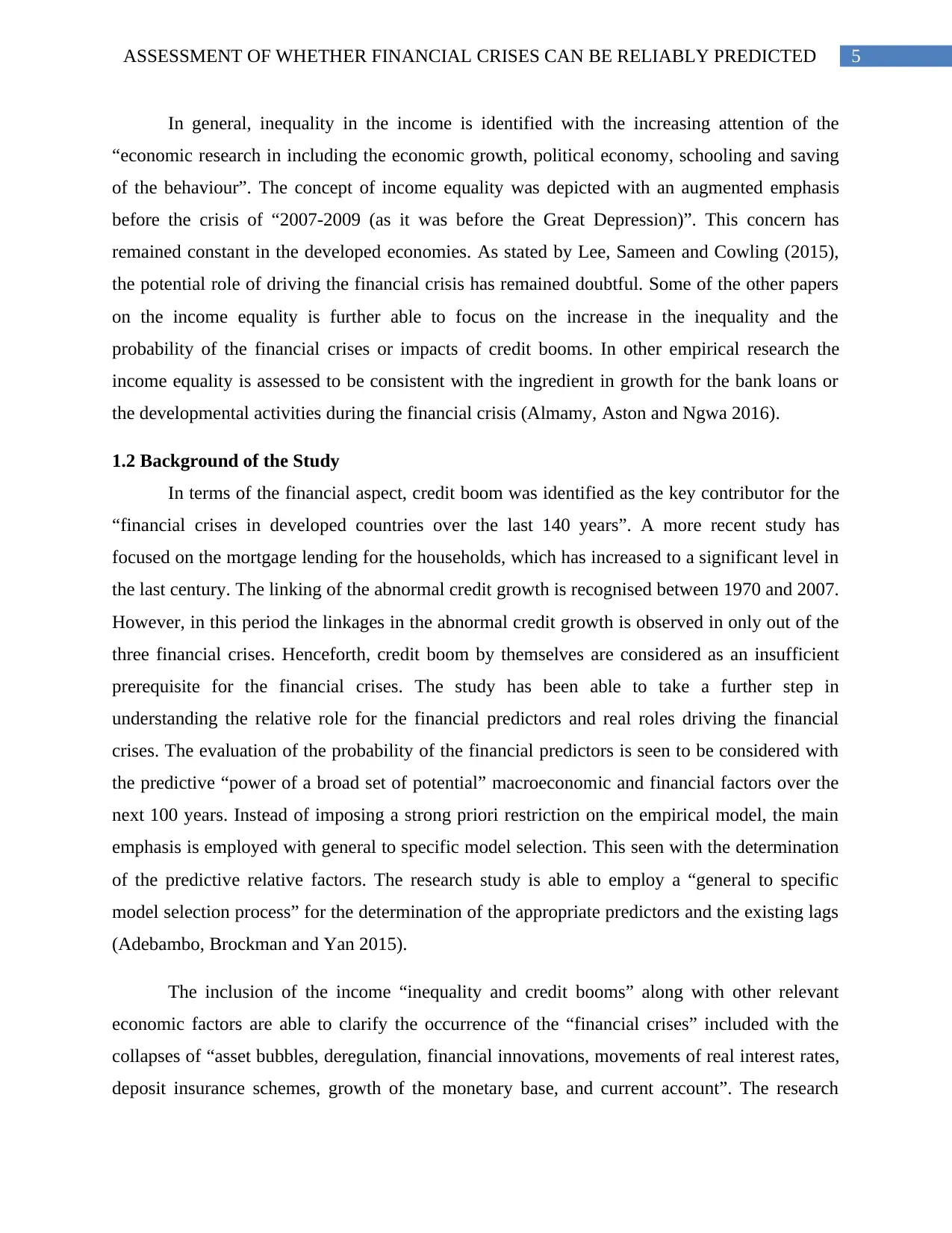
In general, inequality in the income is identified with the increasing attention of the
“economic research in including the economic growth, political economy, schooling and saving
of the behaviour”. The concept of income equality was depicted with an augmented emphasis
before the crisis of “2007-2009 (as it was before the Great Depression)”. This concern has
remained constant in the developed economies. As stated by Lee, Sameen and Cowling (2015),
the potential role of driving the financial crisis has remained doubtful. Some of the other papers
on the income equality is further able to focus on the increase in the inequality and the
probability of the financial crises or impacts of credit booms. In other empirical research the
income equality is assessed to be consistent with the ingredient in growth for the bank loans or
the developmental activities during the financial crisis (Almamy, Aston and Ngwa 2016).
1.2 Background of the Study
In terms of the financial aspect, credit boom was identified as the key contributor for the
“financial crises in developed countries over the last 140 years”. A more recent study has
focused on the mortgage lending for the households, which has increased to a significant level in
the last century. The linking of the abnormal credit growth is recognised between 1970 and 2007.
However, in this period the linkages in the abnormal credit growth is observed in only out of the
three financial crises. Henceforth, credit boom by themselves are considered as an insufficient
prerequisite for the financial crises. The study has been able to take a further step in
understanding the relative role for the financial predictors and real roles driving the financial
crises. The evaluation of the probability of the financial predictors is seen to be considered with
the predictive “power of a broad set of potential” macroeconomic and financial factors over the
next 100 years. Instead of imposing a strong priori restriction on the empirical model, the main
emphasis is employed with general to specific model selection. This seen with the determination
of the predictive relative factors. The research study is able to employ a “general to specific
model selection process” for the determination of the appropriate predictors and the existing lags
(Adebambo, Brockman and Yan 2015).
The inclusion of the income “inequality and credit booms” along with other relevant
economic factors are able to clarify the occurrence of the “financial crises” included with the
collapses of “asset bubbles, deregulation, financial innovations, movements of real interest rates,
deposit insurance schemes, growth of the monetary base, and current account”. The research
You're viewing a preview
Unlock full access by subscribing today!
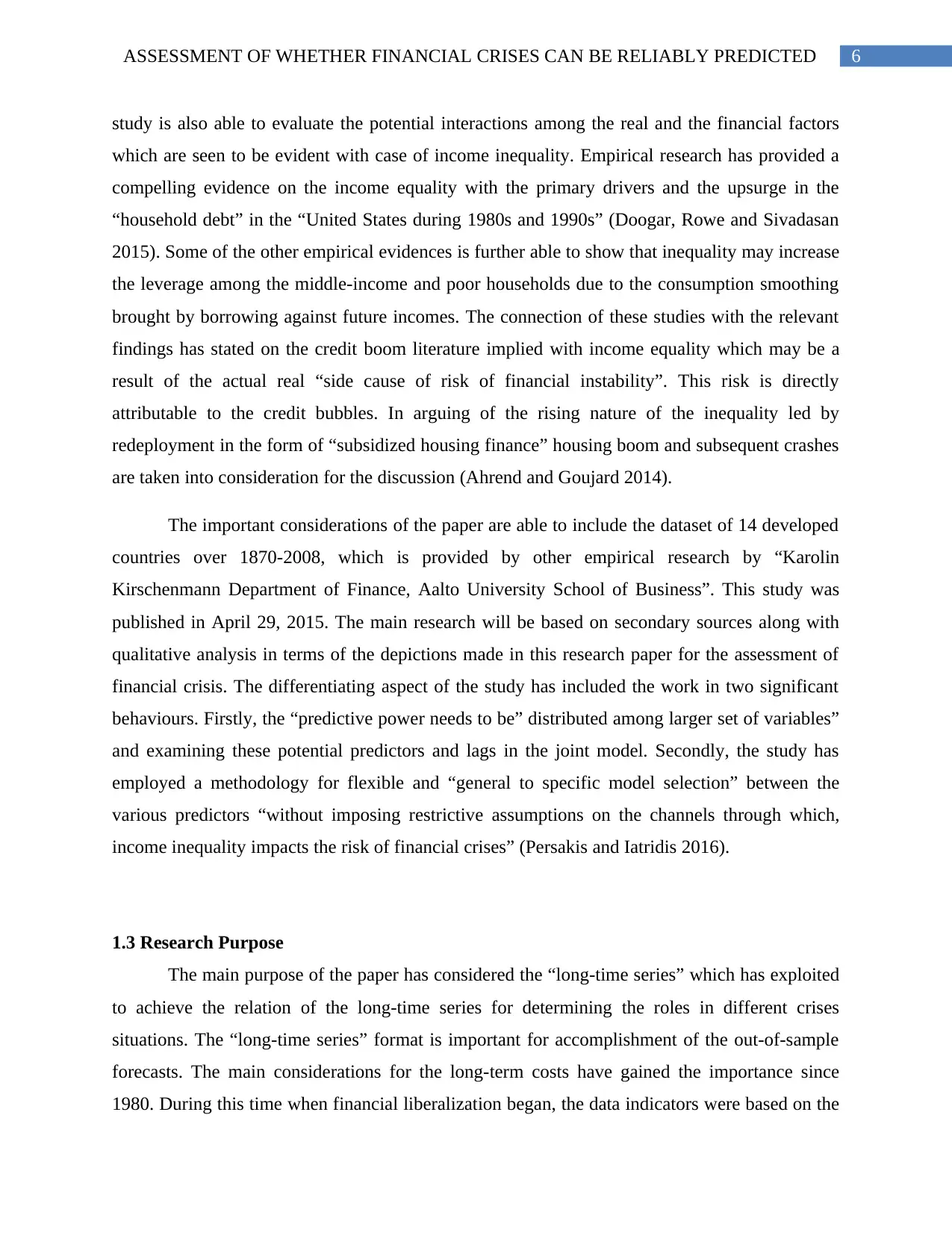
study is also able to evaluate the potential interactions among the real and the financial factors
which are seen to be evident with case of income inequality. Empirical research has provided a
compelling evidence on the income equality with the primary drivers and the upsurge in the
“household debt” in the “United States during 1980s and 1990s” (Doogar, Rowe and Sivadasan
2015). Some of the other empirical evidences is further able to show that inequality may increase
the leverage among the middle-income and poor households due to the consumption smoothing
brought by borrowing against future incomes. The connection of these studies with the relevant
findings has stated on the credit boom literature implied with income equality which may be a
result of the actual real “side cause of risk of financial instability”. This risk is directly
attributable to the credit bubbles. In arguing of the rising nature of the inequality led by
redeployment in the form of “subsidized housing finance” housing boom and subsequent crashes
are taken into consideration for the discussion (Ahrend and Goujard 2014).
The important considerations of the paper are able to include the dataset of 14 developed
countries over 1870-2008, which is provided by other empirical research by “Karolin
Kirschenmann Department of Finance, Aalto University School of Business”. This study was
published in April 29, 2015. The main research will be based on secondary sources along with
qualitative analysis in terms of the depictions made in this research paper for the assessment of
financial crisis. The differentiating aspect of the study has included the work in two significant
behaviours. Firstly, the “predictive power needs to be” distributed among larger set of variables”
and examining these potential predictors and lags in the joint model. Secondly, the study has
employed a methodology for flexible and “general to specific model selection” between the
various predictors “without imposing restrictive assumptions on the channels through which,
income inequality impacts the risk of financial crises” (Persakis and Iatridis 2016).
1.3 Research Purpose
The main purpose of the paper has considered the “long-time series” which has exploited
to achieve the relation of the long-time series for determining the roles in different crises
situations. The “long-time series” format is important for accomplishment of the out-of-sample
forecasts. The main considerations for the long-term costs have gained the importance since
1980. During this time when financial liberalization began, the data indicators were based on the
Paraphrase This Document
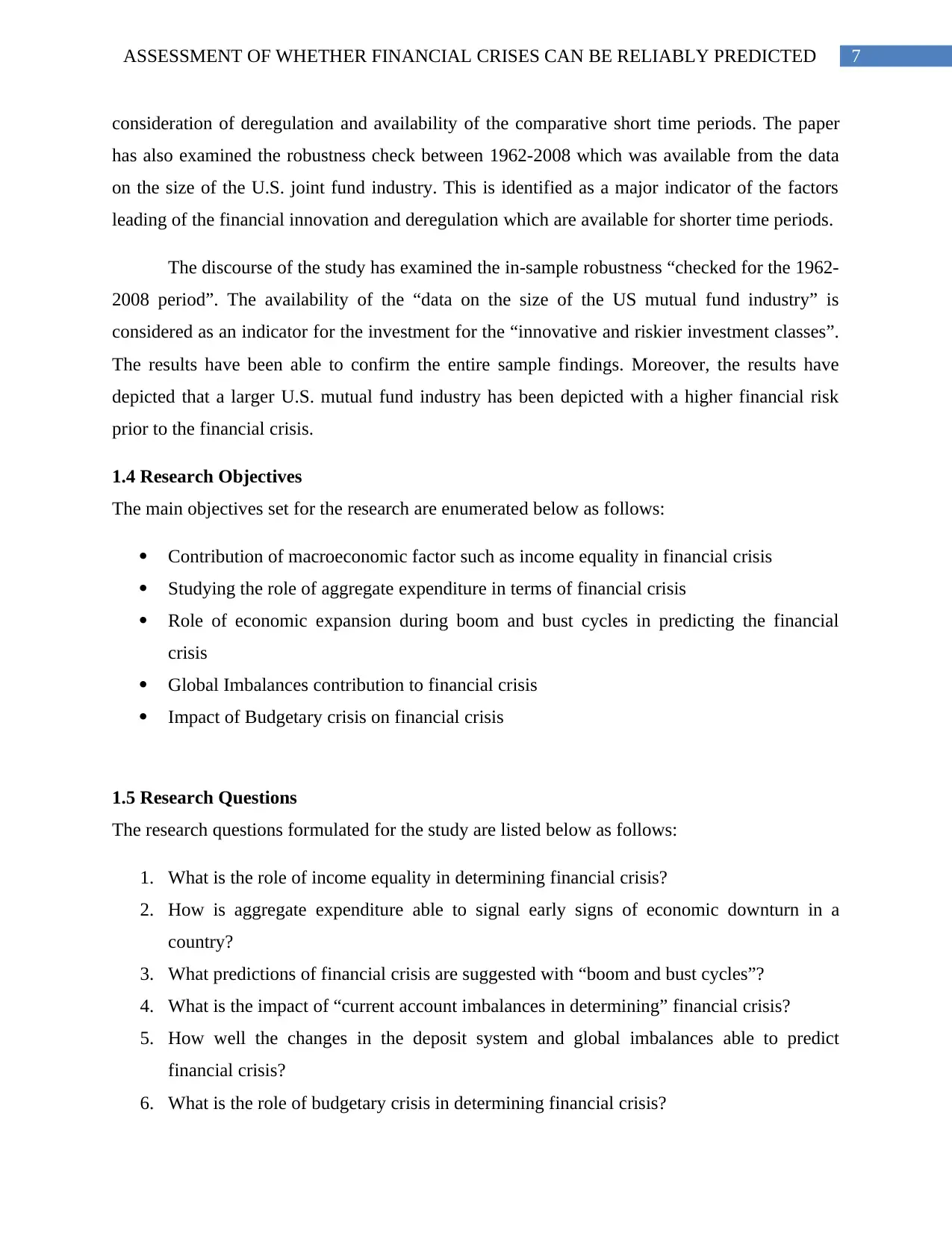
consideration of deregulation and availability of the comparative short time periods. The paper
has also examined the robustness check between 1962-2008 which was available from the data
on the size of the U.S. joint fund industry. This is identified as a major indicator of the factors
leading of the financial innovation and deregulation which are available for shorter time periods.
The discourse of the study has examined the in-sample robustness “checked for the 1962-
2008 period”. The availability of the “data on the size of the US mutual fund industry” is
considered as an indicator for the investment for the “innovative and riskier investment classes”.
The results have been able to confirm the entire sample findings. Moreover, the results have
depicted that a larger U.S. mutual fund industry has been depicted with a higher financial risk
prior to the financial crisis.
1.4 Research Objectives
The main objectives set for the research are enumerated below as follows:
Contribution of macroeconomic factor such as income equality in financial crisis
Studying the role of aggregate expenditure in terms of financial crisis
Role of economic expansion during boom and bust cycles in predicting the financial
crisis
Global Imbalances contribution to financial crisis
Impact of Budgetary crisis on financial crisis
1.5 Research Questions
The research questions formulated for the study are listed below as follows:
1. What is the role of income equality in determining financial crisis?
2. How is aggregate expenditure able to signal early signs of economic downturn in a
country?
3. What predictions of financial crisis are suggested with “boom and bust cycles”?
4. What is the impact of “current account imbalances in determining” financial crisis?
5. How well the changes in the deposit system and global imbalances able to predict
financial crisis?
6. What is the role of budgetary crisis in determining financial crisis?
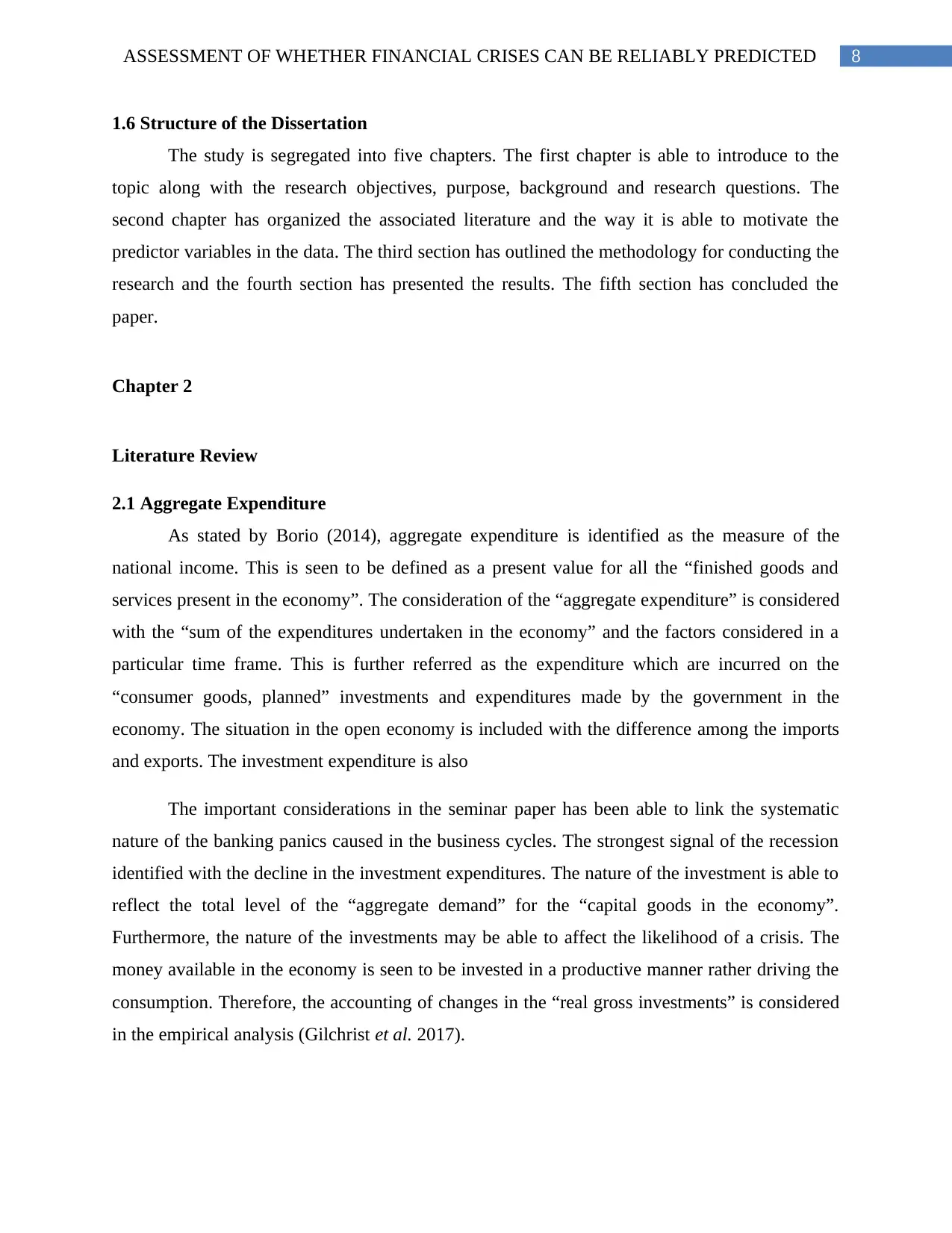
1.6 Structure of the Dissertation
The study is segregated into five chapters. The first chapter is able to introduce to the
topic along with the research objectives, purpose, background and research questions. The
second chapter has organized the associated literature and the way it is able to motivate the
predictor variables in the data. The third section has outlined the methodology for conducting the
research and the fourth section has presented the results. The fifth section has concluded the
paper.
Chapter 2
Literature Review
2.1 Aggregate Expenditure
As stated by Borio (2014), aggregate expenditure is identified as the measure of the
national income. This is seen to be defined as a present value for all the “finished goods and
services present in the economy”. The consideration of the “aggregate expenditure” is considered
with the “sum of the expenditures undertaken in the economy” and the factors considered in a
particular time frame. This is further referred as the expenditure which are incurred on the
“consumer goods, planned” investments and expenditures made by the government in the
economy. The situation in the open economy is included with the difference among the imports
and exports. The investment expenditure is also
The important considerations in the seminar paper has been able to link the systematic
nature of the banking panics caused in the business cycles. The strongest signal of the recession
identified with the decline in the investment expenditures. The nature of the investment is able to
reflect the total level of the “aggregate demand” for the “capital goods in the economy”.
Furthermore, the nature of the investments may be able to affect the likelihood of a crisis. The
money available in the economy is seen to be invested in a productive manner rather driving the
consumption. Therefore, the accounting of changes in the “real gross investments” is considered
in the empirical analysis (Gilchrist et al. 2017).
You're viewing a preview
Unlock full access by subscribing today!
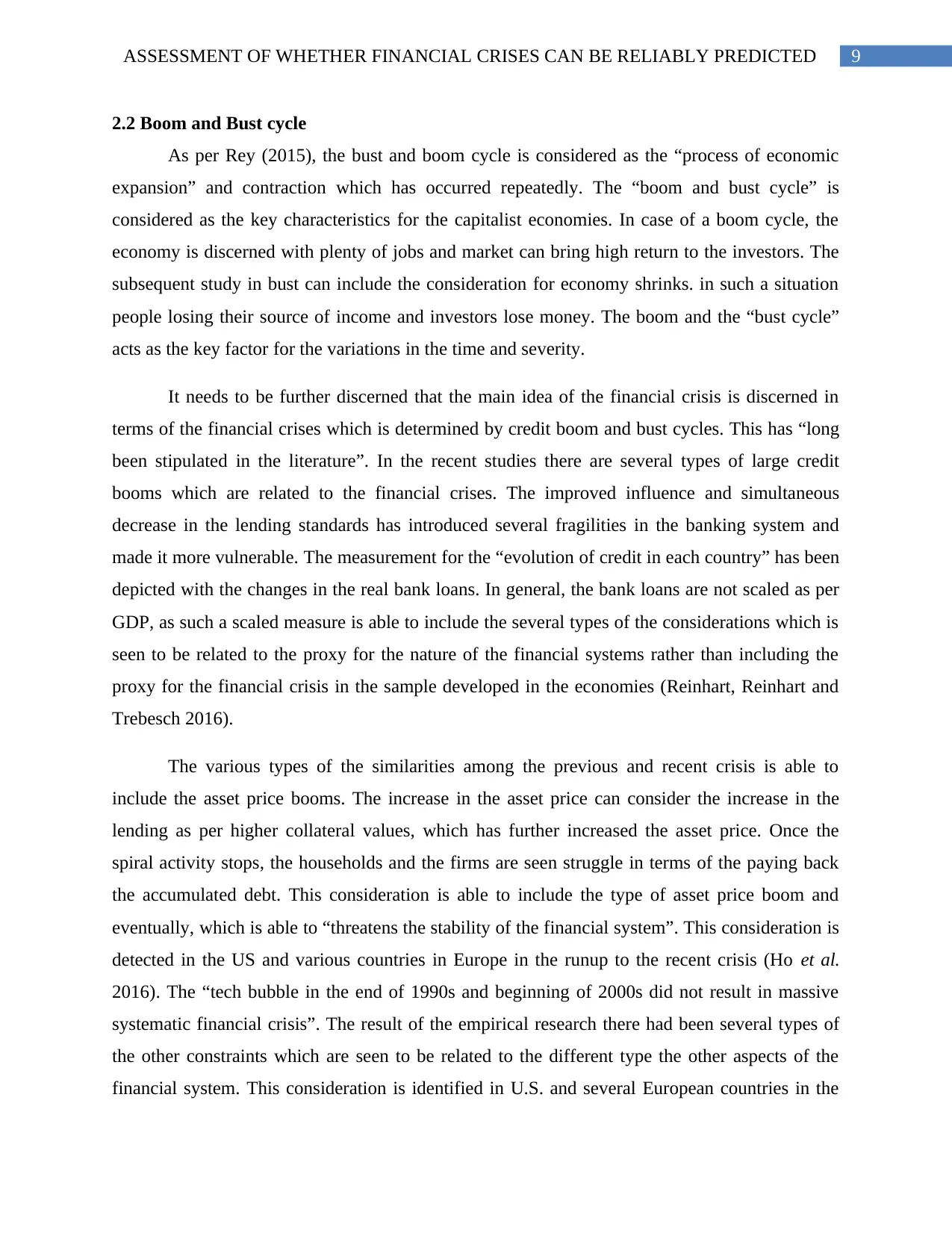
2.2 Boom and Bust cycle
As per Rey (2015), the bust and boom cycle is considered as the “process of economic
expansion” and contraction which has occurred repeatedly. The “boom and bust cycle” is
considered as the key characteristics for the capitalist economies. In case of a boom cycle, the
economy is discerned with plenty of jobs and market can bring high return to the investors. The
subsequent study in bust can include the consideration for economy shrinks. in such a situation
people losing their source of income and investors lose money. The boom and the “bust cycle”
acts as the key factor for the variations in the time and severity.
It needs to be further discerned that the main idea of the financial crisis is discerned in
terms of the financial crises which is determined by credit boom and bust cycles. This has “long
been stipulated in the literature”. In the recent studies there are several types of large credit
booms which are related to the financial crises. The improved influence and simultaneous
decrease in the lending standards has introduced several fragilities in the banking system and
made it more vulnerable. The measurement for the “evolution of credit in each country” has been
depicted with the changes in the real bank loans. In general, the bank loans are not scaled as per
GDP, as such a scaled measure is able to include the several types of the considerations which is
seen to be related to the proxy for the nature of the financial systems rather than including the
proxy for the financial crisis in the sample developed in the economies (Reinhart, Reinhart and
Trebesch 2016).
The various types of the similarities among the previous and recent crisis is able to
include the asset price booms. The increase in the asset price can consider the increase in the
lending as per higher collateral values, which has further increased the asset price. Once the
spiral activity stops, the households and the firms are seen struggle in terms of the paying back
the accumulated debt. This consideration is able to include the type of asset price boom and
eventually, which is able to “threatens the stability of the financial system”. This consideration is
detected in the US and various countries in Europe in the runup to the recent crisis (Ho et al.
2016). The “tech bubble in the end of 1990s and beginning of 2000s did not result in massive
systematic financial crisis”. The result of the empirical research there had been several types of
the other constraints which are seen to be related to the different type the other aspects of the
financial system. This consideration is identified in U.S. and several European countries in the
Paraphrase This Document
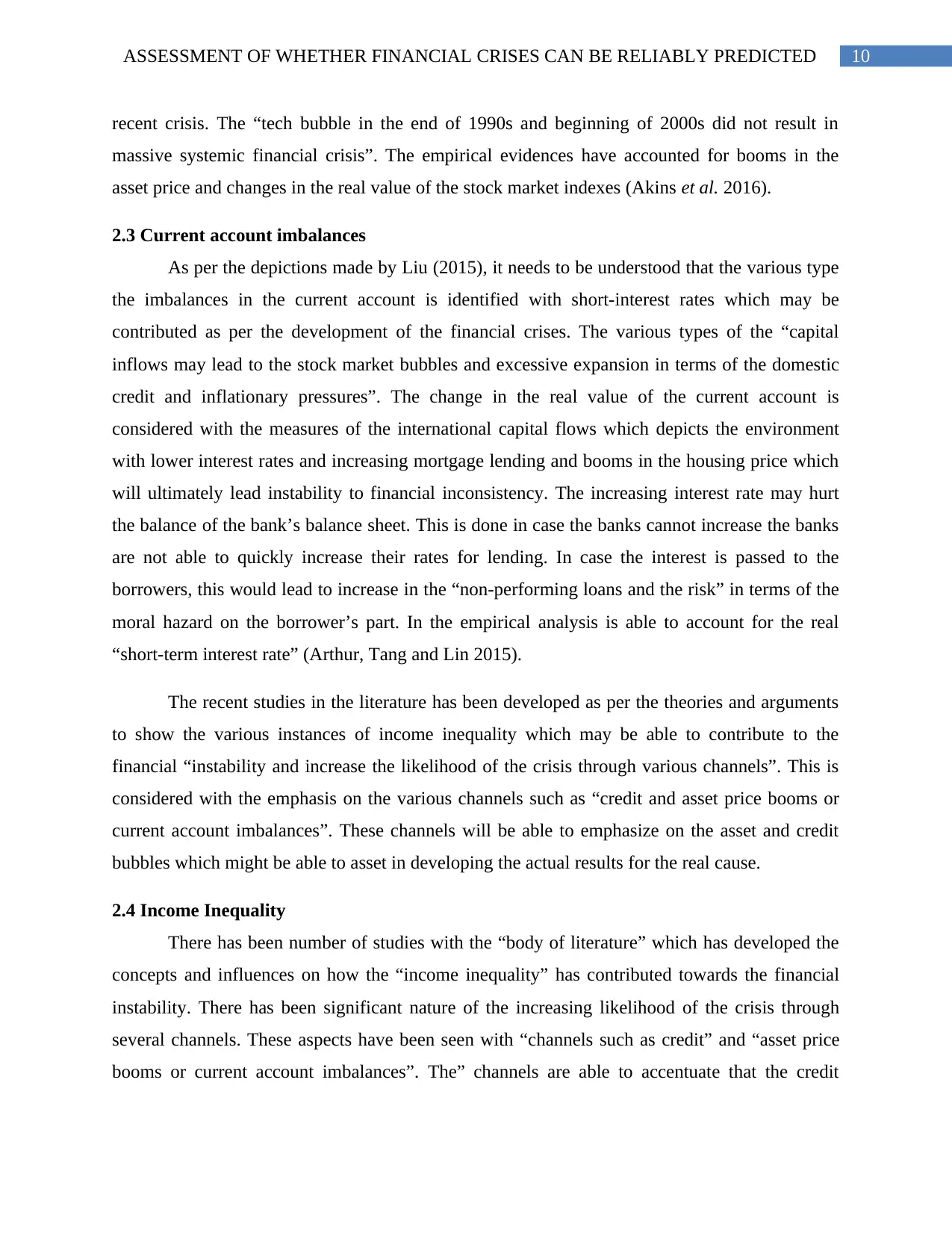
recent crisis. The “tech bubble in the end of 1990s and beginning of 2000s did not result in
massive systemic financial crisis”. The empirical evidences have accounted for booms in the
asset price and changes in the real value of the stock market indexes (Akins et al. 2016).
2.3 Current account imbalances
As per the depictions made by Liu (2015), it needs to be understood that the various type
the imbalances in the current account is identified with short-interest rates which may be
contributed as per the development of the financial crises. The various types of the “capital
inflows may lead to the stock market bubbles and excessive expansion in terms of the domestic
credit and inflationary pressures”. The change in the real value of the current account is
considered with the measures of the international capital flows which depicts the environment
with lower interest rates and increasing mortgage lending and booms in the housing price which
will ultimately lead instability to financial inconsistency. The increasing interest rate may hurt
the balance of the bank’s balance sheet. This is done in case the banks cannot increase the banks
are not able to quickly increase their rates for lending. In case the interest is passed to the
borrowers, this would lead to increase in the “non-performing loans and the risk” in terms of the
moral hazard on the borrower’s part. In the empirical analysis is able to account for the real
“short-term interest rate” (Arthur, Tang and Lin 2015).
The recent studies in the literature has been developed as per the theories and arguments
to show the various instances of income inequality which may be able to contribute to the
financial “instability and increase the likelihood of the crisis through various channels”. This is
considered with the emphasis on the various channels such as “credit and asset price booms or
current account imbalances”. These channels will be able to emphasize on the asset and credit
bubbles which might be able to asset in developing the actual results for the real cause.
2.4 Income Inequality
There has been number of studies with the “body of literature” which has developed the
concepts and influences on how the “income inequality” has contributed towards the financial
instability. There has been significant nature of the increasing likelihood of the crisis through
several channels. These aspects have been seen with “channels such as credit” and “asset price
booms or current account imbalances”. The” channels are able to accentuate that the credit
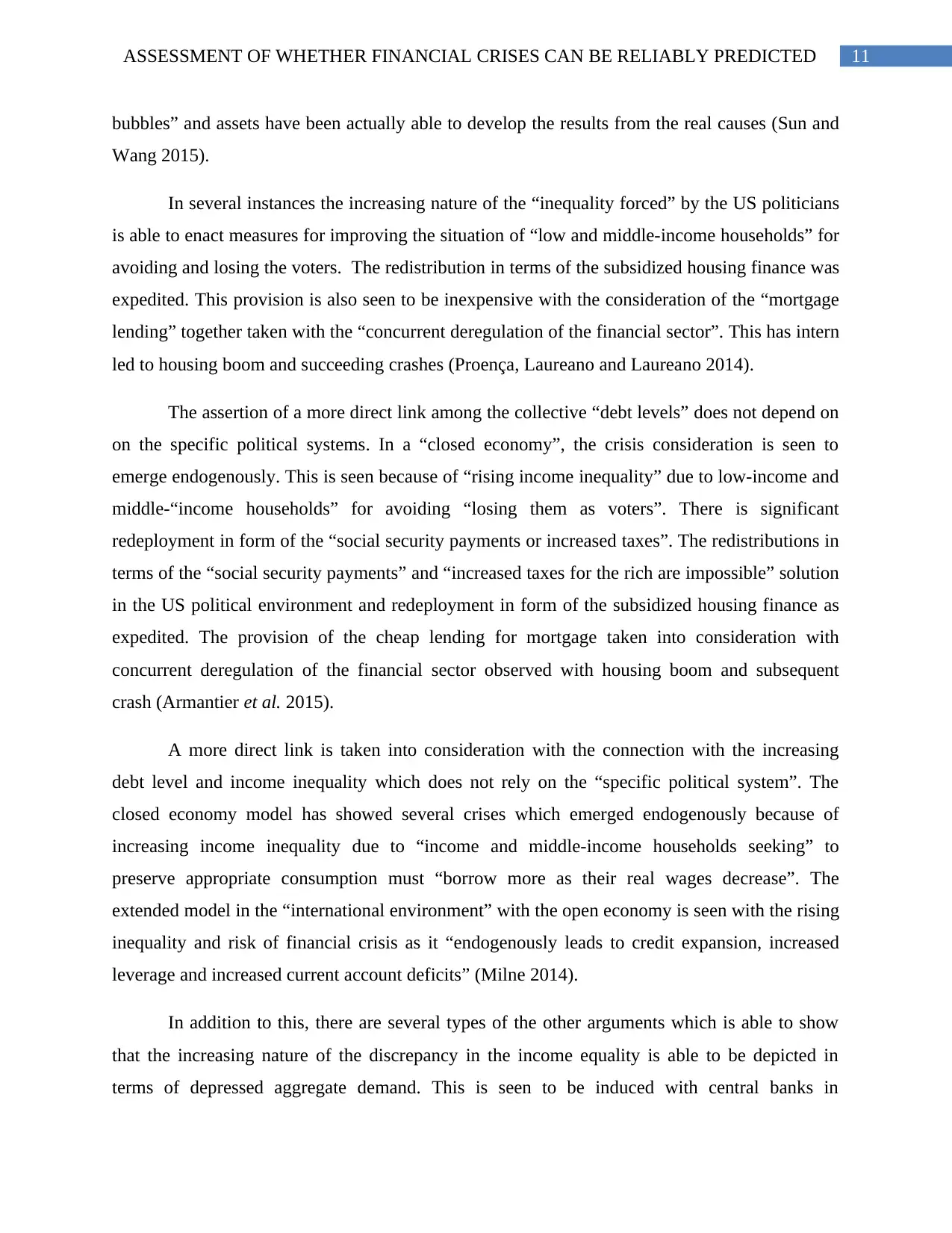
bubbles” and assets have been actually able to develop the results from the real causes (Sun and
Wang 2015).
In several instances the increasing nature of the “inequality forced” by the US politicians
is able to enact measures for improving the situation of “low and middle-income households” for
avoiding and losing the voters. The redistribution in terms of the subsidized housing finance was
expedited. This provision is also seen to be inexpensive with the consideration of the “mortgage
lending” together taken with the “concurrent deregulation of the financial sector”. This has intern
led to housing boom and succeeding crashes (Proença, Laureano and Laureano 2014).
The assertion of a more direct link among the collective “debt levels” does not depend on
on the specific political systems. In a “closed economy”, the crisis consideration is seen to
emerge endogenously. This is seen because of “rising income inequality” due to low-income and
middle-“income households” for avoiding “losing them as voters”. There is significant
redeployment in form of the “social security payments or increased taxes”. The redistributions in
terms of the “social security payments” and “increased taxes for the rich are impossible” solution
in the US political environment and redeployment in form of the subsidized housing finance as
expedited. The provision of the cheap lending for mortgage taken into consideration with
concurrent deregulation of the financial sector observed with housing boom and subsequent
crash (Armantier et al. 2015).
A more direct link is taken into consideration with the connection with the increasing
debt level and income inequality which does not rely on the “specific political system”. The
closed economy model has showed several crises which emerged endogenously because of
increasing income inequality due to “income and middle-income households seeking” to
preserve appropriate consumption must “borrow more as their real wages decrease”. The
extended model in the “international environment” with the open economy is seen with the rising
inequality and risk of financial crisis as it “endogenously leads to credit expansion, increased
leverage and increased current account deficits” (Milne 2014).
In addition to this, there are several types of the other arguments which is able to show
that the increasing nature of the discrepancy in the income equality is able to be depicted in
terms of depressed aggregate demand. This is seen to be induced with central banks in
You're viewing a preview
Unlock full access by subscribing today!
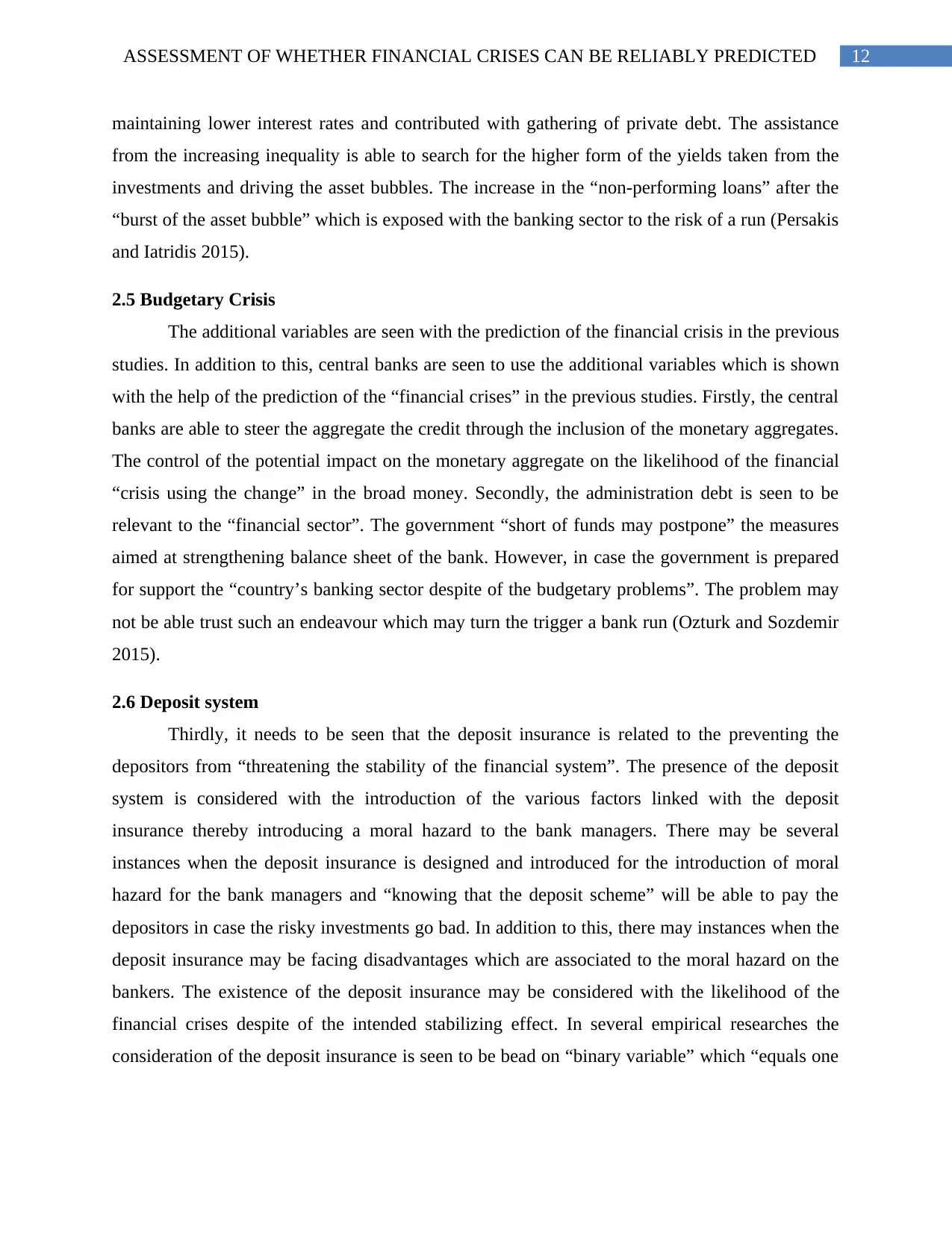
maintaining lower interest rates and contributed with gathering of private debt. The assistance
from the increasing inequality is able to search for the higher form of the yields taken from the
investments and driving the asset bubbles. The increase in the “non-performing loans” after the
“burst of the asset bubble” which is exposed with the banking sector to the risk of a run (Persakis
and Iatridis 2015).
2.5 Budgetary Crisis
The additional variables are seen with the prediction of the financial crisis in the previous
studies. In addition to this, central banks are seen to use the additional variables which is shown
with the help of the prediction of the “financial crises” in the previous studies. Firstly, the central
banks are able to steer the aggregate the credit through the inclusion of the monetary aggregates.
The control of the potential impact on the monetary aggregate on the likelihood of the financial
“crisis using the change” in the broad money. Secondly, the administration debt is seen to be
relevant to the “financial sector”. The government “short of funds may postpone” the measures
aimed at strengthening balance sheet of the bank. However, in case the government is prepared
for support the “country’s banking sector despite of the budgetary problems”. The problem may
not be able trust such an endeavour which may turn the trigger a bank run (Ozturk and Sozdemir
2015).
2.6 Deposit system
Thirdly, it needs to be seen that the deposit insurance is related to the preventing the
depositors from “threatening the stability of the financial system”. The presence of the deposit
system is considered with the introduction of the various factors linked with the deposit
insurance thereby introducing a moral hazard to the bank managers. There may be several
instances when the deposit insurance is designed and introduced for the introduction of moral
hazard for the bank managers and “knowing that the deposit scheme” will be able to pay the
depositors in case the risky investments go bad. In addition to this, there may instances when the
deposit insurance may be facing disadvantages which are associated to the moral hazard on the
bankers. The existence of the deposit insurance may be considered with the likelihood of the
financial crises despite of the intended stabilizing effect. In several empirical researches the
consideration of the deposit insurance is seen to be bead on “binary variable” which “equals one
Paraphrase This Document
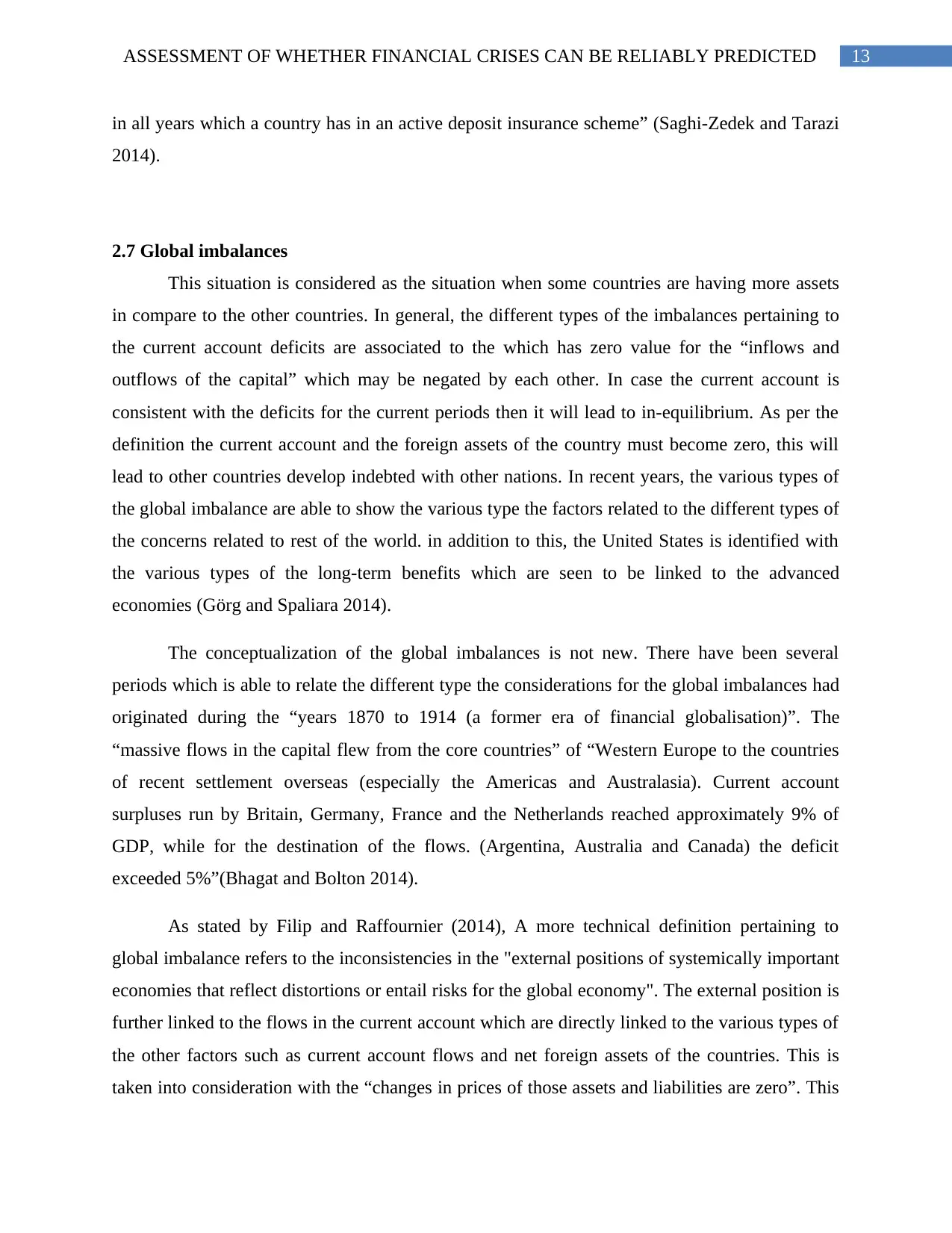
in all years which a country has in an active deposit insurance scheme” (Saghi-Zedek and Tarazi
2014).
2.7 Global imbalances
This situation is considered as the situation when some countries are having more assets
in compare to the other countries. In general, the different types of the imbalances pertaining to
the current account deficits are associated to the which has zero value for the “inflows and
outflows of the capital” which may be negated by each other. In case the current account is
consistent with the deficits for the current periods then it will lead to in-equilibrium. As per the
definition the current account and the foreign assets of the country must become zero, this will
lead to other countries develop indebted with other nations. In recent years, the various types of
the global imbalance are able to show the various type the factors related to the different types of
the concerns related to rest of the world. in addition to this, the United States is identified with
the various types of the long-term benefits which are seen to be linked to the advanced
economies (Görg and Spaliara 2014).
The conceptualization of the global imbalances is not new. There have been several
periods which is able to relate the different type the considerations for the global imbalances had
originated during the “years 1870 to 1914 (a former era of financial globalisation)”. The
“massive flows in the capital flew from the core countries” of “Western Europe to the countries
of recent settlement overseas (especially the Americas and Australasia). Current account
surpluses run by Britain, Germany, France and the Netherlands reached approximately 9% of
GDP, while for the destination of the flows. (Argentina, Australia and Canada) the deficit
exceeded 5%”(Bhagat and Bolton 2014).
As stated by Filip and Raffournier (2014), A more technical definition pertaining to
global imbalance refers to the inconsistencies in the "external positions of systemically important
economies that reflect distortions or entail risks for the global economy". The external position is
further linked to the flows in the current account which are directly linked to the various types of
the other factors such as current account flows and net foreign assets of the countries. This is
taken into consideration with the “changes in prices of those assets and liabilities are zero”. This
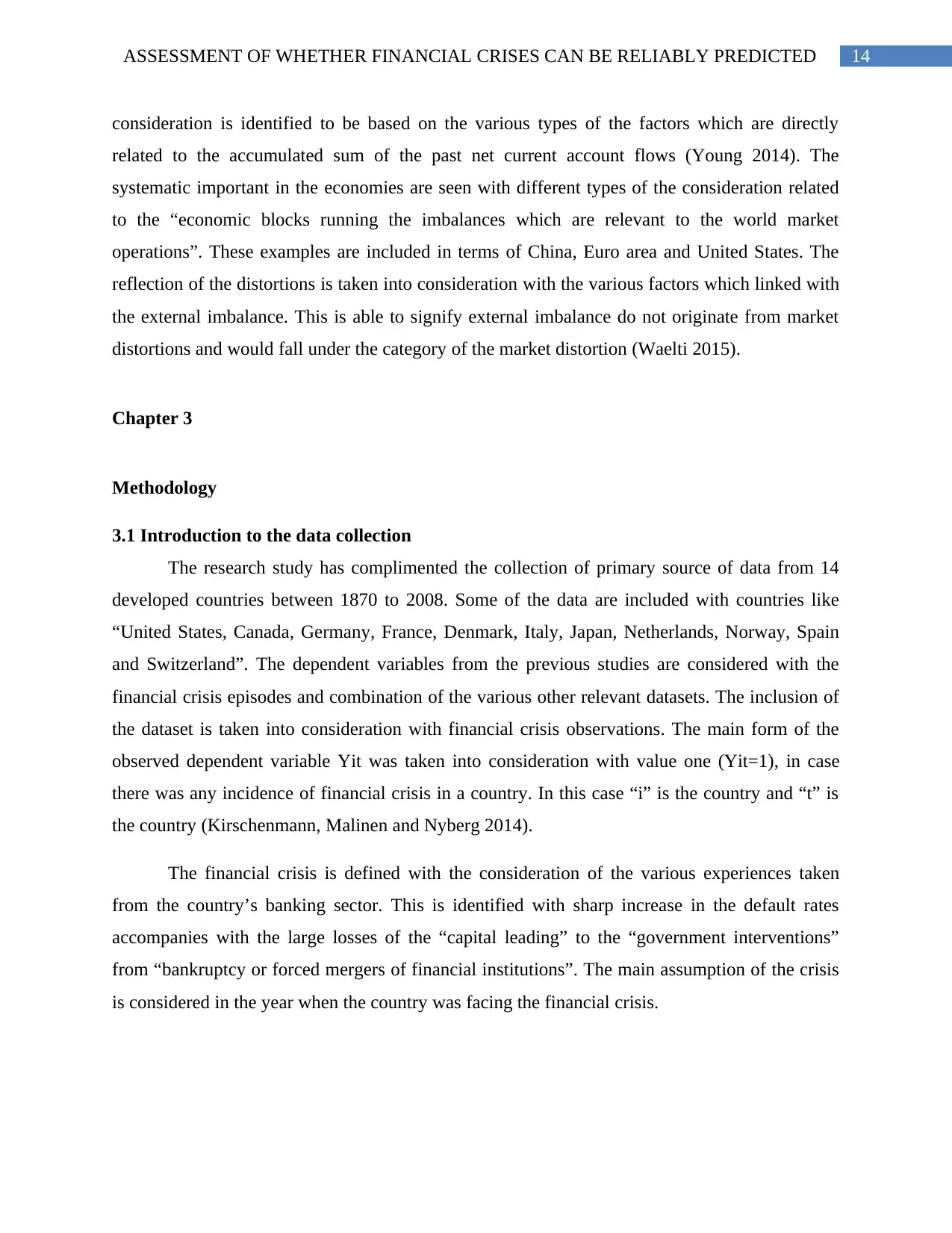
consideration is identified to be based on the various types of the factors which are directly
related to the accumulated sum of the past net current account flows (Young 2014). The
systematic important in the economies are seen with different types of the consideration related
to the “economic blocks running the imbalances which are relevant to the world market
operations”. These examples are included in terms of China, Euro area and United States. The
reflection of the distortions is taken into consideration with the various factors which linked with
the external imbalance. This is able to signify external imbalance do not originate from market
distortions and would fall under the category of the market distortion (Waelti 2015).
Chapter 3
Methodology
3.1 Introduction to the data collection
The research study has complimented the collection of primary source of data from 14
developed countries between 1870 to 2008. Some of the data are included with countries like
“United States, Canada, Germany, France, Denmark, Italy, Japan, Netherlands, Norway, Spain
and Switzerland”. The dependent variables from the previous studies are considered with the
financial crisis episodes and combination of the various other relevant datasets. The inclusion of
the dataset is taken into consideration with financial crisis observations. The main form of the
observed dependent variable Yit was taken into consideration with value one (Yit=1), in case
there was any incidence of financial crisis in a country. In this case “i” is the country and “t” is
the country (Kirschenmann, Malinen and Nyberg 2014).
The financial crisis is defined with the consideration of the various experiences taken
from the country’s banking sector. This is identified with sharp increase in the default rates
accompanies with the large losses of the “capital leading” to the “government interventions”
from “bankruptcy or forced mergers of financial institutions”. The main assumption of the crisis
is considered in the year when the country was facing the financial crisis.
You're viewing a preview
Unlock full access by subscribing today!
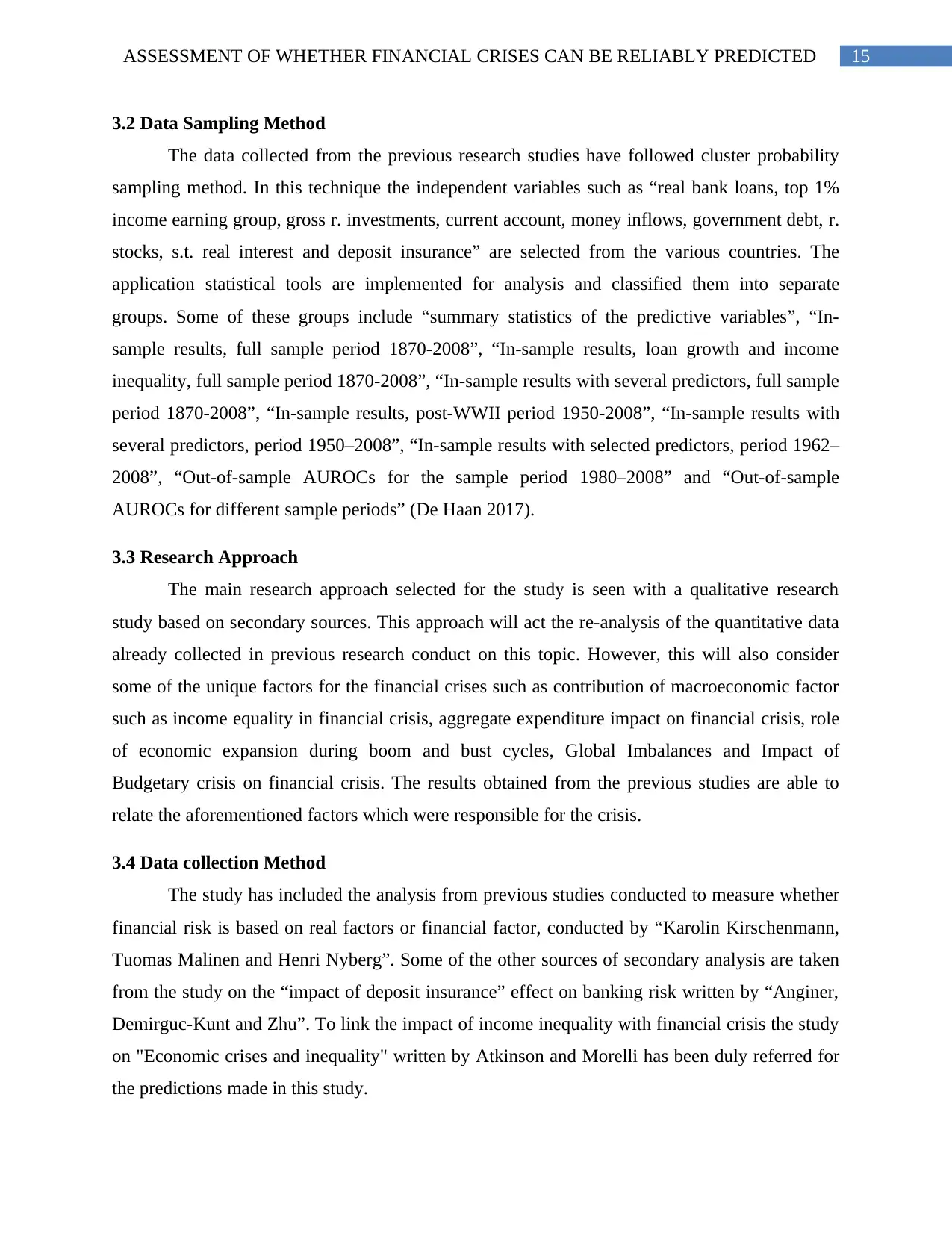
3.2 Data Sampling Method
The data collected from the previous research studies have followed cluster probability
sampling method. In this technique the independent variables such as “real bank loans, top 1%
income earning group, gross r. investments, current account, money inflows, government debt, r.
stocks, s.t. real interest and deposit insurance” are selected from the various countries. The
application statistical tools are implemented for analysis and classified them into separate
groups. Some of these groups include “summary statistics of the predictive variables”, “In-
sample results, full sample period 1870-2008”, “In-sample results, loan growth and income
inequality, full sample period 1870-2008”, “In-sample results with several predictors, full sample
period 1870-2008”, “In-sample results, post-WWII period 1950-2008”, “In-sample results with
several predictors, period 1950–2008”, “In-sample results with selected predictors, period 1962–
2008”, “Out-of-sample AUROCs for the sample period 1980–2008” and “Out-of-sample
AUROCs for different sample periods” (De Haan 2017).
3.3 Research Approach
The main research approach selected for the study is seen with a qualitative research
study based on secondary sources. This approach will act the re-analysis of the quantitative data
already collected in previous research conduct on this topic. However, this will also consider
some of the unique factors for the financial crises such as contribution of macroeconomic factor
such as income equality in financial crisis, aggregate expenditure impact on financial crisis, role
of economic expansion during boom and bust cycles, Global Imbalances and Impact of
Budgetary crisis on financial crisis. The results obtained from the previous studies are able to
relate the aforementioned factors which were responsible for the crisis.
3.4 Data collection Method
The study has included the analysis from previous studies conducted to measure whether
financial risk is based on real factors or financial factor, conducted by “Karolin Kirschenmann,
Tuomas Malinen and Henri Nyberg”. Some of the other sources of secondary analysis are taken
from the study on the “impact of deposit insurance” effect on banking risk written by “Anginer,
Demirguc-Kunt and Zhu”. To link the impact of income inequality with financial crisis the study
on "Economic crises and inequality" written by Atkinson and Morelli has been duly referred for
the predictions made in this study.
Paraphrase This Document
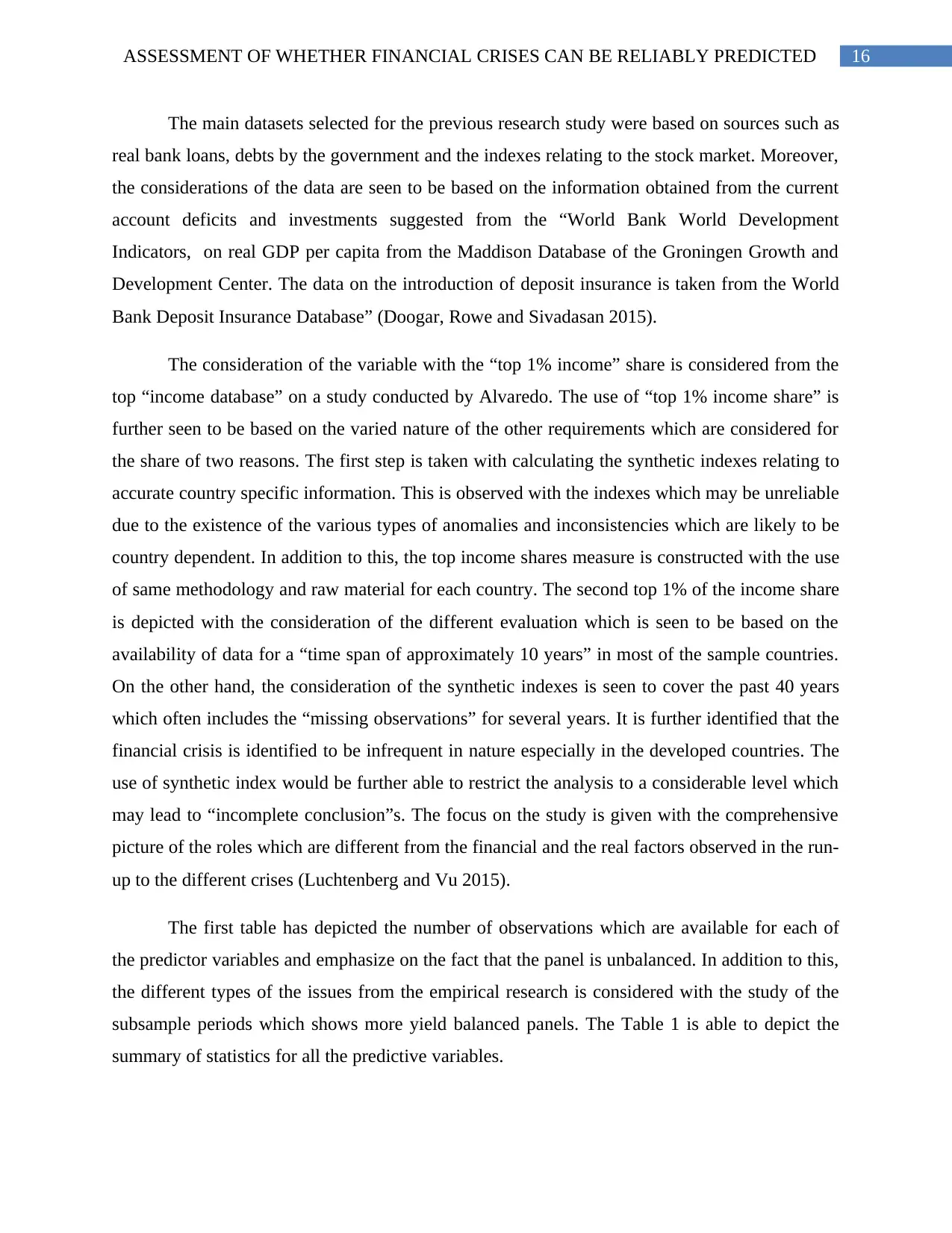
The main datasets selected for the previous research study were based on sources such as
real bank loans, debts by the government and the indexes relating to the stock market. Moreover,
the considerations of the data are seen to be based on the information obtained from the current
account deficits and investments suggested from the “World Bank World Development
Indicators, on real GDP per capita from the Maddison Database of the Groningen Growth and
Development Center. The data on the introduction of deposit insurance is taken from the World
Bank Deposit Insurance Database” (Doogar, Rowe and Sivadasan 2015).
The consideration of the variable with the “top 1% income” share is considered from the
top “income database” on a study conducted by Alvaredo. The use of “top 1% income share” is
further seen to be based on the varied nature of the other requirements which are considered for
the share of two reasons. The first step is taken with calculating the synthetic indexes relating to
accurate country specific information. This is observed with the indexes which may be unreliable
due to the existence of the various types of anomalies and inconsistencies which are likely to be
country dependent. In addition to this, the top income shares measure is constructed with the use
of same methodology and raw material for each country. The second top 1% of the income share
is depicted with the consideration of the different evaluation which is seen to be based on the
availability of data for a “time span of approximately 10 years” in most of the sample countries.
On the other hand, the consideration of the synthetic indexes is seen to cover the past 40 years
which often includes the “missing observations” for several years. It is further identified that the
financial crisis is identified to be infrequent in nature especially in the developed countries. The
use of synthetic index would be further able to restrict the analysis to a considerable level which
may lead to “incomplete conclusion”s. The focus on the study is given with the comprehensive
picture of the roles which are different from the financial and the real factors observed in the run-
up to the different crises (Luchtenberg and Vu 2015).
The first table has depicted the number of observations which are available for each of
the predictor variables and emphasize on the fact that the panel is unbalanced. In addition to this,
the different types of the issues from the empirical research is considered with the study of the
subsample periods which shows more yield balanced panels. The Table 1 is able to depict the
summary of statistics for all the predictive variables.
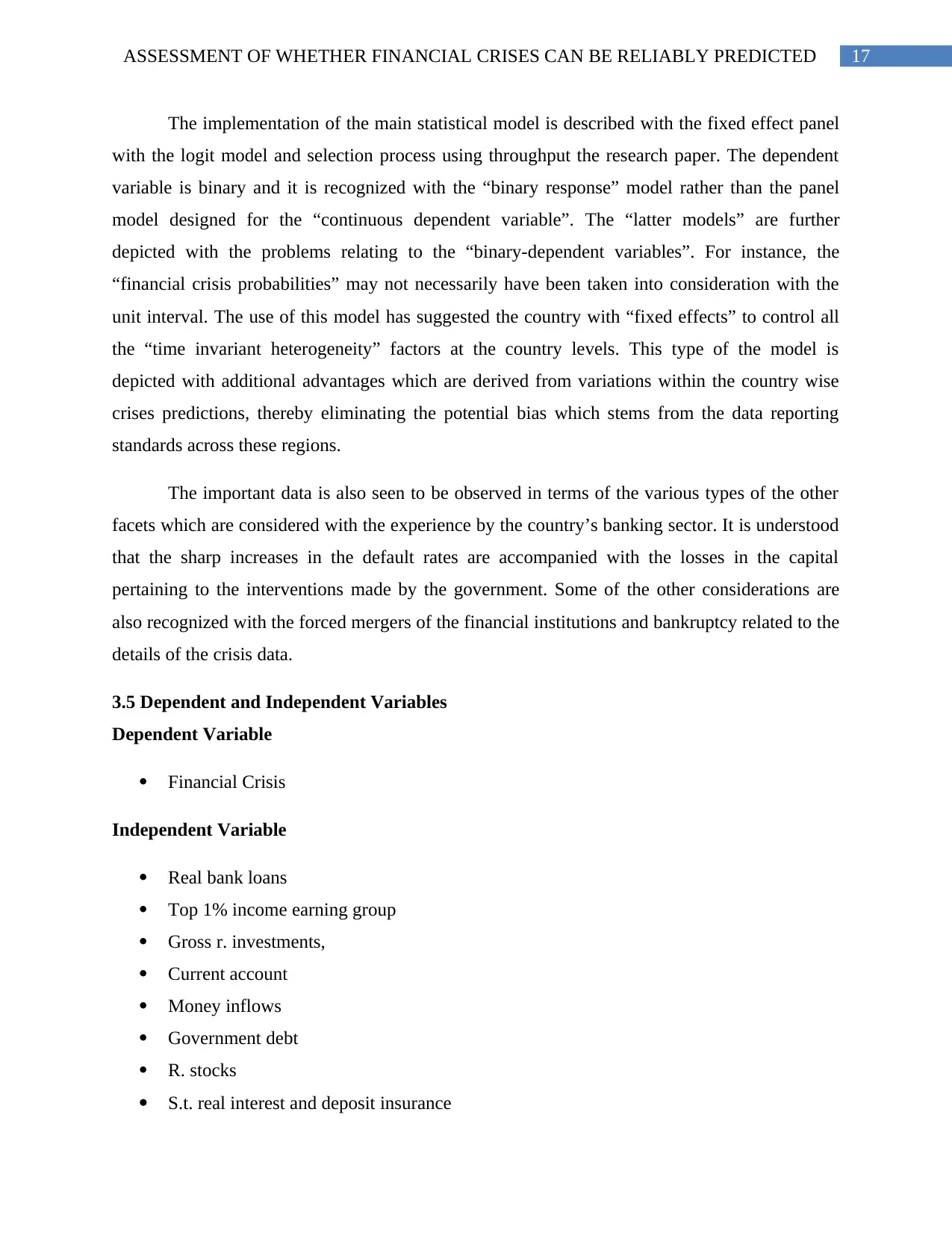
The implementation of the main statistical model is described with the fixed effect panel
with the logit model and selection process using throughput the research paper. The dependent
variable is binary and it is recognized with the “binary response” model rather than the panel
model designed for the “continuous dependent variable”. The “latter models” are further
depicted with the problems relating to the “binary-dependent variables”. For instance, the
“financial crisis probabilities” may not necessarily have been taken into consideration with the
unit interval. The use of this model has suggested the country with “fixed effects” to control all
the “time invariant heterogeneity” factors at the country levels. This type of the model is
depicted with additional advantages which are derived from variations within the country wise
crises predictions, thereby eliminating the potential bias which stems from the data reporting
standards across these regions.
The important data is also seen to be observed in terms of the various types of the other
facets which are considered with the experience by the country’s banking sector. It is understood
that the sharp increases in the default rates are accompanied with the losses in the capital
pertaining to the interventions made by the government. Some of the other considerations are
also recognized with the forced mergers of the financial institutions and bankruptcy related to the
details of the crisis data.
3.5 Dependent and Independent Variables
Dependent Variable
Financial Crisis
Independent Variable
Real bank loans
Top 1% income earning group
Gross r. investments,
Current account
Money inflows
Government debt
R. stocks
S.t. real interest and deposit insurance
You're viewing a preview
Unlock full access by subscribing today!
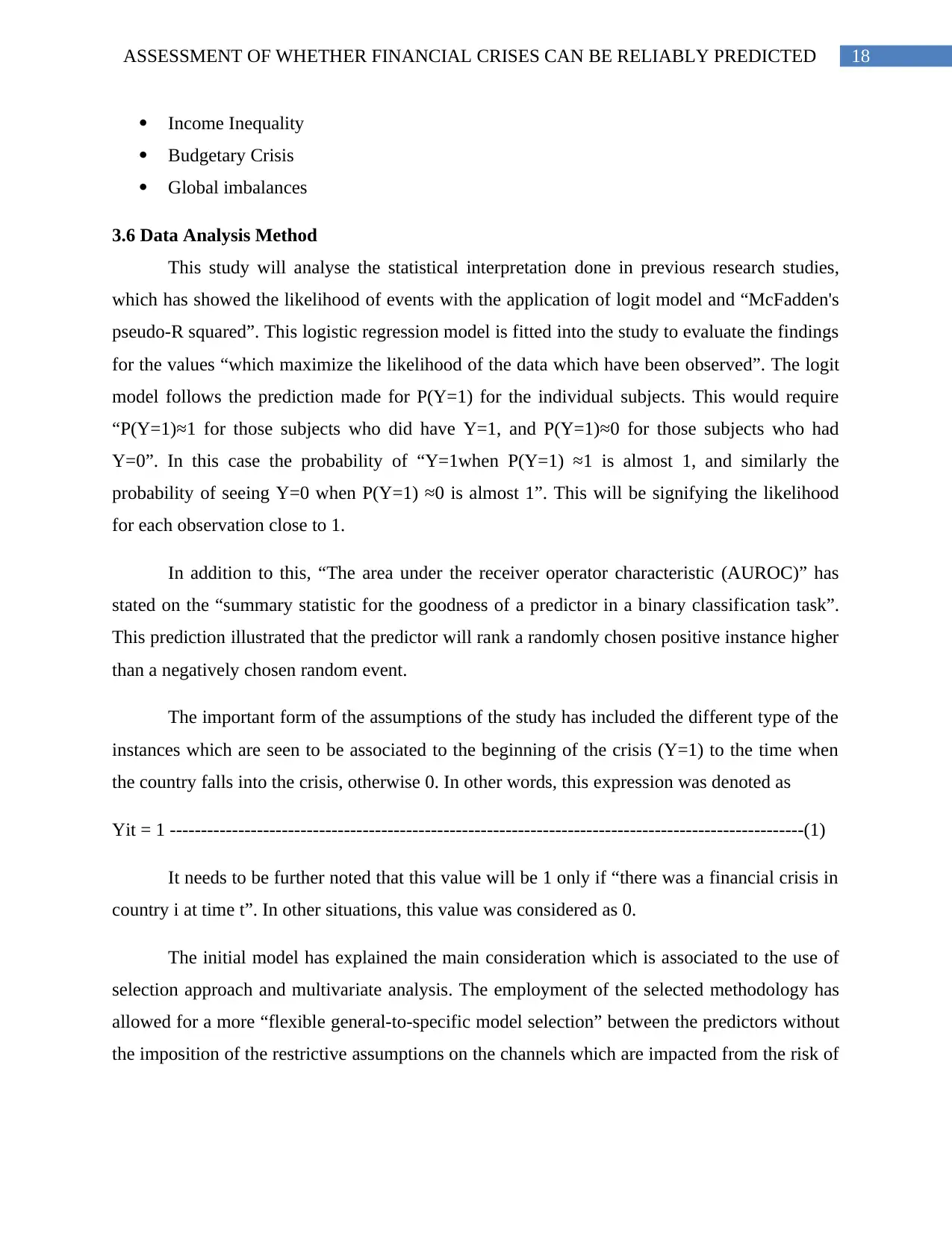
Income Inequality
Budgetary Crisis
Global imbalances
3.6 Data Analysis Method
This study will analyse the statistical interpretation done in previous research studies,
which has showed the likelihood of events with the application of logit model and “McFadden's
pseudo-R squared”. This logistic regression model is fitted into the study to evaluate the findings
for the values “which maximize the likelihood of the data which have been observed”. The logit
model follows the prediction made for P(Y=1) for the individual subjects. This would require
“P(Y=1)≈1 for those subjects who did have Y=1, and P(Y=1)≈0 for those subjects who had
Y=0”. In this case the probability of “Y=1when P(Y=1) ≈1 is almost 1, and similarly the
probability of seeing Y=0 when P(Y=1) ≈0 is almost 1”. This will be signifying the likelihood
for each observation close to 1.
In addition to this, “The area under the receiver operator characteristic (AUROC)” has
stated on the “summary statistic for the goodness of a predictor in a binary classification task”.
This prediction illustrated that the predictor will rank a randomly chosen positive instance higher
than a negatively chosen random event.
The important form of the assumptions of the study has included the different type of the
instances which are seen to be associated to the beginning of the crisis (Y=1) to the time when
the country falls into the crisis, otherwise 0. In other words, this expression was denoted as
Yit = 1 ------------------------------------------------------------------------------------------------------(1)
It needs to be further noted that this value will be 1 only if “there was a financial crisis in
country i at time t”. In other situations, this value was considered as 0.
The initial model has explained the main consideration which is associated to the use of
selection approach and multivariate analysis. The employment of the selected methodology has
allowed for a more “flexible general-to-specific model selection” between the predictors without
the imposition of the restrictive assumptions on the channels which are impacted from the risk of
Paraphrase This Document
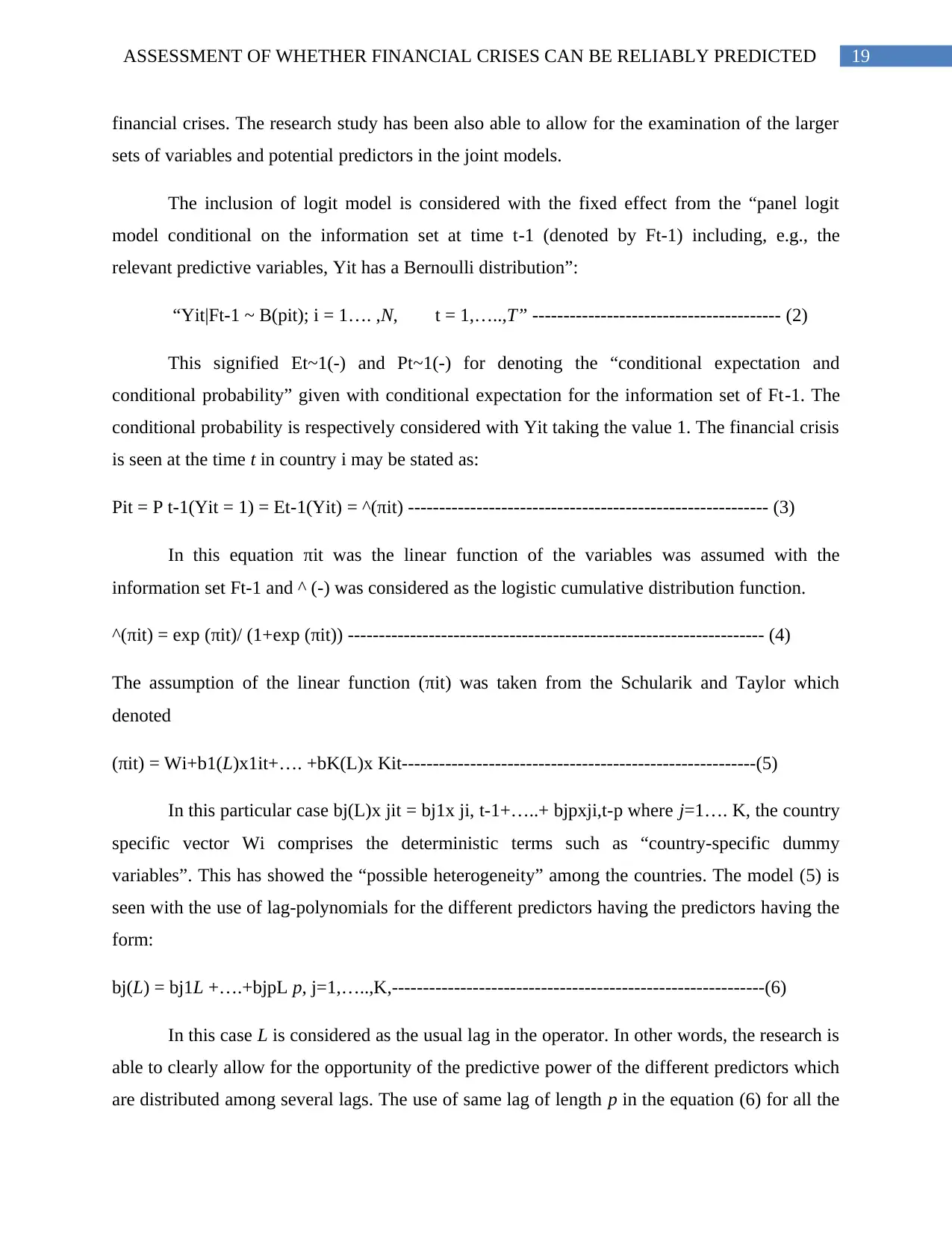
financial crises. The research study has been also able to allow for the examination of the larger
sets of variables and potential predictors in the joint models.
The inclusion of logit model is considered with the fixed effect from the “panel logit
model conditional on the information set at time t-1 (denoted by Ft-1) including, e.g., the
relevant predictive variables, Yit has a Bernoulli distribution”:
“Yit|Ft-1 ~ B(pit); i = 1…. ,N, t = 1,…..,T” ---------------------------------------- (2)
This signified Et~1(-) and Pt~1(-) for denoting the “conditional expectation and
conditional probability” given with conditional expectation for the information set of Ft-1. The
conditional probability is respectively considered with Yit taking the value 1. The financial crisis
is seen at the time t in country i may be stated as:
Pit = P t-1(Yit = 1) = Et-1(Yit) = ^(πit) ---------------------------------------------------------- (3)
In this equation πit was the linear function of the variables was assumed with the
information set Ft-1 and ^ (-) was considered as the logistic cumulative distribution function.
^(πit) = exp (πit)/ (1+exp (πit)) ------------------------------------------------------------------- (4)
The assumption of the linear function (πit) was taken from the Schularik and Taylor which
denoted
(πit) = Wi+b1(L)x1it+…. +bK(L)x Kit---------------------------------------------------------(5)
In this particular case bj(L)x jit = bj1x ji, t-1+…..+ bjpxji,t-p where j=1…. K, the country
specific vector Wi comprises the deterministic terms such as “country-specific dummy
variables”. This has showed the “possible heterogeneity” among the countries. The model (5) is
seen with the use of lag-polynomials for the different predictors having the predictors having the
form:
bj(L) = bj1L +….+bjpL p, j=1,…..,K,------------------------------------------------------------(6)
In this case L is considered as the usual lag in the operator. In other words, the research is
able to clearly allow for the opportunity of the predictive power of the different predictors which
are distributed among several lags. The use of same lag of length p in the equation (6) for all the
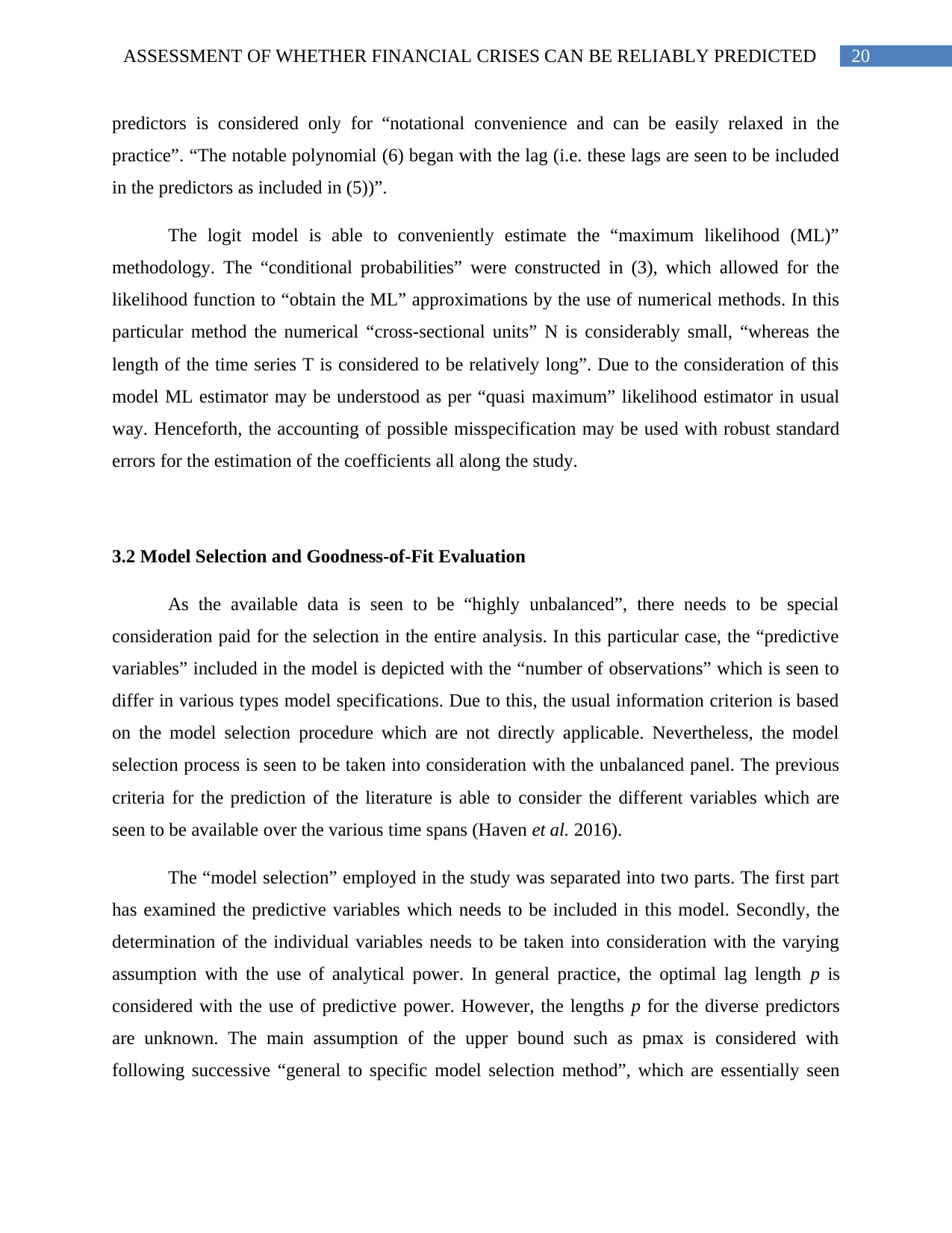
predictors is considered only for “notational convenience and can be easily relaxed in the
practice”. “The notable polynomial (6) began with the lag (i.e. these lags are seen to be included
in the predictors as included in (5))”.
The logit model is able to conveniently estimate the “maximum likelihood (ML)”
methodology. The “conditional probabilities” were constructed in (3), which allowed for the
likelihood function to “obtain the ML” approximations by the use of numerical methods. In this
particular method the numerical “cross-sectional units” N is considerably small, “whereas the
length of the time series T is considered to be relatively long”. Due to the consideration of this
model ML estimator may be understood as per “quasi maximum” likelihood estimator in usual
way. Henceforth, the accounting of possible misspecification may be used with robust standard
errors for the estimation of the coefficients all along the study.
3.2 Model Selection and Goodness-of-Fit Evaluation
As the available data is seen to be “highly unbalanced”, there needs to be special
consideration paid for the selection in the entire analysis. In this particular case, the “predictive
variables” included in the model is depicted with the “number of observations” which is seen to
differ in various types model specifications. Due to this, the usual information criterion is based
on the model selection procedure which are not directly applicable. Nevertheless, the model
selection process is seen to be taken into consideration with the unbalanced panel. The previous
criteria for the prediction of the literature is able to consider the different variables which are
seen to be available over the various time spans (Haven et al. 2016).
The “model selection” employed in the study was separated into two parts. The first part
has examined the predictive variables which needs to be included in this model. Secondly, the
determination of the individual variables needs to be taken into consideration with the varying
assumption with the use of analytical power. In general practice, the optimal lag length p is
considered with the use of predictive power. However, the lengths p for the diverse predictors
are unknown. The main assumption of the upper bound such as pmax is considered with
following successive “general to specific model selection method”, which are essentially seen
You're viewing a preview
Unlock full access by subscribing today!
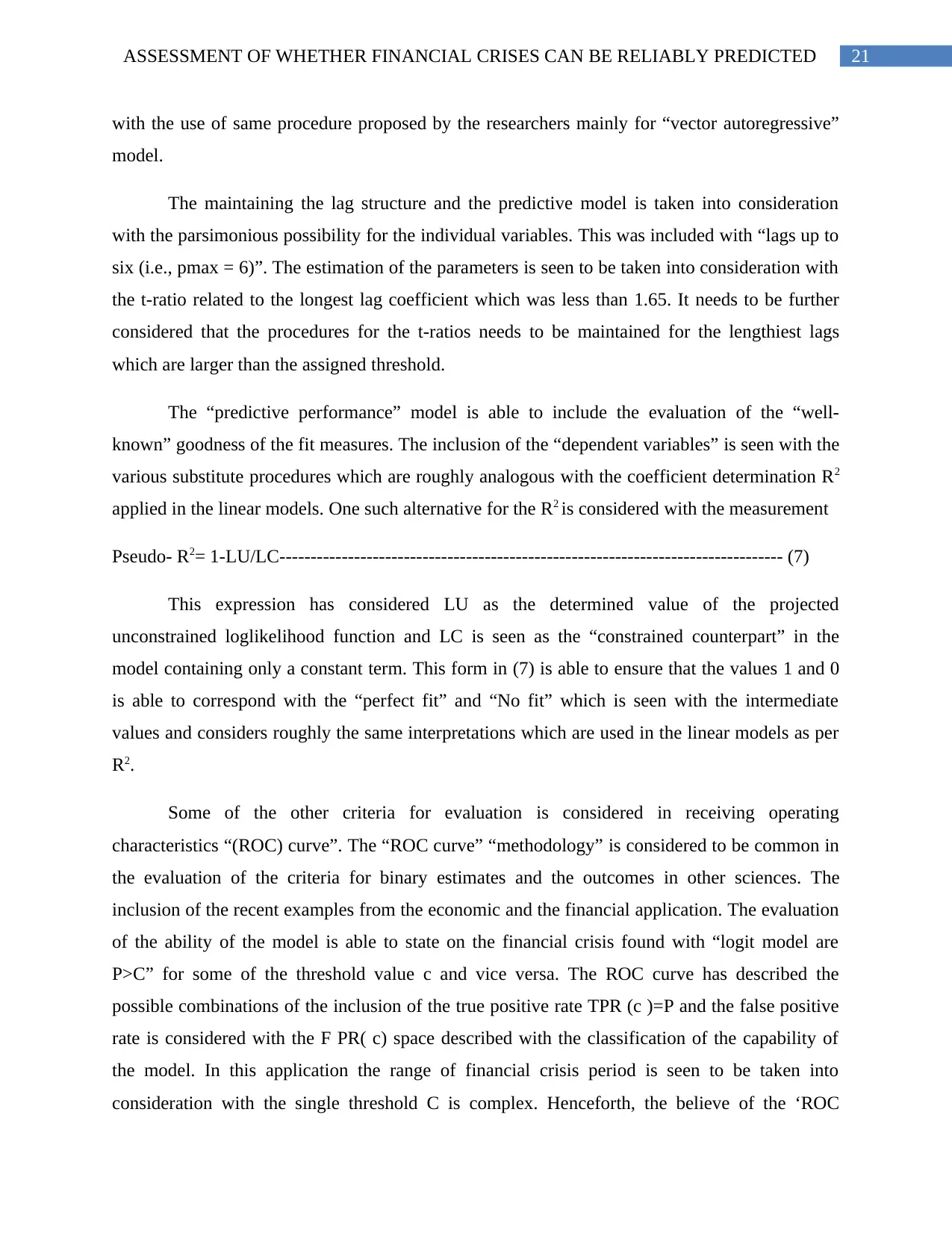
with the use of same procedure proposed by the researchers mainly for “vector autoregressive”
model.
The maintaining the lag structure and the predictive model is taken into consideration
with the parsimonious possibility for the individual variables. This was included with “lags up to
six (i.e., pmax = 6)”. The estimation of the parameters is seen to be taken into consideration with
the t-ratio related to the longest lag coefficient which was less than 1.65. It needs to be further
considered that the procedures for the t-ratios needs to be maintained for the lengthiest lags
which are larger than the assigned threshold.
The “predictive performance” model is able to include the evaluation of the “well-
known” goodness of the fit measures. The inclusion of the “dependent variables” is seen with the
various substitute procedures which are roughly analogous with the coefficient determination R2
applied in the linear models. One such alternative for the R2 is considered with the measurement
Pseudo- R2= 1-LU/LC--------------------------------------------------------------------------------- (7)
This expression has considered LU as the determined value of the projected
unconstrained loglikelihood function and LC is seen as the “constrained counterpart” in the
model containing only a constant term. This form in (7) is able to ensure that the values 1 and 0
is able to correspond with the “perfect fit” and “No fit” which is seen with the intermediate
values and considers roughly the same interpretations which are used in the linear models as per
R2.
Some of the other criteria for evaluation is considered in receiving operating
characteristics “(ROC) curve”. The “ROC curve” “methodology” is considered to be common in
the evaluation of the criteria for binary estimates and the outcomes in other sciences. The
inclusion of the recent examples from the economic and the financial application. The evaluation
of the ability of the model is able to state on the financial crisis found with “logit model are
P>C” for some of the threshold value c and vice versa. The ROC curve has described the
possible combinations of the inclusion of the true positive rate TPR (c )=P and the false positive
rate is considered with the F PR( c) space described with the classification of the capability of
the model. In this application the range of financial crisis period is seen to be taken into
consideration with the single threshold C is complex. Henceforth, the believe of the ‘ROC
Paraphrase This Document
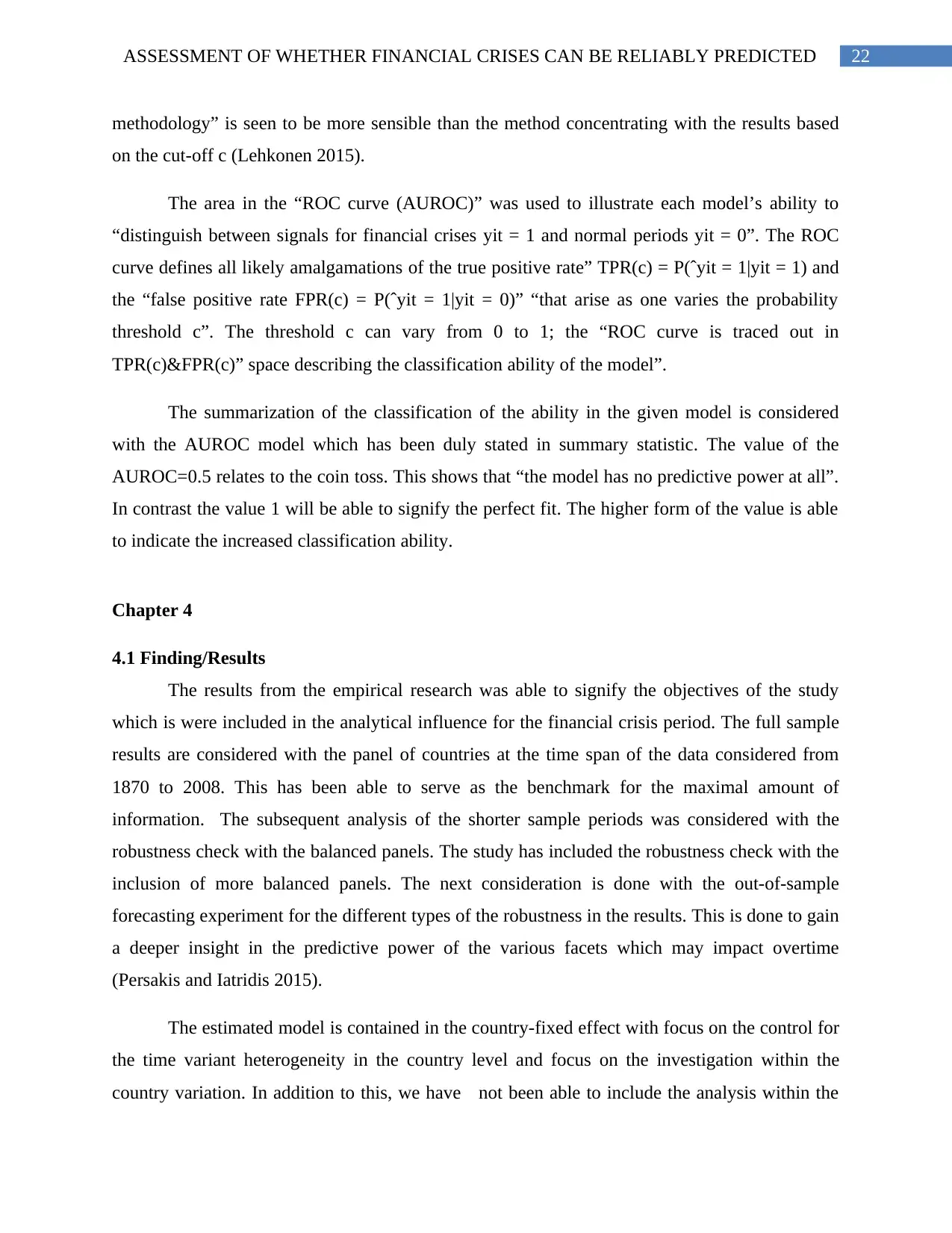
methodology” is seen to be more sensible than the method concentrating with the results based
on the cut-off c (Lehkonen 2015).
The area in the “ROC curve (AUROC)” was used to illustrate each model’s ability to
“distinguish between signals for financial crises yit = 1 and normal periods yit = 0”. The ROC
curve defines all likely amalgamations of the true positive rate” TPR(c) = P(ˆyit = 1|yit = 1) and
the “false positive rate FPR(c) = P(ˆyit = 1|yit = 0)” “that arise as one varies the probability
threshold c”. The threshold c can vary from 0 to 1; the “ROC curve is traced out in
TPR(c)&FPR(c)” space describing the classification ability of the model”.
The summarization of the classification of the ability in the given model is considered
with the AUROC model which has been duly stated in summary statistic. The value of the
AUROC=0.5 relates to the coin toss. This shows that “the model has no predictive power at all”.
In contrast the value 1 will be able to signify the perfect fit. The higher form of the value is able
to indicate the increased classification ability.
Chapter 4
4.1 Finding/Results
The results from the empirical research was able to signify the objectives of the study
which is were included in the analytical influence for the financial crisis period. The full sample
results are considered with the panel of countries at the time span of the data considered from
1870 to 2008. This has been able to serve as the benchmark for the maximal amount of
information. The subsequent analysis of the shorter sample periods was considered with the
robustness check with the balanced panels. The study has included the robustness check with the
inclusion of more balanced panels. The next consideration is done with the out-of-sample
forecasting experiment for the different types of the robustness in the results. This is done to gain
a deeper insight in the predictive power of the various facets which may impact overtime
(Persakis and Iatridis 2015).
The estimated model is contained in the country-fixed effect with focus on the control for
the time variant heterogeneity in the country level and focus on the investigation within the
country variation. In addition to this, we have not been able to include the analysis within the
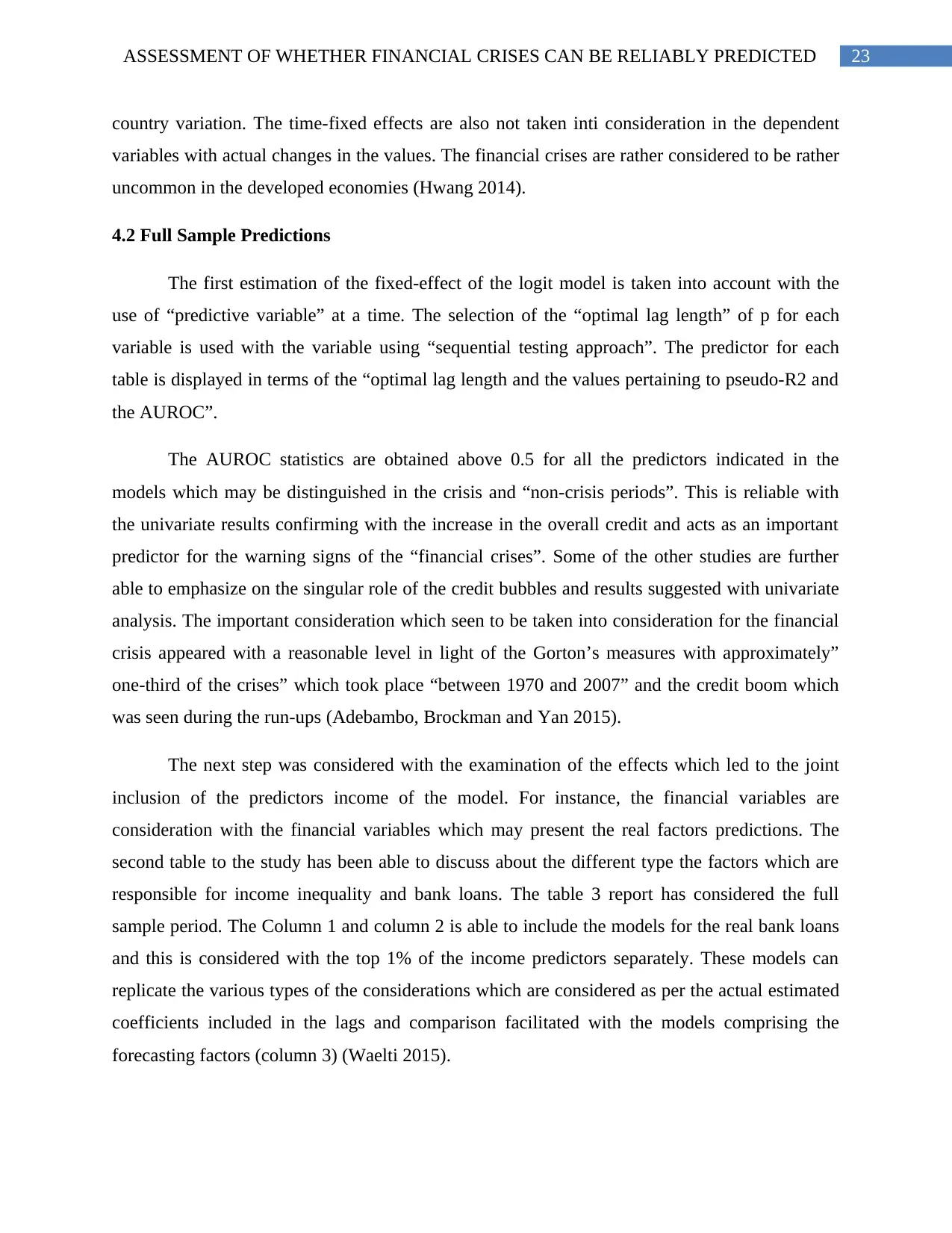
country variation. The time-fixed effects are also not taken inti consideration in the dependent
variables with actual changes in the values. The financial crises are rather considered to be rather
uncommon in the developed economies (Hwang 2014).
4.2 Full Sample Predictions
The first estimation of the fixed-effect of the logit model is taken into account with the
use of “predictive variable” at a time. The selection of the “optimal lag length” of p for each
variable is used with the variable using “sequential testing approach”. The predictor for each
table is displayed in terms of the “optimal lag length and the values pertaining to pseudo-R2 and
the AUROC”.
The AUROC statistics are obtained above 0.5 for all the predictors indicated in the
models which may be distinguished in the crisis and “non-crisis periods”. This is reliable with
the univariate results confirming with the increase in the overall credit and acts as an important
predictor for the warning signs of the “financial crises”. Some of the other studies are further
able to emphasize on the singular role of the credit bubbles and results suggested with univariate
analysis. The important consideration which seen to be taken into consideration for the financial
crisis appeared with a reasonable level in light of the Gorton’s measures with approximately”
one-third of the crises” which took place “between 1970 and 2007” and the credit boom which
was seen during the run-ups (Adebambo, Brockman and Yan 2015).
The next step was considered with the examination of the effects which led to the joint
inclusion of the predictors income of the model. For instance, the financial variables are
consideration with the financial variables which may present the real factors predictions. The
second table to the study has been able to discuss about the different type the factors which are
responsible for income inequality and bank loans. The table 3 report has considered the full
sample period. The Column 1 and column 2 is able to include the models for the real bank loans
and this is considered with the top 1% of the income predictors separately. These models can
replicate the various types of the considerations which are considered as per the actual estimated
coefficients included in the lags and comparison facilitated with the models comprising the
forecasting factors (column 3) (Waelti 2015).
You're viewing a preview
Unlock full access by subscribing today!
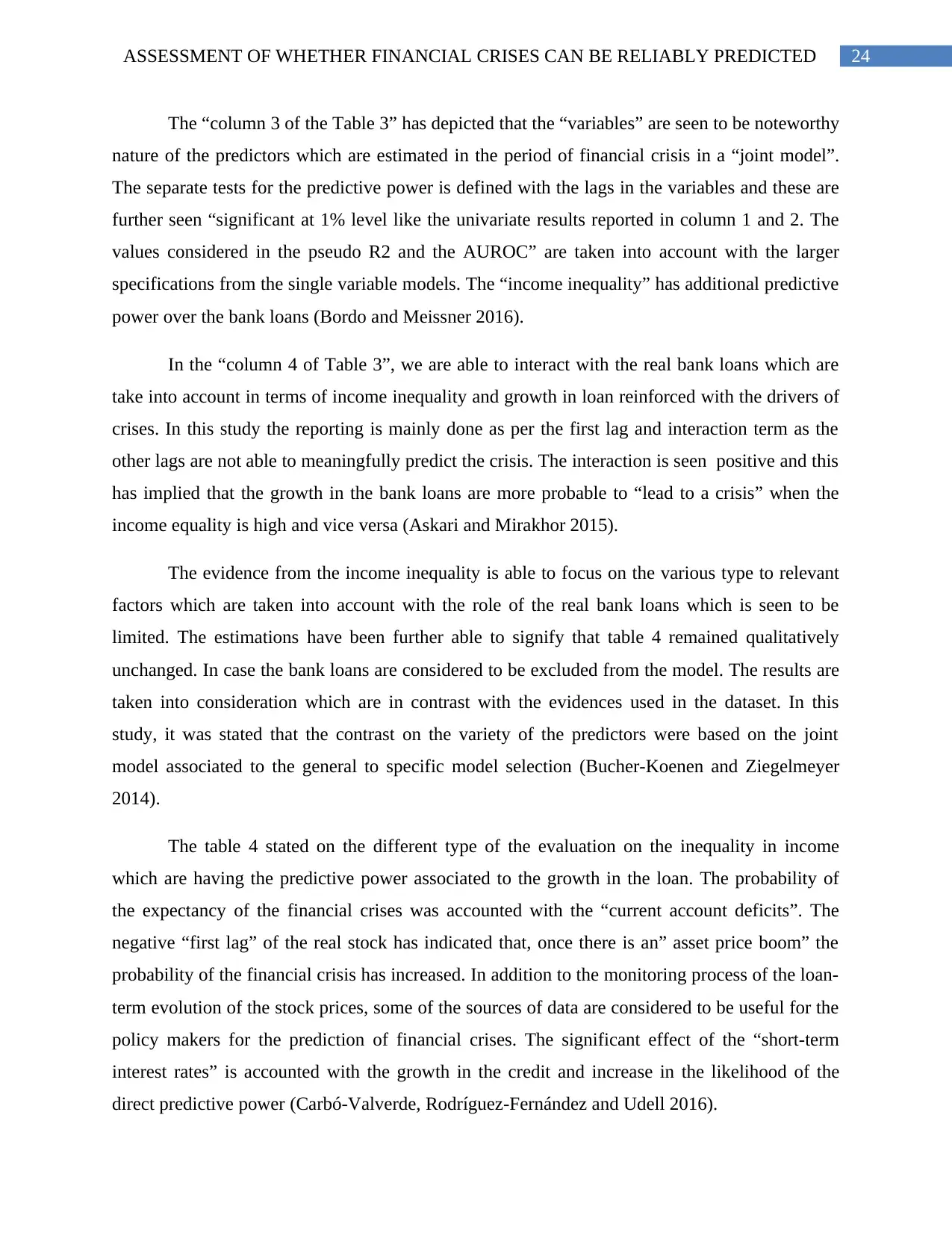
The “column 3 of the Table 3” has depicted that the “variables” are seen to be noteworthy
nature of the predictors which are estimated in the period of financial crisis in a “joint model”.
The separate tests for the predictive power is defined with the lags in the variables and these are
further seen “significant at 1% level like the univariate results reported in column 1 and 2. The
values considered in the pseudo R2 and the AUROC” are taken into account with the larger
specifications from the single variable models. The “income inequality” has additional predictive
power over the bank loans (Bordo and Meissner 2016).
In the “column 4 of Table 3”, we are able to interact with the real bank loans which are
take into account in terms of income inequality and growth in loan reinforced with the drivers of
crises. In this study the reporting is mainly done as per the first lag and interaction term as the
other lags are not able to meaningfully predict the crisis. The interaction is seen positive and this
has implied that the growth in the bank loans are more probable to “lead to a crisis” when the
income equality is high and vice versa (Askari and Mirakhor 2015).
The evidence from the income inequality is able to focus on the various type to relevant
factors which are taken into account with the role of the real bank loans which is seen to be
limited. The estimations have been further able to signify that table 4 remained qualitatively
unchanged. In case the bank loans are considered to be excluded from the model. The results are
taken into consideration which are in contrast with the evidences used in the dataset. In this
study, it was stated that the contrast on the variety of the predictors were based on the joint
model associated to the general to specific model selection (Bucher-Koenen and Ziegelmeyer
2014).
The table 4 stated on the different type of the evaluation on the inequality in income
which are having the predictive power associated to the growth in the loan. The probability of
the expectancy of the financial crises was accounted with the “current account deficits”. The
negative “first lag” of the real stock has indicated that, once there is an” asset price boom” the
probability of the financial crisis has increased. In addition to the monitoring process of the loan-
term evolution of the stock prices, some of the sources of data are considered to be useful for the
policy makers for the prediction of financial crises. The significant effect of the “short-term
interest rates” is accounted with the growth in the credit and increase in the likelihood of the
direct predictive power (Carbó-Valverde, Rodríguez-Fernández and Udell 2016).
Paraphrase This Document
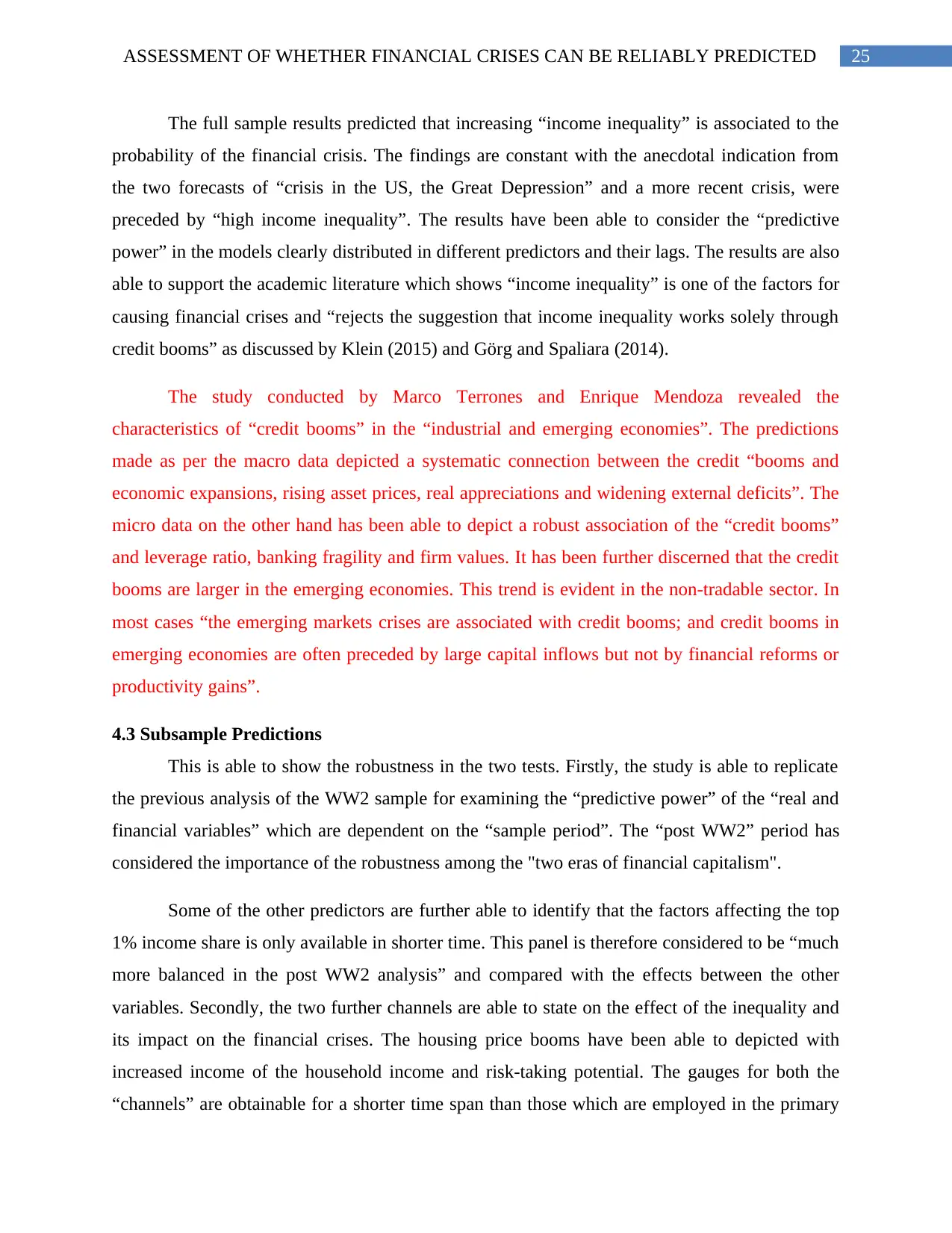
The full sample results predicted that increasing “income inequality” is associated to the
probability of the financial crisis. The findings are constant with the anecdotal indication from
the two forecasts of “crisis in the US, the Great Depression” and a more recent crisis, were
preceded by “high income inequality”. The results have been able to consider the “predictive
power” in the models clearly distributed in different predictors and their lags. The results are also
able to support the academic literature which shows “income inequality” is one of the factors for
causing financial crises and “rejects the suggestion that income inequality works solely through
credit booms” as discussed by Klein (2015) and Görg and Spaliara (2014).
The study conducted by Marco Terrones and Enrique Mendoza revealed the
characteristics of “credit booms” in the “industrial and emerging economies”. The predictions
made as per the macro data depicted a systematic connection between the credit “booms and
economic expansions, rising asset prices, real appreciations and widening external deficits”. The
micro data on the other hand has been able to depict a robust association of the “credit booms”
and leverage ratio, banking fragility and firm values. It has been further discerned that the credit
booms are larger in the emerging economies. This trend is evident in the non-tradable sector. In
most cases “the emerging markets crises are associated with credit booms; and credit booms in
emerging economies are often preceded by large capital inflows but not by financial reforms or
productivity gains”.
4.3 Subsample Predictions
This is able to show the robustness in the two tests. Firstly, the study is able to replicate
the previous analysis of the WW2 sample for examining the “predictive power” of the “real and
financial variables” which are dependent on the “sample period”. The “post WW2” period has
considered the importance of the robustness among the "two eras of financial capitalism".
Some of the other predictors are further able to identify that the factors affecting the top
1% income share is only available in shorter time. This panel is therefore considered to be “much
more balanced in the post WW2 analysis” and compared with the effects between the other
variables. Secondly, the two further channels are able to state on the effect of the inequality and
its impact on the financial crises. The housing price booms have been able to depicted with
increased income of the household income and risk-taking potential. The gauges for both the
“channels” are obtainable for a shorter time span than those which are employed in the primary
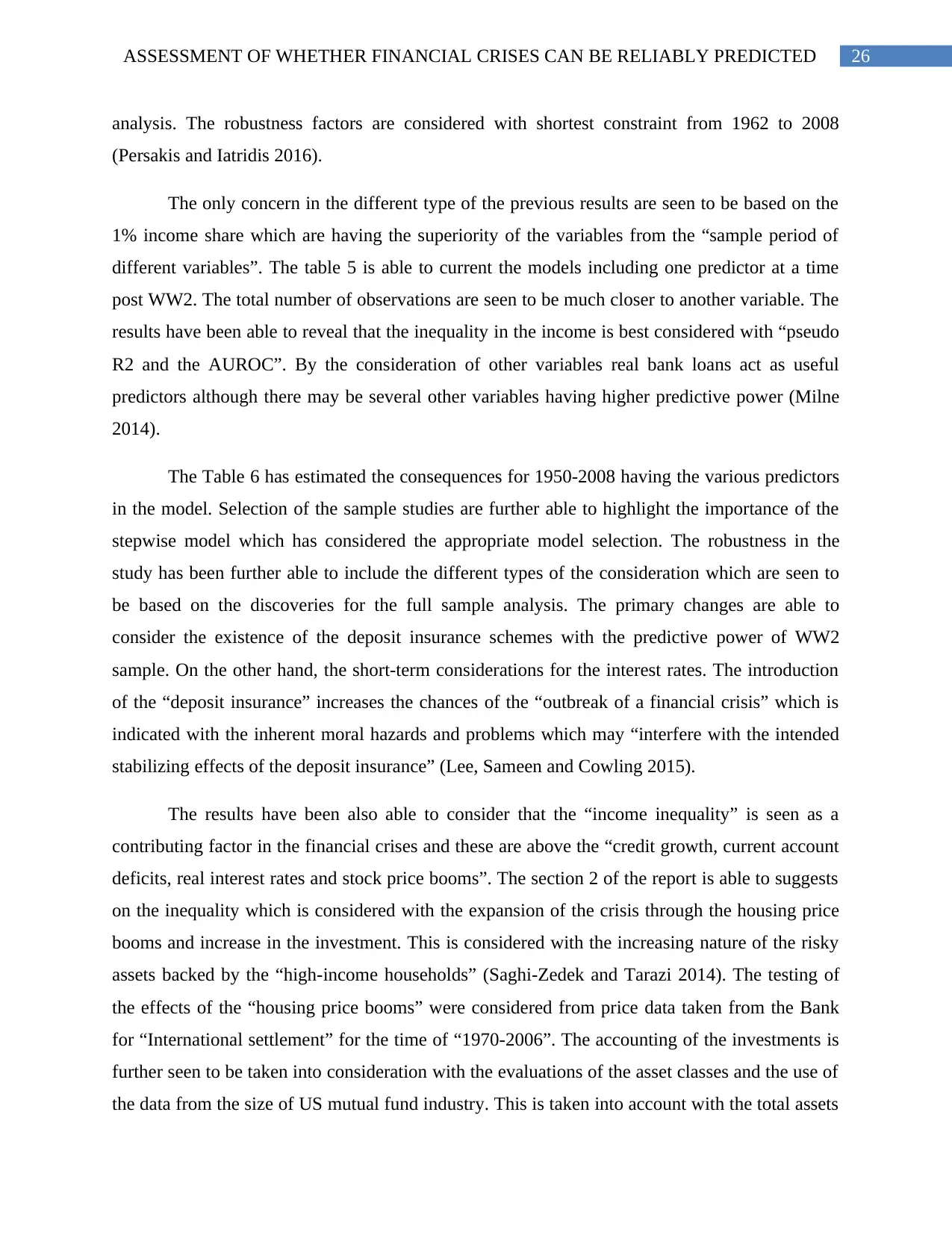
analysis. The robustness factors are considered with shortest constraint from 1962 to 2008
(Persakis and Iatridis 2016).
The only concern in the different type of the previous results are seen to be based on the
1% income share which are having the superiority of the variables from the “sample period of
different variables”. The table 5 is able to current the models including one predictor at a time
post WW2. The total number of observations are seen to be much closer to another variable. The
results have been able to reveal that the inequality in the income is best considered with “pseudo
R2 and the AUROC”. By the consideration of other variables real bank loans act as useful
predictors although there may be several other variables having higher predictive power (Milne
2014).
The Table 6 has estimated the consequences for 1950-2008 having the various predictors
in the model. Selection of the sample studies are further able to highlight the importance of the
stepwise model which has considered the appropriate model selection. The robustness in the
study has been further able to include the different types of the consideration which are seen to
be based on the discoveries for the full sample analysis. The primary changes are able to
consider the existence of the deposit insurance schemes with the predictive power of WW2
sample. On the other hand, the short-term considerations for the interest rates. The introduction
of the “deposit insurance” increases the chances of the “outbreak of a financial crisis” which is
indicated with the inherent moral hazards and problems which may “interfere with the intended
stabilizing effects of the deposit insurance” (Lee, Sameen and Cowling 2015).
The results have been also able to consider that the “income inequality” is seen as a
contributing factor in the financial crises and these are above the “credit growth, current account
deficits, real interest rates and stock price booms”. The section 2 of the report is able to suggests
on the inequality which is considered with the expansion of the crisis through the housing price
booms and increase in the investment. This is considered with the increasing nature of the risky
assets backed by the “high-income households” (Saghi-Zedek and Tarazi 2014). The testing of
the effects of the “housing price booms” were considered from price data taken from the Bank
for “International settlement” for the time of “1970-2006”. The accounting of the investments is
further seen to be taken into consideration with the evaluations of the asset classes and the use of
the data from the size of US mutual fund industry. This is taken into account with the total assets
You're viewing a preview
Unlock full access by subscribing today!
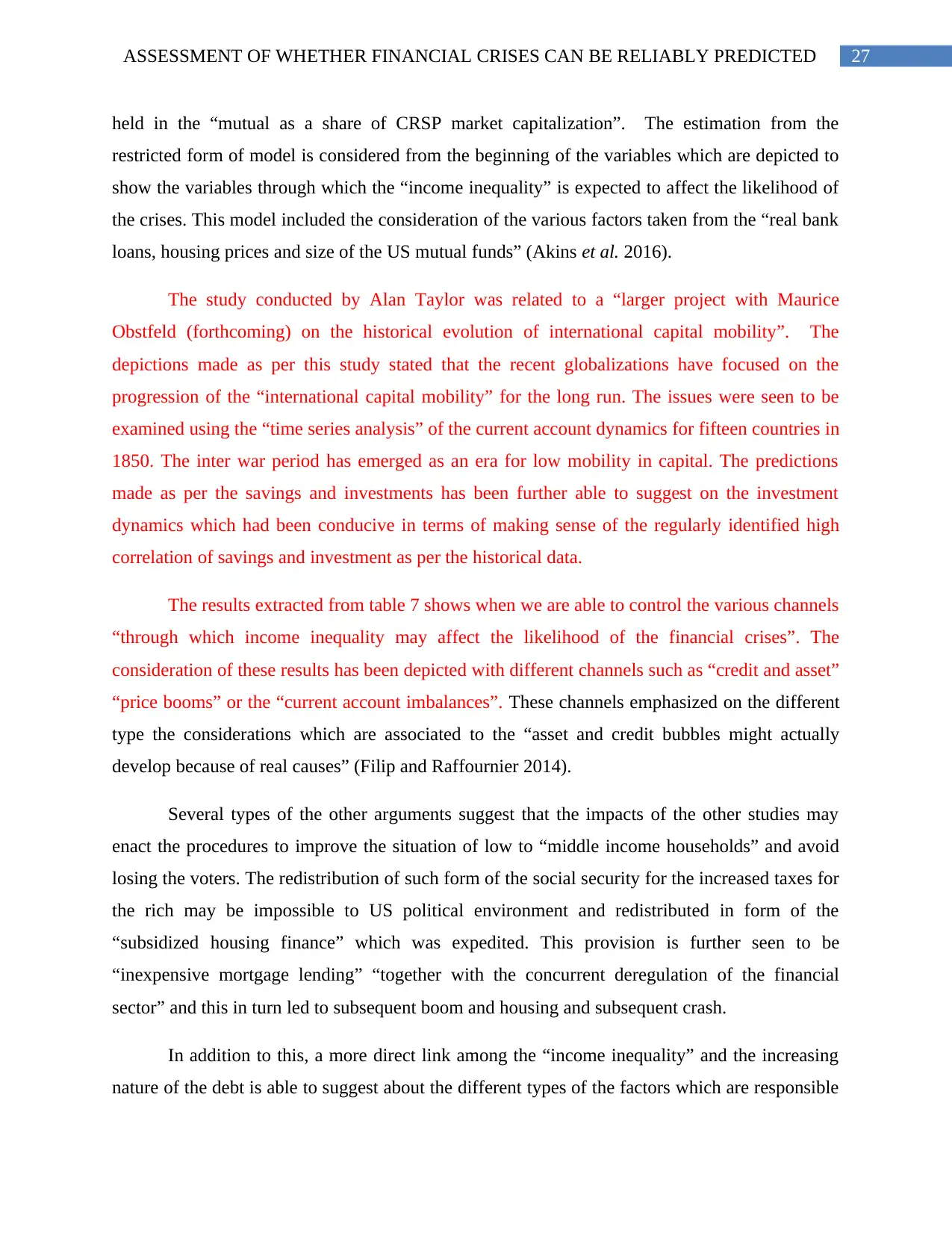
held in the “mutual as a share of CRSP market capitalization”. The estimation from the
restricted form of model is considered from the beginning of the variables which are depicted to
show the variables through which the “income inequality” is expected to affect the likelihood of
the crises. This model included the consideration of the various factors taken from the “real bank
loans, housing prices and size of the US mutual funds” (Akins et al. 2016).
The study conducted by Alan Taylor was related to a “larger project with Maurice
Obstfeld (forthcoming) on the historical evolution of international capital mobility”. The
depictions made as per this study stated that the recent globalizations have focused on the
progression of the “international capital mobility” for the long run. The issues were seen to be
examined using the “time series analysis” of the current account dynamics for fifteen countries in
1850. The inter war period has emerged as an era for low mobility in capital. The predictions
made as per the savings and investments has been further able to suggest on the investment
dynamics which had been conducive in terms of making sense of the regularly identified high
correlation of savings and investment as per the historical data.
The results extracted from table 7 shows when we are able to control the various channels
“through which income inequality may affect the likelihood of the financial crises”. The
consideration of these results has been depicted with different channels such as “credit and asset”
“price booms” or the “current account imbalances”. These channels emphasized on the different
type the considerations which are associated to the “asset and credit bubbles might actually
develop because of real causes” (Filip and Raffournier 2014).
Several types of the other arguments suggest that the impacts of the other studies may
enact the procedures to improve the situation of low to “middle income households” and avoid
losing the voters. The redistribution of such form of the social security for the increased taxes for
the rich may be impossible to US political environment and redistributed in form of the
“subsidized housing finance” which was expedited. This provision is further seen to be
“inexpensive mortgage lending” “together with the concurrent deregulation of the financial
sector” and this in turn led to subsequent boom and housing and subsequent crash.
In addition to this, a more direct link among the “income inequality” and the increasing
nature of the debt is able to suggest about the different types of the factors which are responsible
Paraphrase This Document
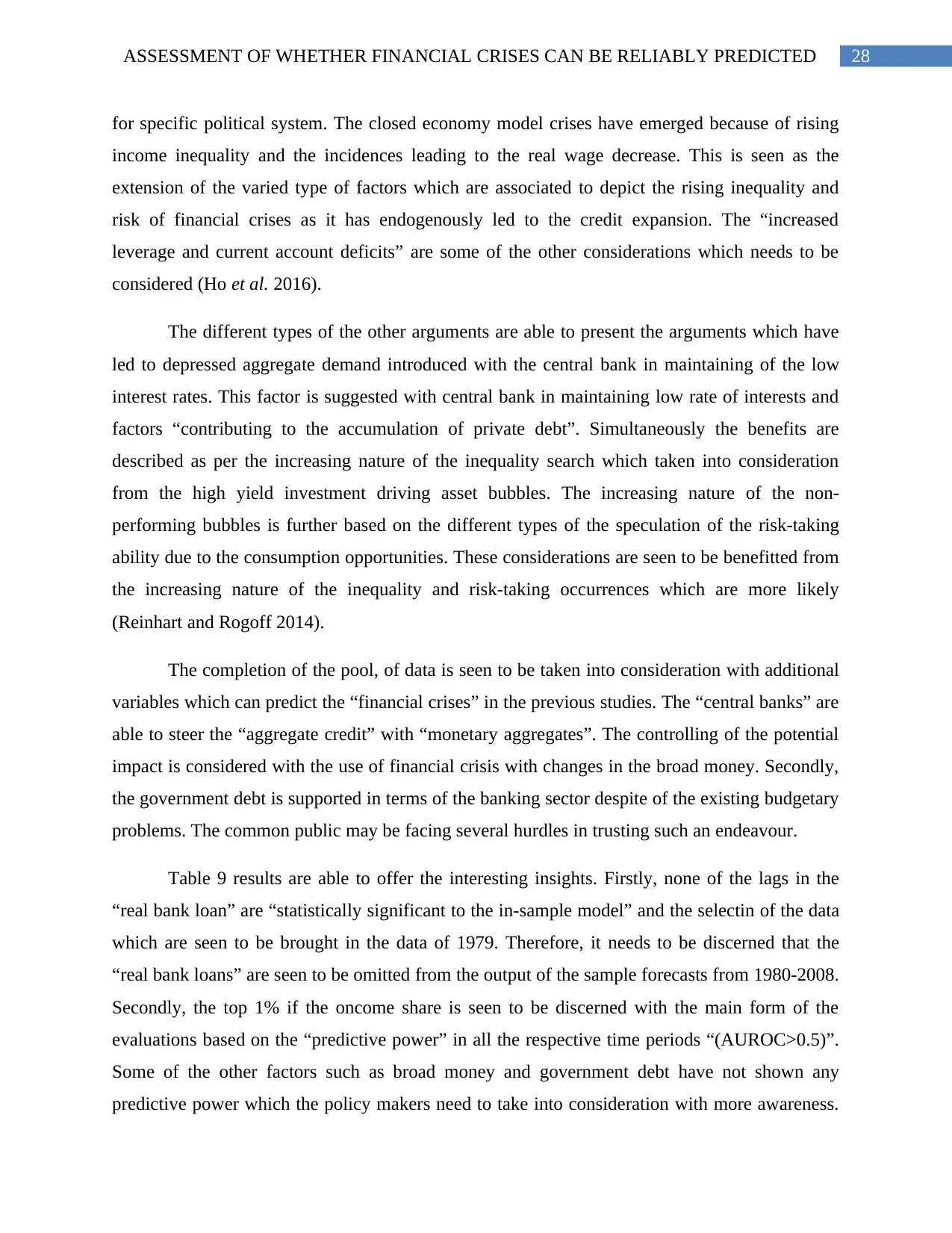
for specific political system. The closed economy model crises have emerged because of rising
income inequality and the incidences leading to the real wage decrease. This is seen as the
extension of the varied type of factors which are associated to depict the rising inequality and
risk of financial crises as it has endogenously led to the credit expansion. The “increased
leverage and current account deficits” are some of the other considerations which needs to be
considered (Ho et al. 2016).
The different types of the other arguments are able to present the arguments which have
led to depressed aggregate demand introduced with the central bank in maintaining of the low
interest rates. This factor is suggested with central bank in maintaining low rate of interests and
factors “contributing to the accumulation of private debt”. Simultaneously the benefits are
described as per the increasing nature of the inequality search which taken into consideration
from the high yield investment driving asset bubbles. The increasing nature of the non-
performing bubbles is further based on the different types of the speculation of the risk-taking
ability due to the consumption opportunities. These considerations are seen to be benefitted from
the increasing nature of the inequality and risk-taking occurrences which are more likely
(Reinhart and Rogoff 2014).
The completion of the pool, of data is seen to be taken into consideration with additional
variables which can predict the “financial crises” in the previous studies. The “central banks” are
able to steer the “aggregate credit” with “monetary aggregates”. The controlling of the potential
impact is considered with the use of financial crisis with changes in the broad money. Secondly,
the government debt is supported in terms of the banking sector despite of the existing budgetary
problems. The common public may be facing several hurdles in trusting such an endeavour.
Table 9 results are able to offer the interesting insights. Firstly, none of the lags in the
“real bank loan” are “statistically significant to the in-sample model” and the selectin of the data
which are seen to be brought in the data of 1979. Therefore, it needs to be discerned that the
“real bank loans” are seen to be omitted from the output of the sample forecasts from 1980-2008.
Secondly, the top 1% if the oncome share is seen to be discerned with the main form of the
evaluations based on the “predictive power” in all the respective time periods “(AUROC>0.5)”.
Some of the other factors such as broad money and government debt have not shown any
predictive power which the policy makers need to take into consideration with more awareness.
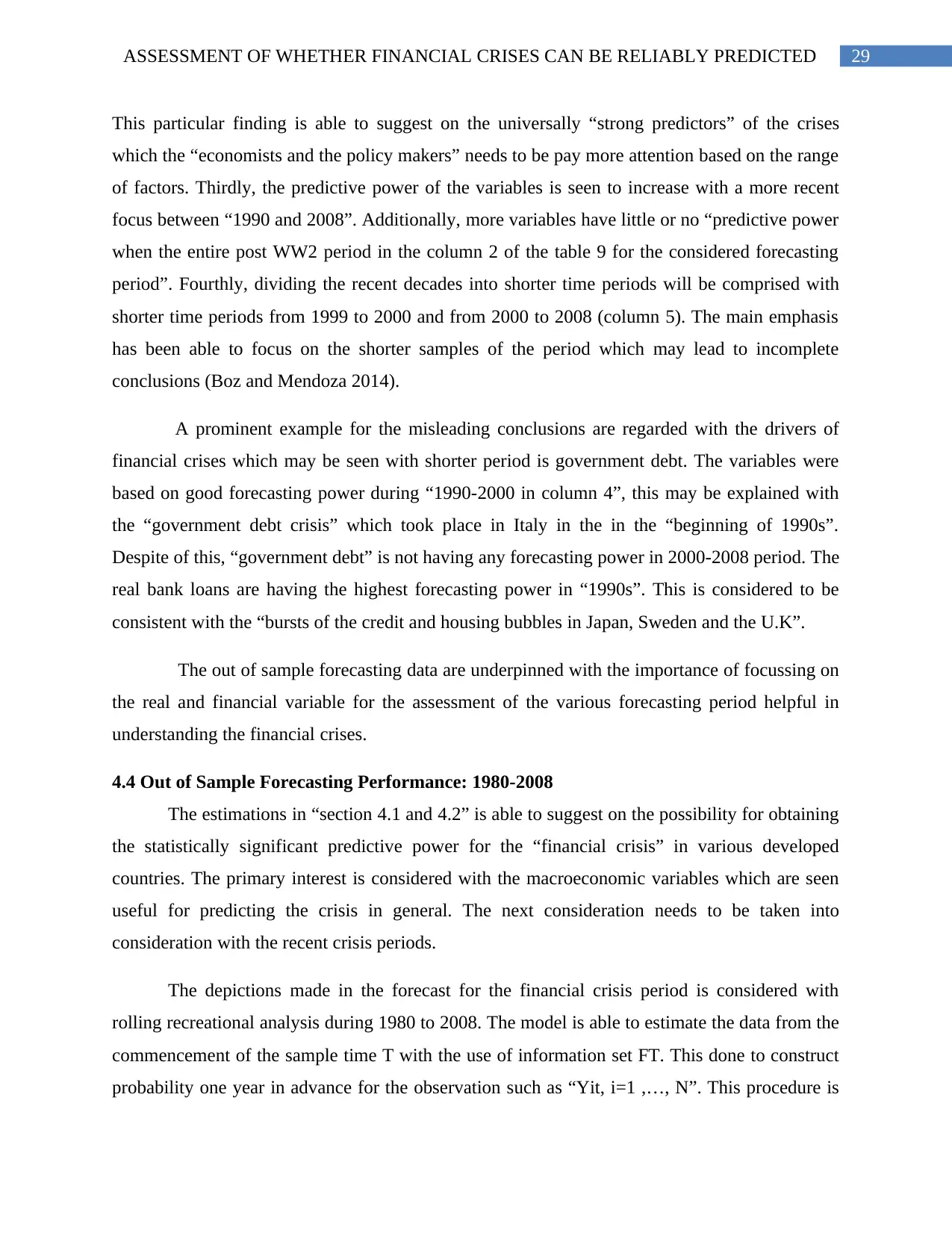
This particular finding is able to suggest on the universally “strong predictors” of the crises
which the “economists and the policy makers” needs to be pay more attention based on the range
of factors. Thirdly, the predictive power of the variables is seen to increase with a more recent
focus between “1990 and 2008”. Additionally, more variables have little or no “predictive power
when the entire post WW2 period in the column 2 of the table 9 for the considered forecasting
period”. Fourthly, dividing the recent decades into shorter time periods will be comprised with
shorter time periods from 1999 to 2000 and from 2000 to 2008 (column 5). The main emphasis
has been able to focus on the shorter samples of the period which may lead to incomplete
conclusions (Boz and Mendoza 2014).
A prominent example for the misleading conclusions are regarded with the drivers of
financial crises which may be seen with shorter period is government debt. The variables were
based on good forecasting power during “1990-2000 in column 4”, this may be explained with
the “government debt crisis” which took place in Italy in the in the “beginning of 1990s”.
Despite of this, “government debt” is not having any forecasting power in 2000-2008 period. The
real bank loans are having the highest forecasting power in “1990s”. This is considered to be
consistent with the “bursts of the credit and housing bubbles in Japan, Sweden and the U.K”.
The out of sample forecasting data are underpinned with the importance of focussing on
the real and financial variable for the assessment of the various forecasting period helpful in
understanding the financial crises.
4.4 Out of Sample Forecasting Performance: 1980-2008
The estimations in “section 4.1 and 4.2” is able to suggest on the possibility for obtaining
the statistically significant predictive power for the “financial crisis” in various developed
countries. The primary interest is considered with the macroeconomic variables which are seen
useful for predicting the crisis in general. The next consideration needs to be taken into
consideration with the recent crisis periods.
The depictions made in the forecast for the financial crisis period is considered with
rolling recreational analysis during 1980 to 2008. The model is able to estimate the data from the
commencement of the sample time T with the use of information set FT. This done to construct
probability one year in advance for the observation such as “Yit, i=1 ,…, N”. This procedure is
You're viewing a preview
Unlock full access by subscribing today!
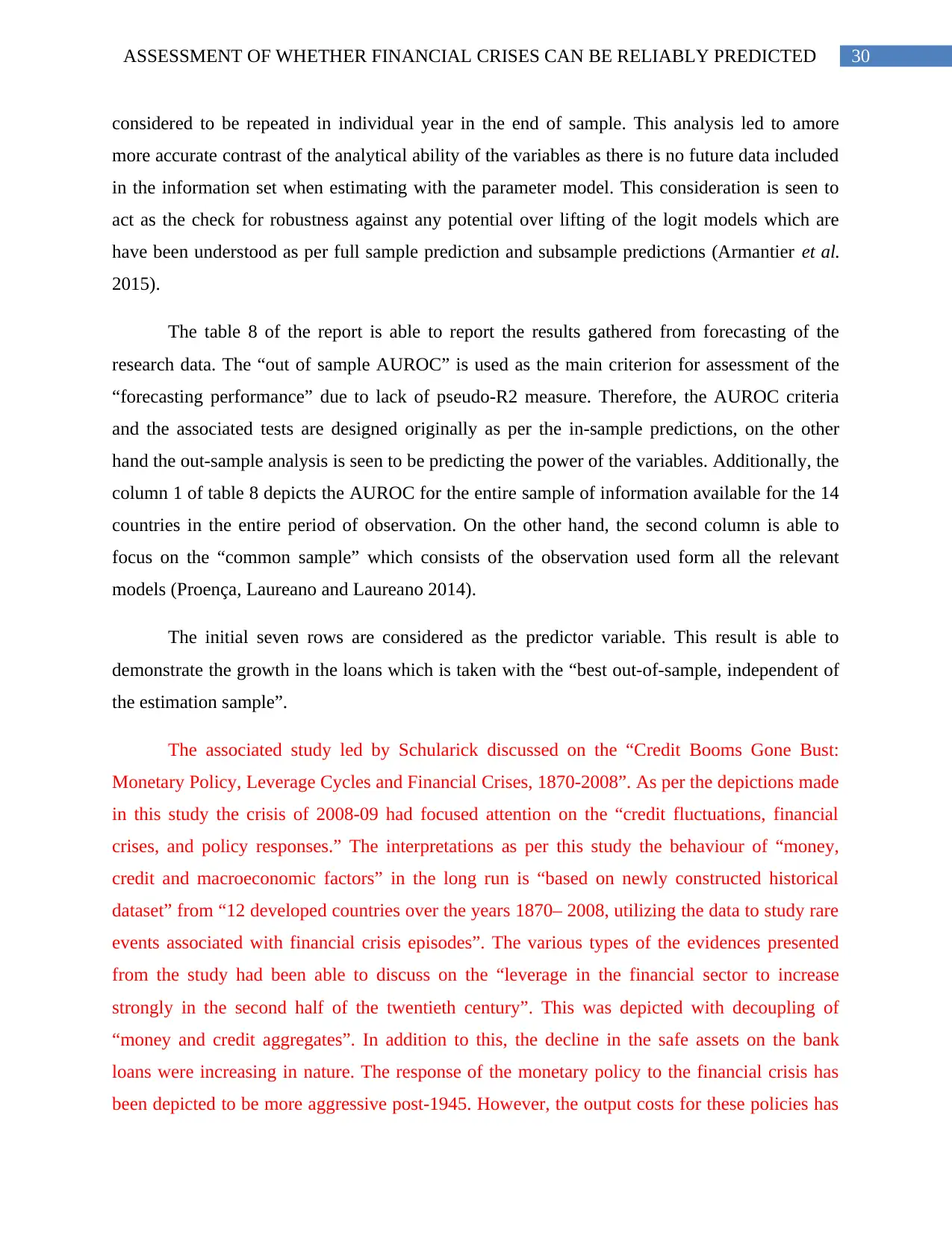
considered to be repeated in individual year in the end of sample. This analysis led to amore
more accurate contrast of the analytical ability of the variables as there is no future data included
in the information set when estimating with the parameter model. This consideration is seen to
act as the check for robustness against any potential over lifting of the logit models which are
have been understood as per full sample prediction and subsample predictions (Armantier et al.
2015).
The table 8 of the report is able to report the results gathered from forecasting of the
research data. The “out of sample AUROC” is used as the main criterion for assessment of the
“forecasting performance” due to lack of pseudo-R2 measure. Therefore, the AUROC criteria
and the associated tests are designed originally as per the in-sample predictions, on the other
hand the out-sample analysis is seen to be predicting the power of the variables. Additionally, the
column 1 of table 8 depicts the AUROC for the entire sample of information available for the 14
countries in the entire period of observation. On the other hand, the second column is able to
focus on the “common sample” which consists of the observation used form all the relevant
models (Proença, Laureano and Laureano 2014).
The initial seven rows are considered as the predictor variable. This result is able to
demonstrate the growth in the loans which is taken with the “best out-of-sample, independent of
the estimation sample”.
The associated study led by Schularick discussed on the “Credit Booms Gone Bust:
Monetary Policy, Leverage Cycles and Financial Crises, 1870-2008”. As per the depictions made
in this study the crisis of 2008-09 had focused attention on the “credit fluctuations, financial
crises, and policy responses.” The interpretations as per this study the behaviour of “money,
credit and macroeconomic factors” in the long run is “based on newly constructed historical
dataset” from “12 developed countries over the years 1870– 2008, utilizing the data to study rare
events associated with financial crisis episodes”. The various types of the evidences presented
from the study had been able to discuss on the “leverage in the financial sector to increase
strongly in the second half of the twentieth century”. This was depicted with decoupling of
“money and credit aggregates”. In addition to this, the decline in the safe assets on the bank
loans were increasing in nature. The response of the monetary policy to the financial crisis has
been depicted to be more aggressive post-1945. However, the output costs for these policies has
Paraphrase This Document
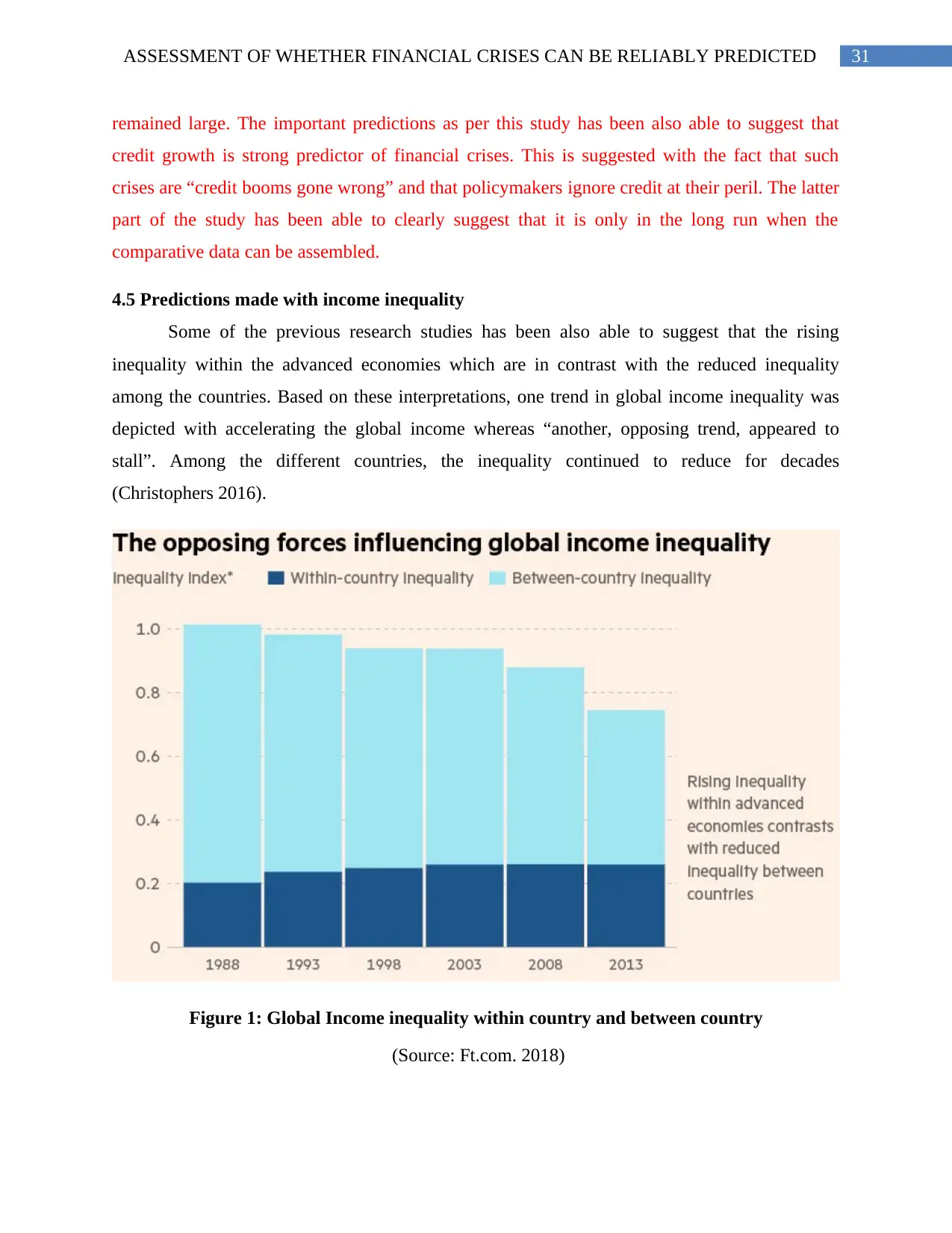
remained large. The important predictions as per this study has been also able to suggest that
credit growth is strong predictor of financial crises. This is suggested with the fact that such
crises are “credit booms gone wrong” and that policymakers ignore credit at their peril. The latter
part of the study has been able to clearly suggest that it is only in the long run when the
comparative data can be assembled.
4.5 Predictions made with income inequality
Some of the previous research studies has been also able to suggest that the rising
inequality within the advanced economies which are in contrast with the reduced inequality
among the countries. Based on these interpretations, one trend in global income inequality was
depicted with accelerating the global income whereas “another, opposing trend, appeared to
stall”. Among the different countries, the inequality continued to reduce for decades
(Christophers 2016).
Figure 1: Global Income inequality within country and between country
(Source: Ft.com. 2018)
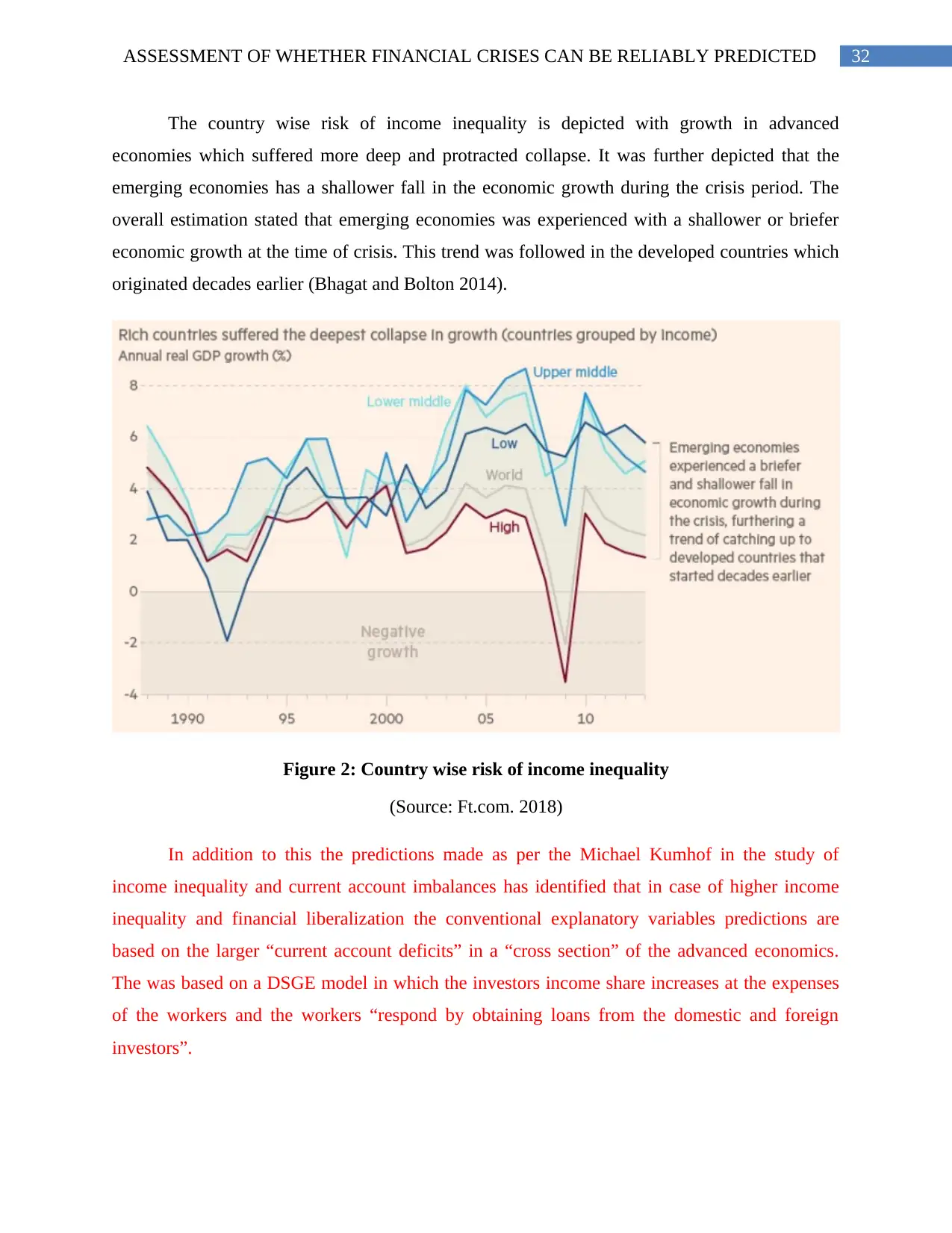
The country wise risk of income inequality is depicted with growth in advanced
economies which suffered more deep and protracted collapse. It was further depicted that the
emerging economies has a shallower fall in the economic growth during the crisis period. The
overall estimation stated that emerging economies was experienced with a shallower or briefer
economic growth at the time of crisis. This trend was followed in the developed countries which
originated decades earlier (Bhagat and Bolton 2014).
Figure 2: Country wise risk of income inequality
(Source: Ft.com. 2018)
In addition to this the predictions made as per the Michael Kumhof in the study of
income inequality and current account imbalances has identified that in case of higher income
inequality and financial liberalization the conventional explanatory variables predictions are
based on the larger “current account deficits” in a “cross section” of the advanced economics.
The was based on a DSGE model in which the investors income share increases at the expenses
of the workers and the workers “respond by obtaining loans from the domestic and foreign
investors”.
You're viewing a preview
Unlock full access by subscribing today!
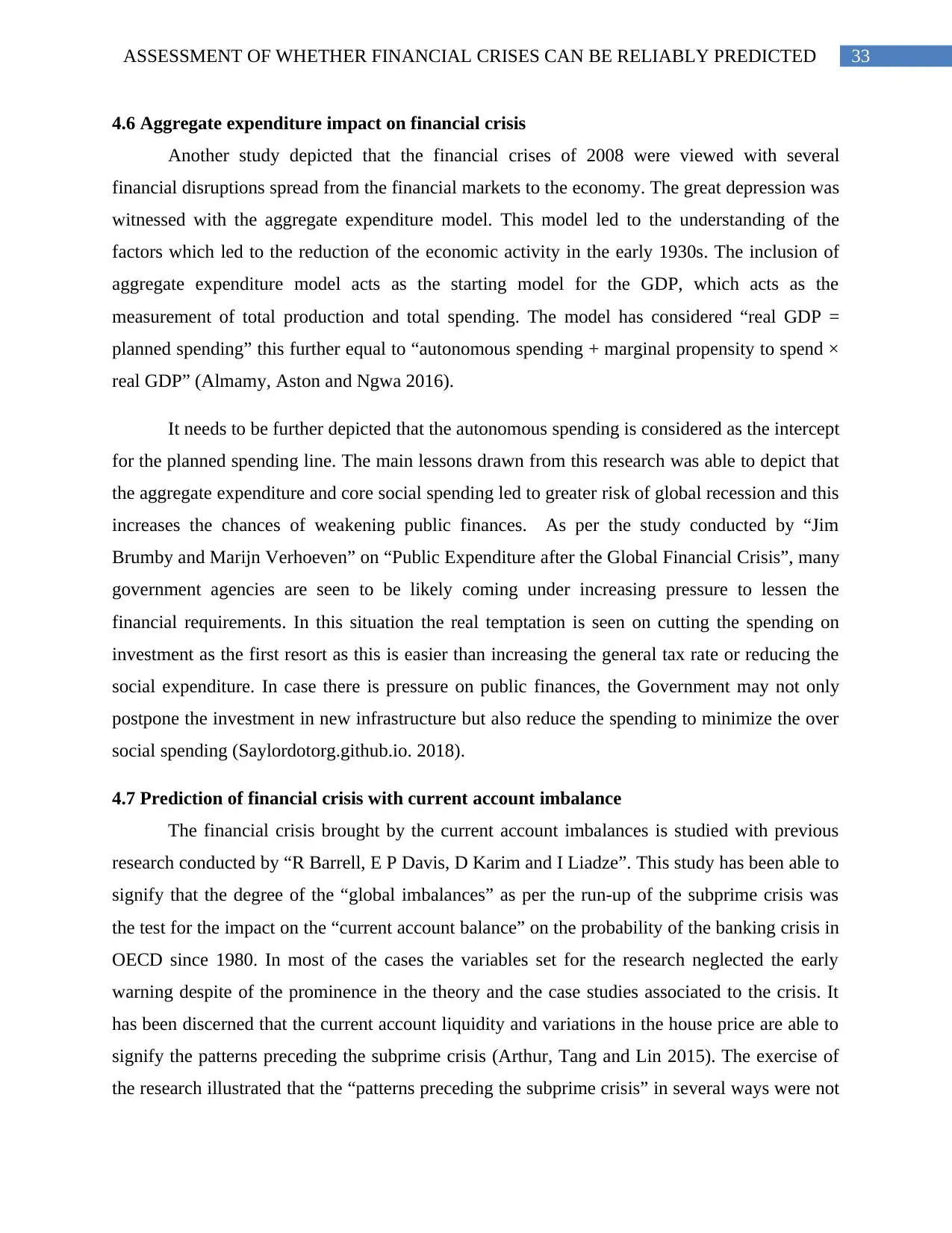
4.6 Aggregate expenditure impact on financial crisis
Another study depicted that the financial crises of 2008 were viewed with several
financial disruptions spread from the financial markets to the economy. The great depression was
witnessed with the aggregate expenditure model. This model led to the understanding of the
factors which led to the reduction of the economic activity in the early 1930s. The inclusion of
aggregate expenditure model acts as the starting model for the GDP, which acts as the
measurement of total production and total spending. The model has considered “real GDP =
planned spending” this further equal to “autonomous spending + marginal propensity to spend ×
real GDP” (Almamy, Aston and Ngwa 2016).
It needs to be further depicted that the autonomous spending is considered as the intercept
for the planned spending line. The main lessons drawn from this research was able to depict that
the aggregate expenditure and core social spending led to greater risk of global recession and this
increases the chances of weakening public finances. As per the study conducted by “Jim
Brumby and Marijn Verhoeven” on “Public Expenditure after the Global Financial Crisis”, many
government agencies are seen to be likely coming under increasing pressure to lessen the
financial requirements. In this situation the real temptation is seen on cutting the spending on
investment as the first resort as this is easier than increasing the general tax rate or reducing the
social expenditure. In case there is pressure on public finances, the Government may not only
postpone the investment in new infrastructure but also reduce the spending to minimize the over
social spending (Saylordotorg.github.io. 2018).
4.7 Prediction of financial crisis with current account imbalance
The financial crisis brought by the current account imbalances is studied with previous
research conducted by “R Barrell, E P Davis, D Karim and I Liadze”. This study has been able to
signify that the degree of the “global imbalances” as per the run-up of the subprime crisis was
the test for the impact on the “current account balance” on the probability of the banking crisis in
OECD since 1980. In most of the cases the variables set for the research neglected the early
warning despite of the prominence in the theory and the case studies associated to the crisis. It
has been discerned that the current account liquidity and variations in the house price are able to
signify the patterns preceding the subprime crisis (Arthur, Tang and Lin 2015). The exercise of
the research illustrated that the “patterns preceding the subprime crisis” in several ways were not
Paraphrase This Document
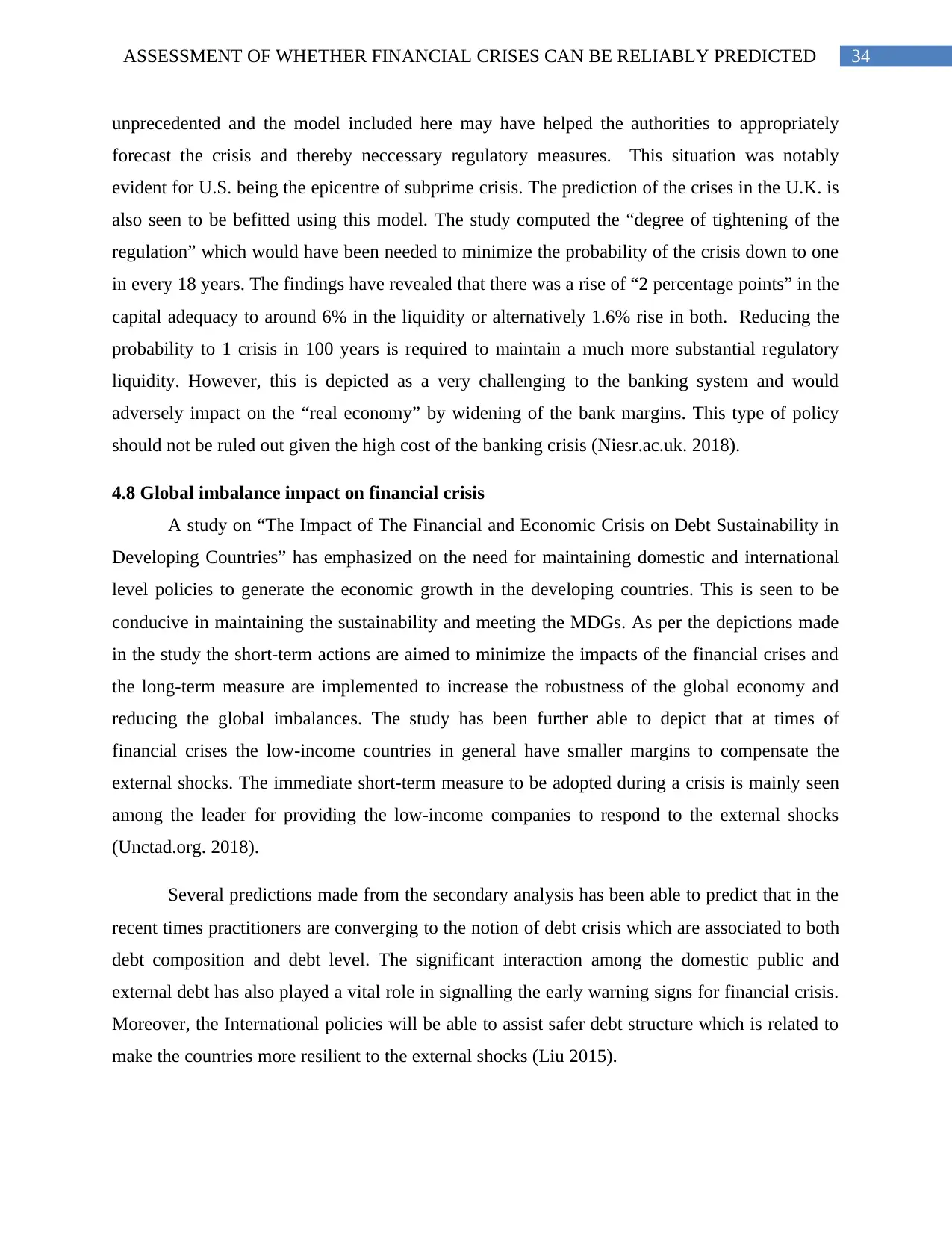
unprecedented and the model included here may have helped the authorities to appropriately
forecast the crisis and thereby neccessary regulatory measures. This situation was notably
evident for U.S. being the epicentre of subprime crisis. The prediction of the crises in the U.K. is
also seen to be befitted using this model. The study computed the “degree of tightening of the
regulation” which would have been needed to minimize the probability of the crisis down to one
in every 18 years. The findings have revealed that there was a rise of “2 percentage points” in the
capital adequacy to around 6% in the liquidity or alternatively 1.6% rise in both. Reducing the
probability to 1 crisis in 100 years is required to maintain a much more substantial regulatory
liquidity. However, this is depicted as a very challenging to the banking system and would
adversely impact on the “real economy” by widening of the bank margins. This type of policy
should not be ruled out given the high cost of the banking crisis (Niesr.ac.uk. 2018).
4.8 Global imbalance impact on financial crisis
A study on “The Impact of The Financial and Economic Crisis on Debt Sustainability in
Developing Countries” has emphasized on the need for maintaining domestic and international
level policies to generate the economic growth in the developing countries. This is seen to be
conducive in maintaining the sustainability and meeting the MDGs. As per the depictions made
in the study the short-term actions are aimed to minimize the impacts of the financial crises and
the long-term measure are implemented to increase the robustness of the global economy and
reducing the global imbalances. The study has been further able to depict that at times of
financial crises the low-income countries in general have smaller margins to compensate the
external shocks. The immediate short-term measure to be adopted during a crisis is mainly seen
among the leader for providing the low-income companies to respond to the external shocks
(Unctad.org. 2018).
Several predictions made from the secondary analysis has been able to predict that in the
recent times practitioners are converging to the notion of debt crisis which are associated to both
debt composition and debt level. The significant interaction among the domestic public and
external debt has also played a vital role in signalling the early warning signs for financial crisis.
Moreover, the International policies will be able to assist safer debt structure which is related to
make the countries more resilient to the external shocks (Liu 2015).
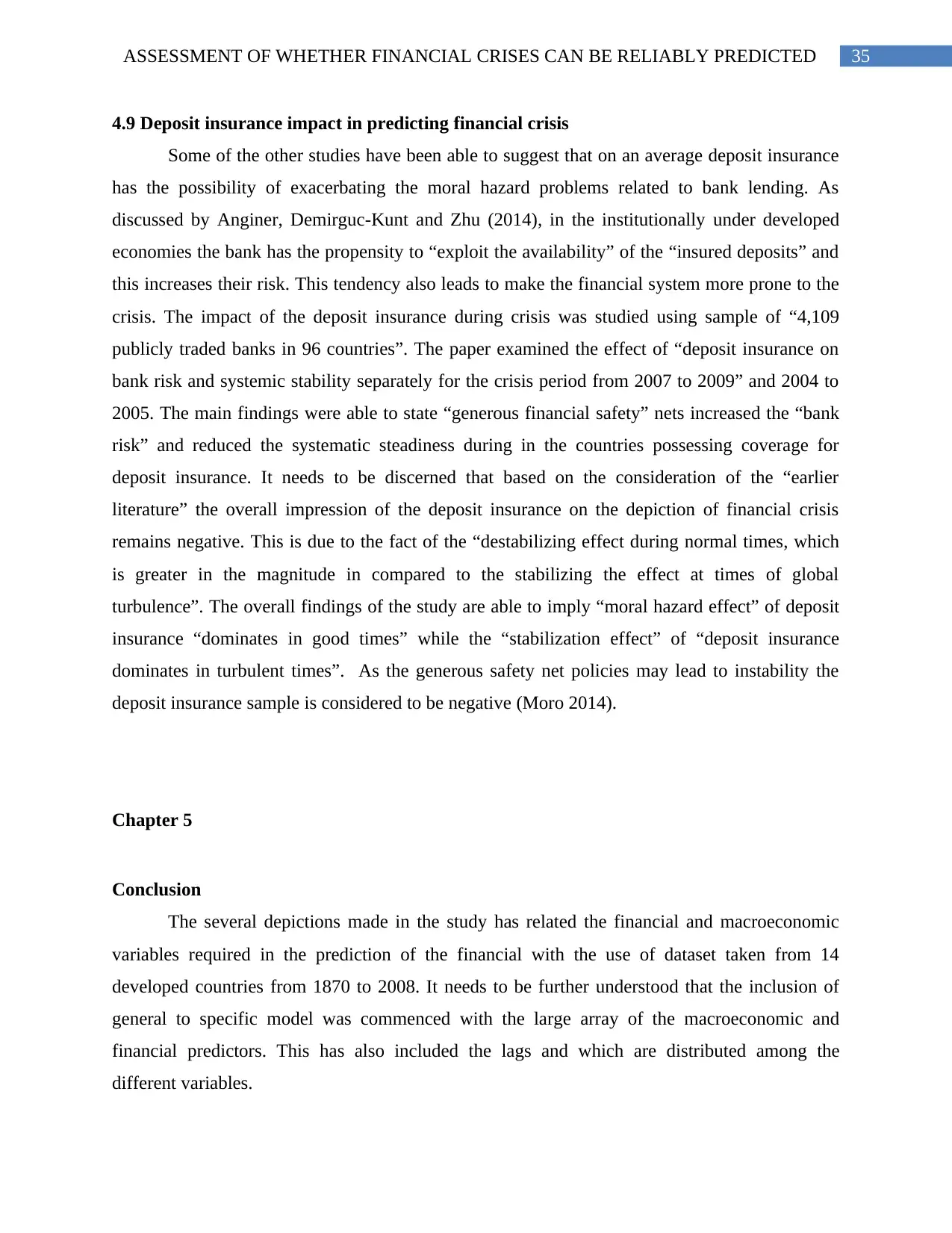
4.9 Deposit insurance impact in predicting financial crisis
Some of the other studies have been able to suggest that on an average deposit insurance
has the possibility of exacerbating the moral hazard problems related to bank lending. As
discussed by Anginer, Demirguc-Kunt and Zhu (2014), in the institutionally under developed
economies the bank has the propensity to “exploit the availability” of the “insured deposits” and
this increases their risk. This tendency also leads to make the financial system more prone to the
crisis. The impact of the deposit insurance during crisis was studied using sample of “4,109
publicly traded banks in 96 countries”. The paper examined the effect of “deposit insurance on
bank risk and systemic stability separately for the crisis period from 2007 to 2009” and 2004 to
2005. The main findings were able to state “generous financial safety” nets increased the “bank
risk” and reduced the systematic steadiness during in the countries possessing coverage for
deposit insurance. It needs to be discerned that based on the consideration of the “earlier
literature” the overall impression of the deposit insurance on the depiction of financial crisis
remains negative. This is due to the fact of the “destabilizing effect during normal times, which
is greater in the magnitude in compared to the stabilizing the effect at times of global
turbulence”. The overall findings of the study are able to imply “moral hazard effect” of deposit
insurance “dominates in good times” while the “stabilization effect” of “deposit insurance
dominates in turbulent times”. As the generous safety net policies may lead to instability the
deposit insurance sample is considered to be negative (Moro 2014).
Chapter 5
Conclusion
The several depictions made in the study has related the financial and macroeconomic
variables required in the prediction of the financial with the use of dataset taken from 14
developed countries from 1870 to 2008. It needs to be further understood that the inclusion of
general to specific model was commenced with the large array of the macroeconomic and
financial predictors. This has also included the lags and which are distributed among the
different variables.
You're viewing a preview
Unlock full access by subscribing today!
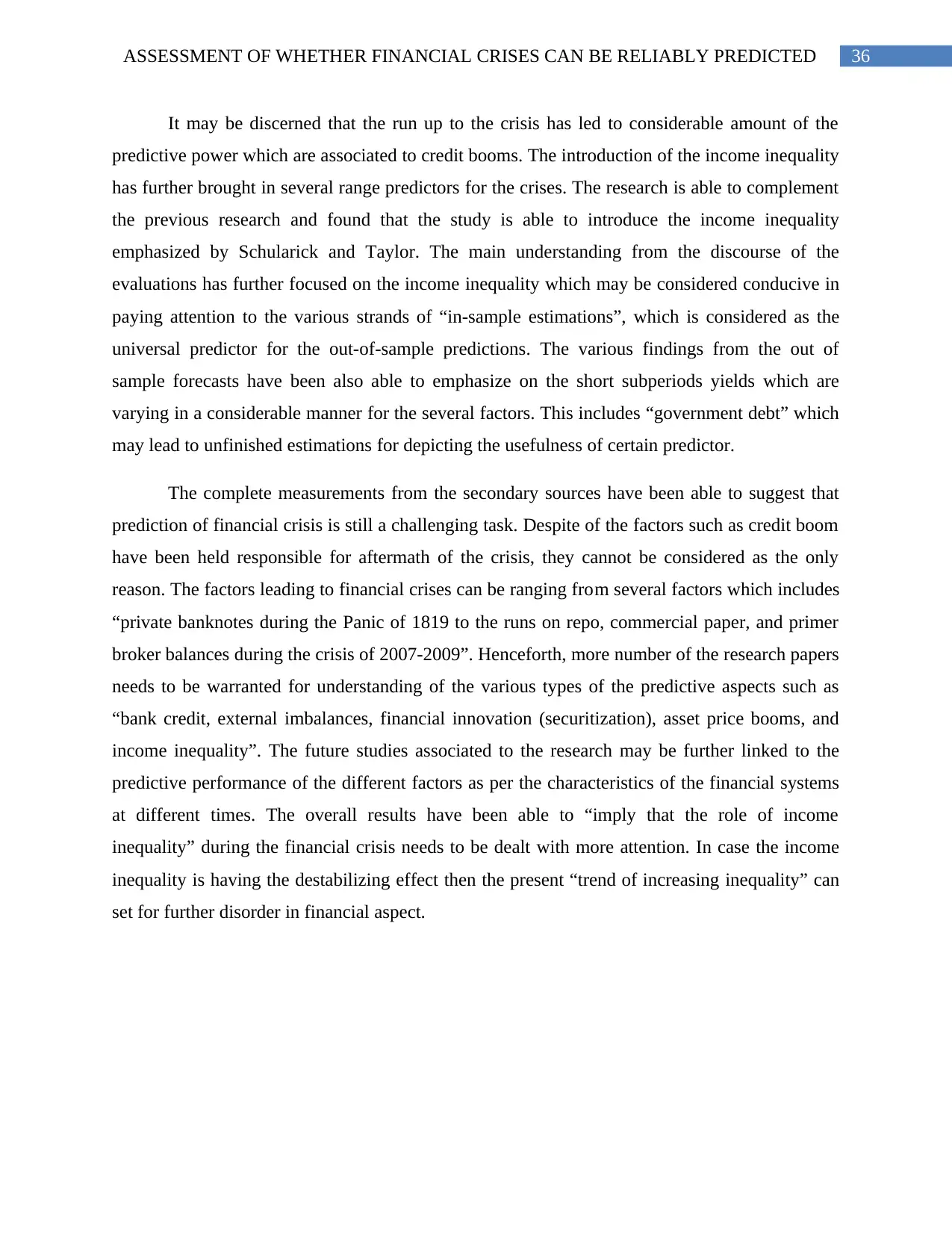
It may be discerned that the run up to the crisis has led to considerable amount of the
predictive power which are associated to credit booms. The introduction of the income inequality
has further brought in several range predictors for the crises. The research is able to complement
the previous research and found that the study is able to introduce the income inequality
emphasized by Schularick and Taylor. The main understanding from the discourse of the
evaluations has further focused on the income inequality which may be considered conducive in
paying attention to the various strands of “in-sample estimations”, which is considered as the
universal predictor for the out-of-sample predictions. The various findings from the out of
sample forecasts have been also able to emphasize on the short subperiods yields which are
varying in a considerable manner for the several factors. This includes “government debt” which
may lead to unfinished estimations for depicting the usefulness of certain predictor.
The complete measurements from the secondary sources have been able to suggest that
prediction of financial crisis is still a challenging task. Despite of the factors such as credit boom
have been held responsible for aftermath of the crisis, they cannot be considered as the only
reason. The factors leading to financial crises can be ranging from several factors which includes
“private banknotes during the Panic of 1819 to the runs on repo, commercial paper, and primer
broker balances during the crisis of 2007-2009”. Henceforth, more number of the research papers
needs to be warranted for understanding of the various types of the predictive aspects such as
“bank credit, external imbalances, financial innovation (securitization), asset price booms, and
income inequality”. The future studies associated to the research may be further linked to the
predictive performance of the different factors as per the characteristics of the financial systems
at different times. The overall results have been able to “imply that the role of income
inequality” during the financial crisis needs to be dealt with more attention. In case the income
inequality is having the destabilizing effect then the present “trend of increasing inequality” can
set for further disorder in financial aspect.
Paraphrase This Document
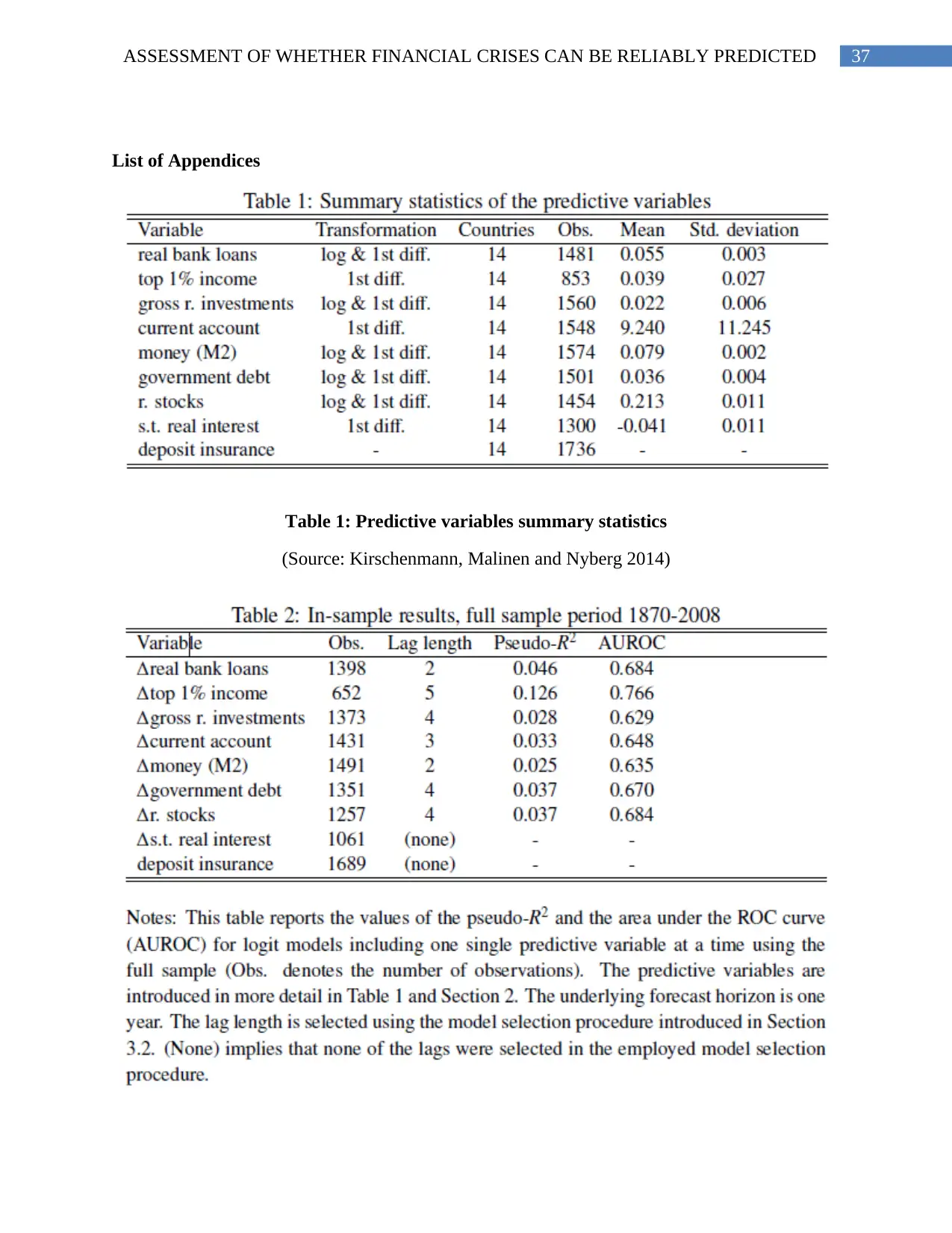
List of Appendices
Table 1: Predictive variables summary statistics
(Source: Kirschenmann, Malinen and Nyberg 2014)
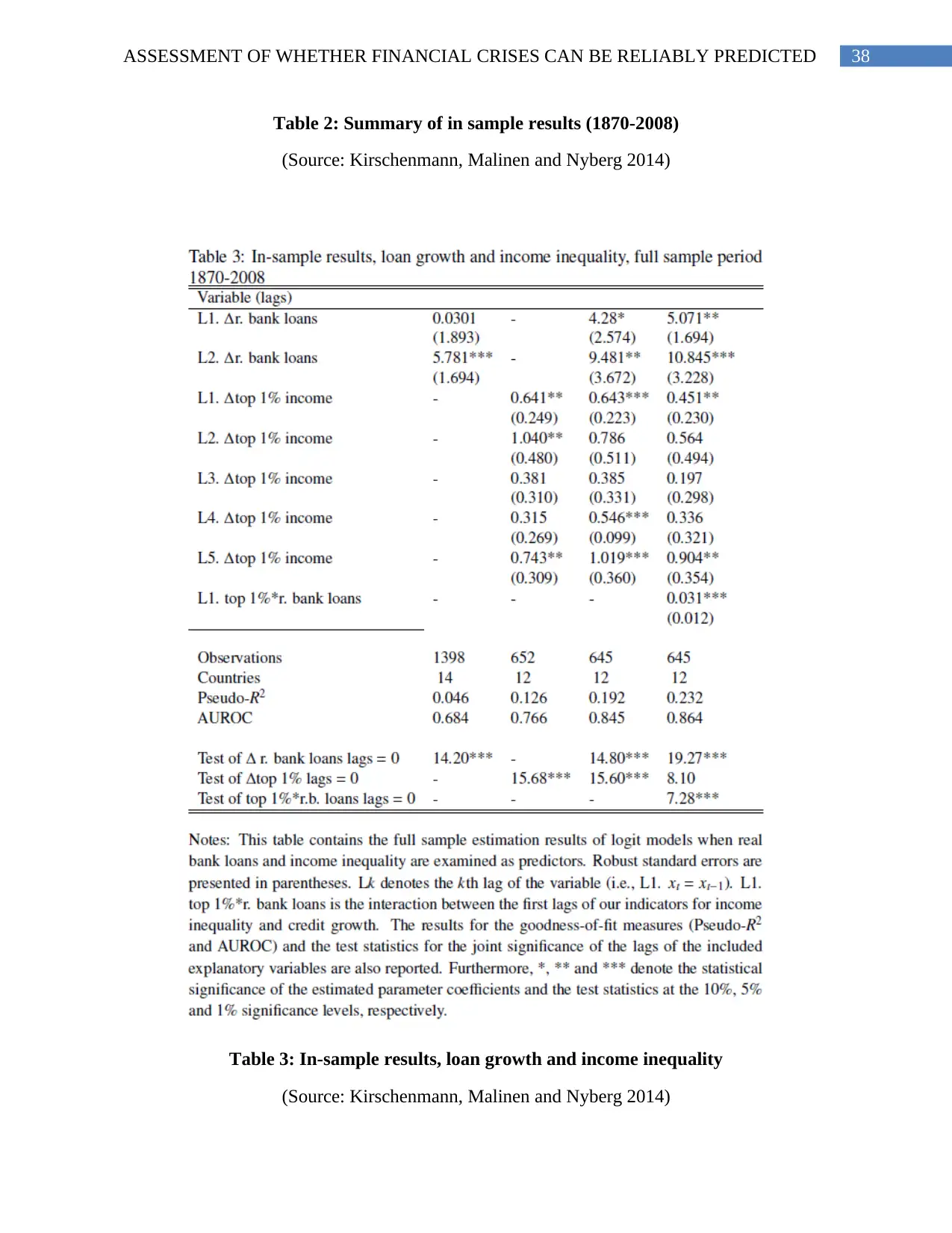
Table 2: Summary of in sample results (1870-2008)
(Source: Kirschenmann, Malinen and Nyberg 2014)
Table 3: In-sample results, loan growth and income inequality
(Source: Kirschenmann, Malinen and Nyberg 2014)
You're viewing a preview
Unlock full access by subscribing today!
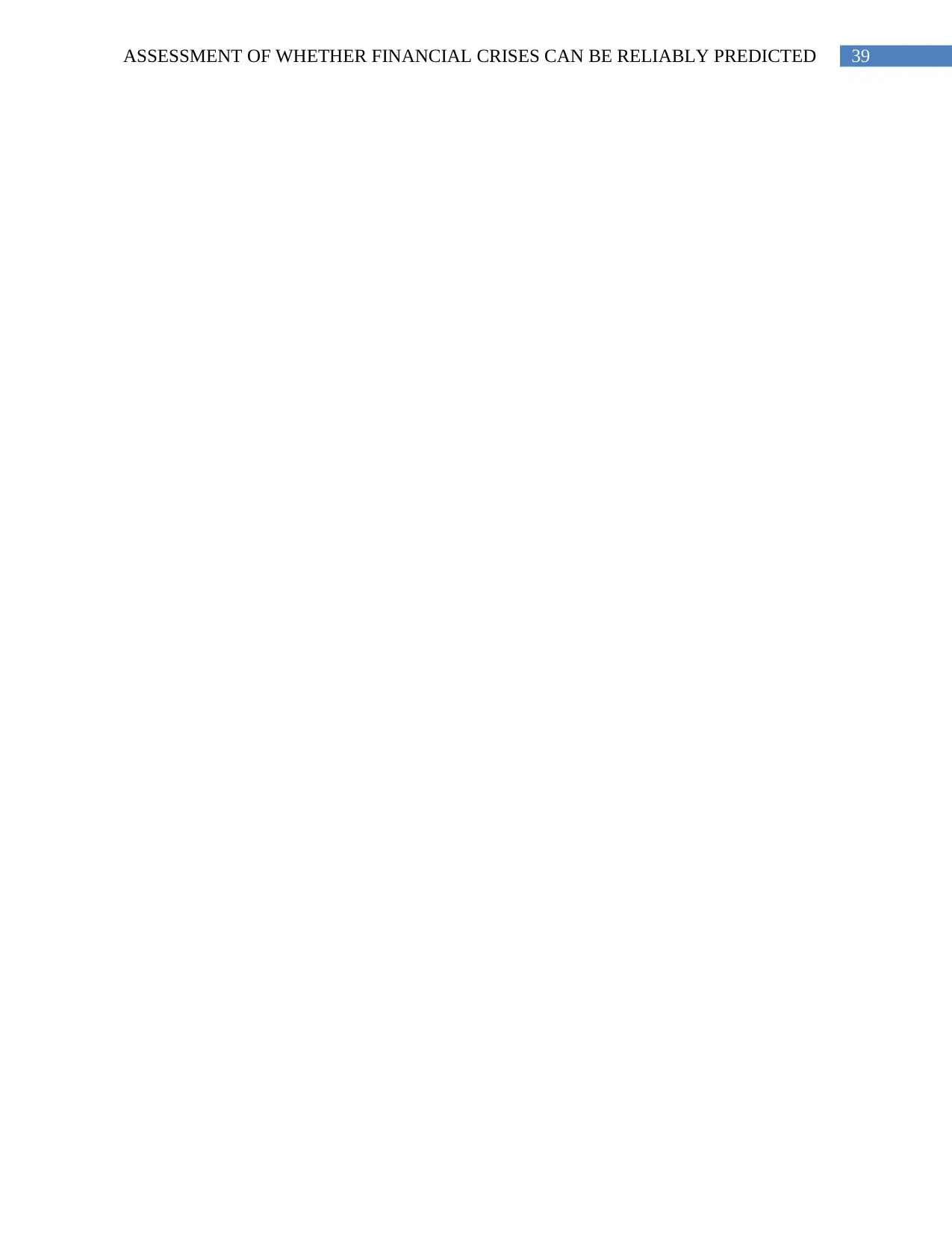
Paraphrase This Document
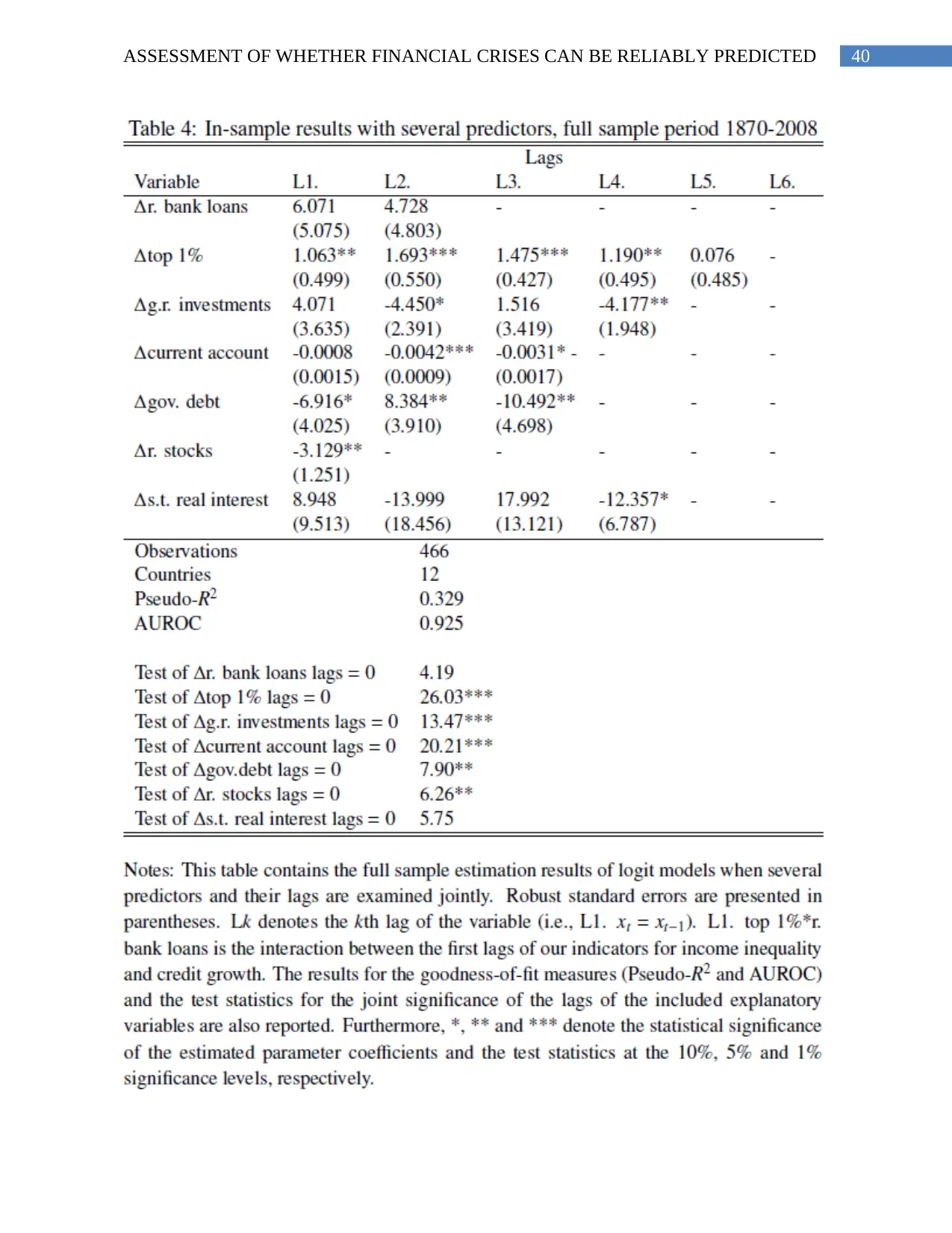
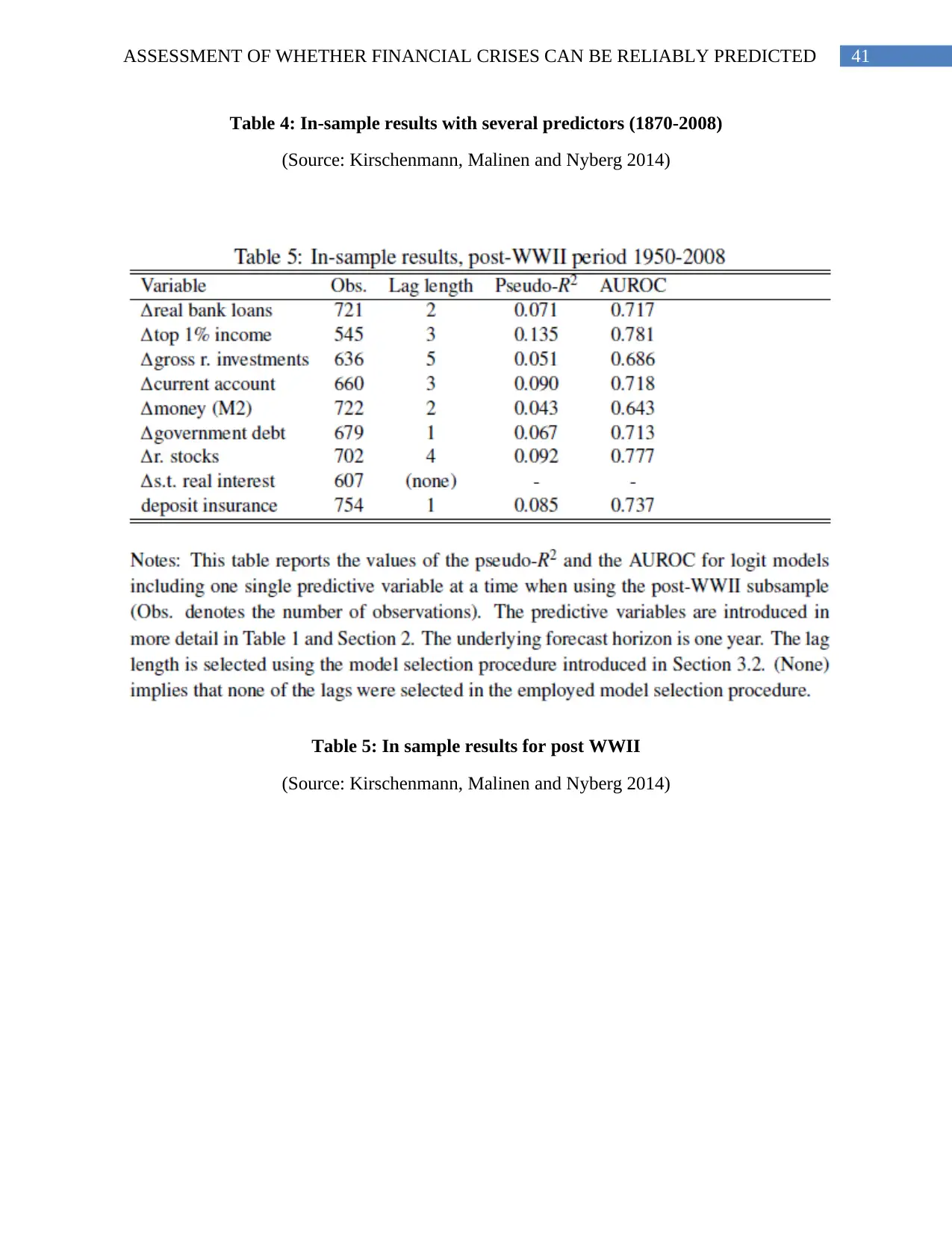
Table 4: In-sample results with several predictors (1870-2008)
(Source: Kirschenmann, Malinen and Nyberg 2014)
Table 5: In sample results for post WWII
(Source: Kirschenmann, Malinen and Nyberg 2014)
You're viewing a preview
Unlock full access by subscribing today!
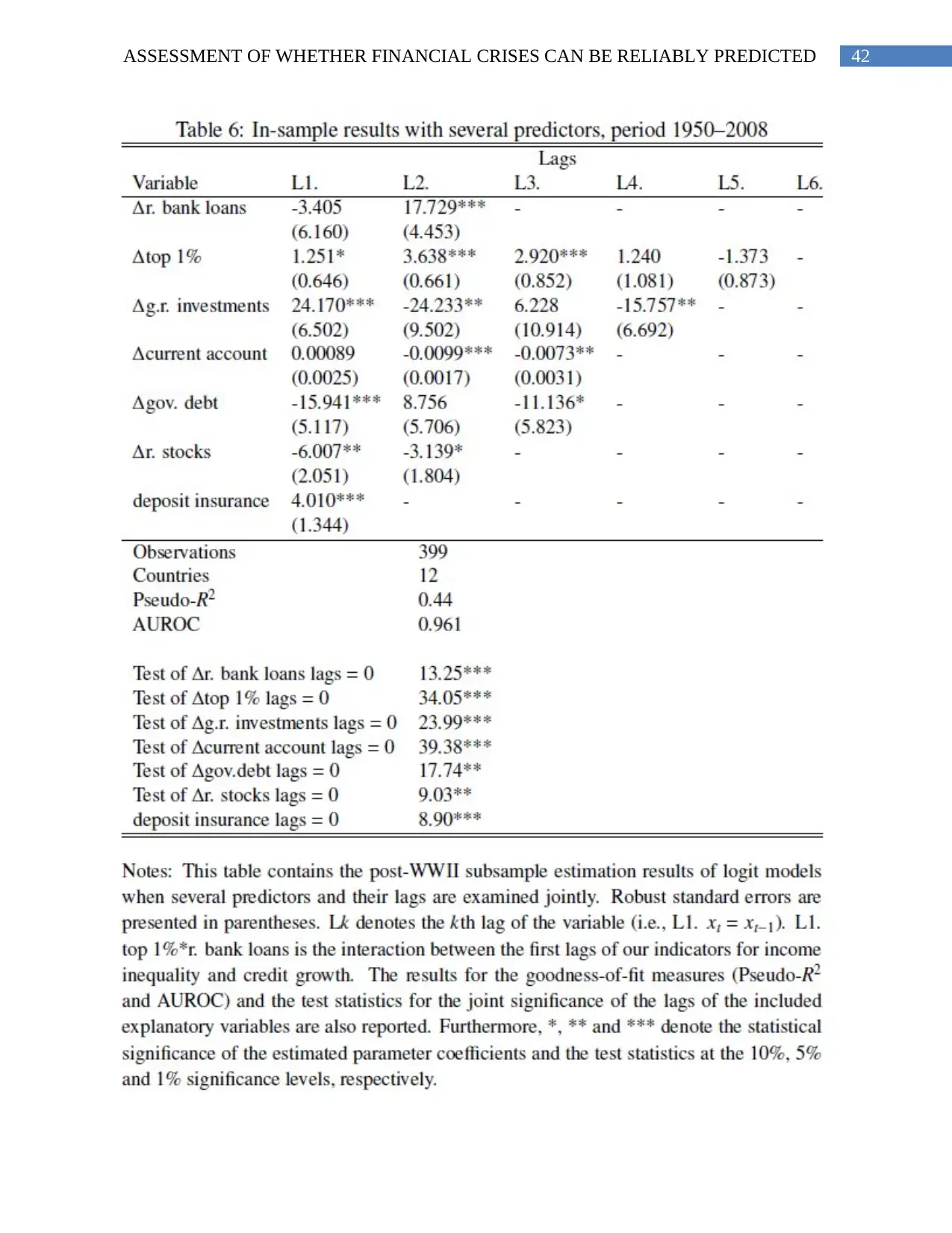
Paraphrase This Document
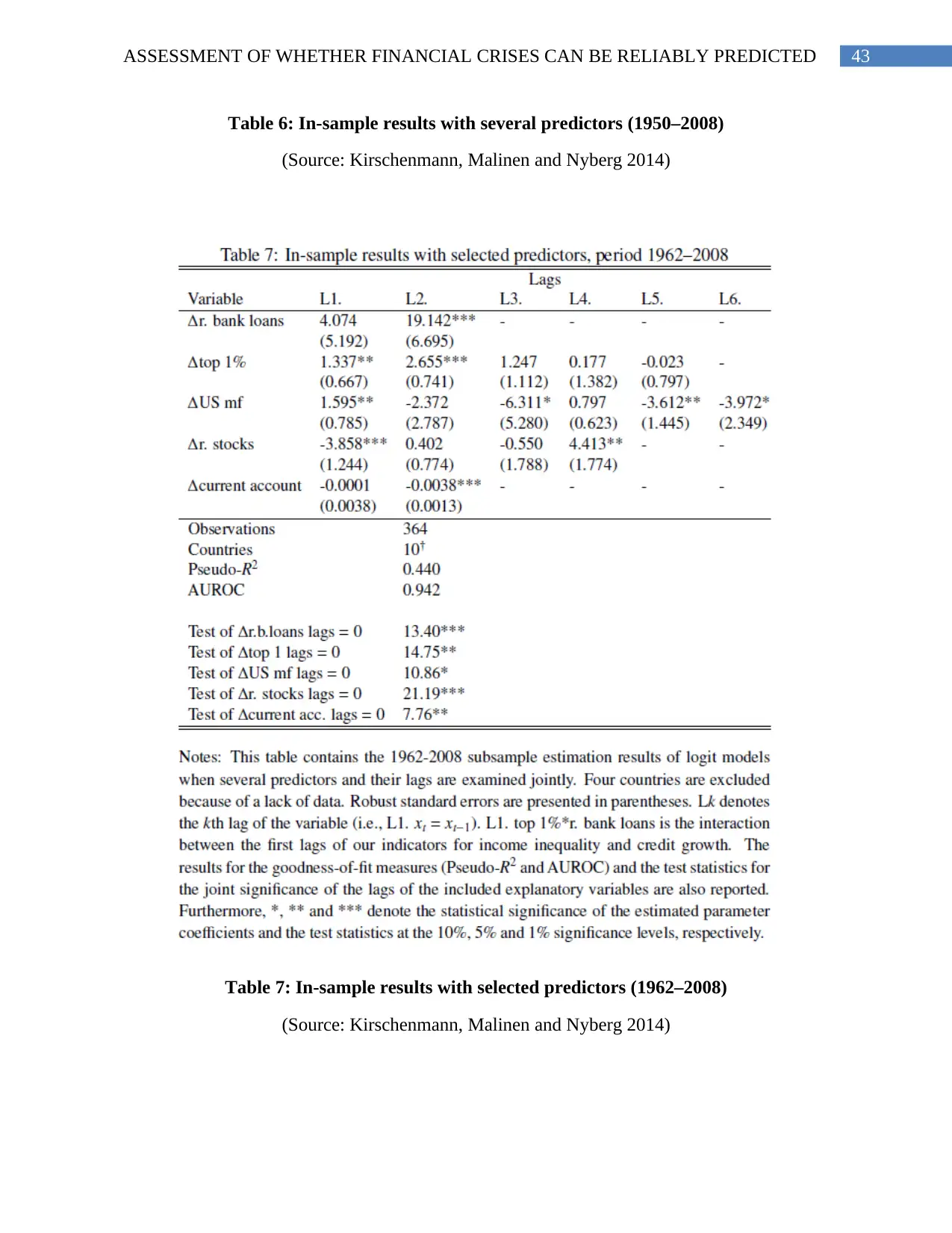
Table 6: In-sample results with several predictors (1950–2008)
(Source: Kirschenmann, Malinen and Nyberg 2014)
Table 7: In-sample results with selected predictors (1962–2008)
(Source: Kirschenmann, Malinen and Nyberg 2014)
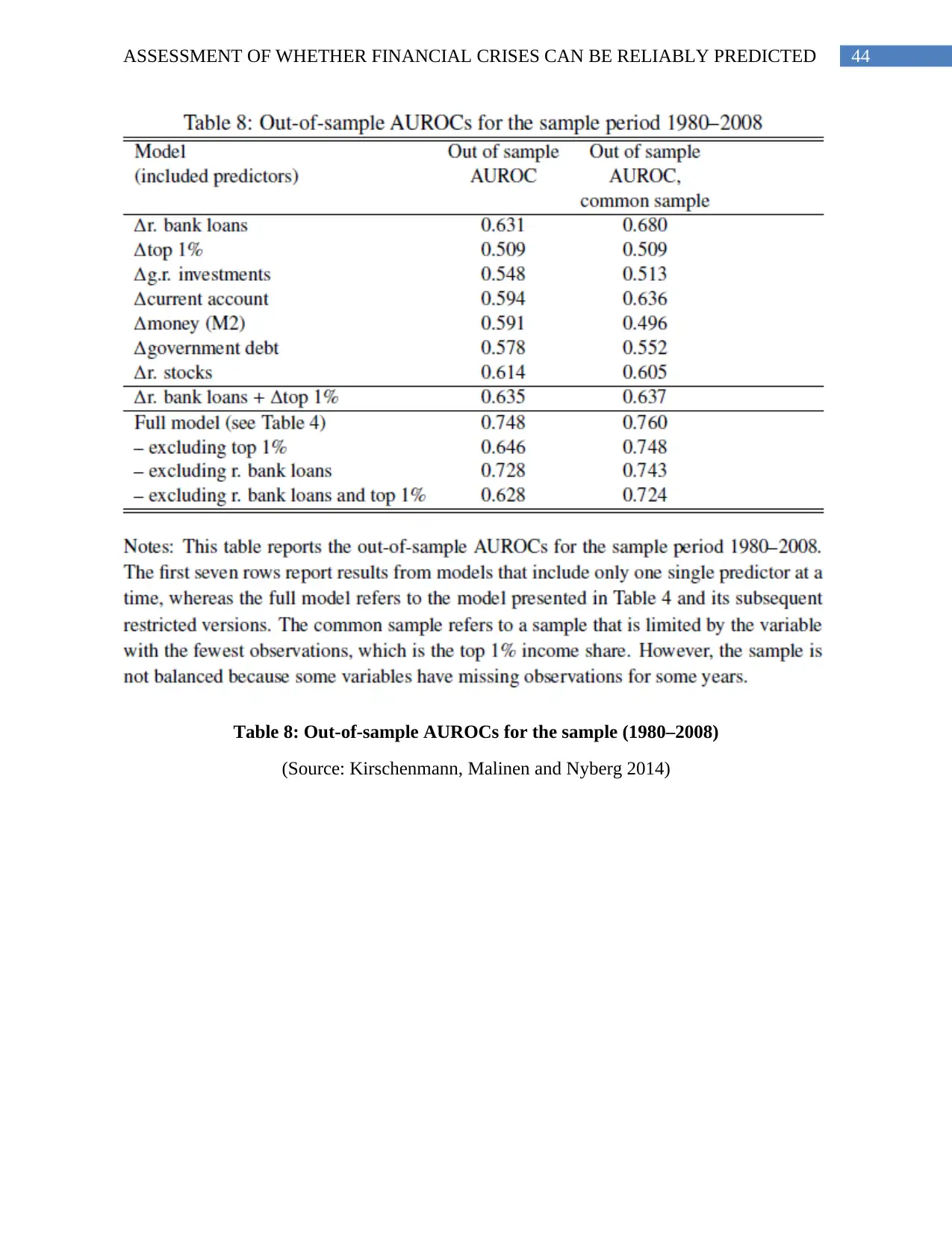
Table 8: Out-of-sample AUROCs for the sample (1980–2008)
(Source: Kirschenmann, Malinen and Nyberg 2014)
You're viewing a preview
Unlock full access by subscribing today!
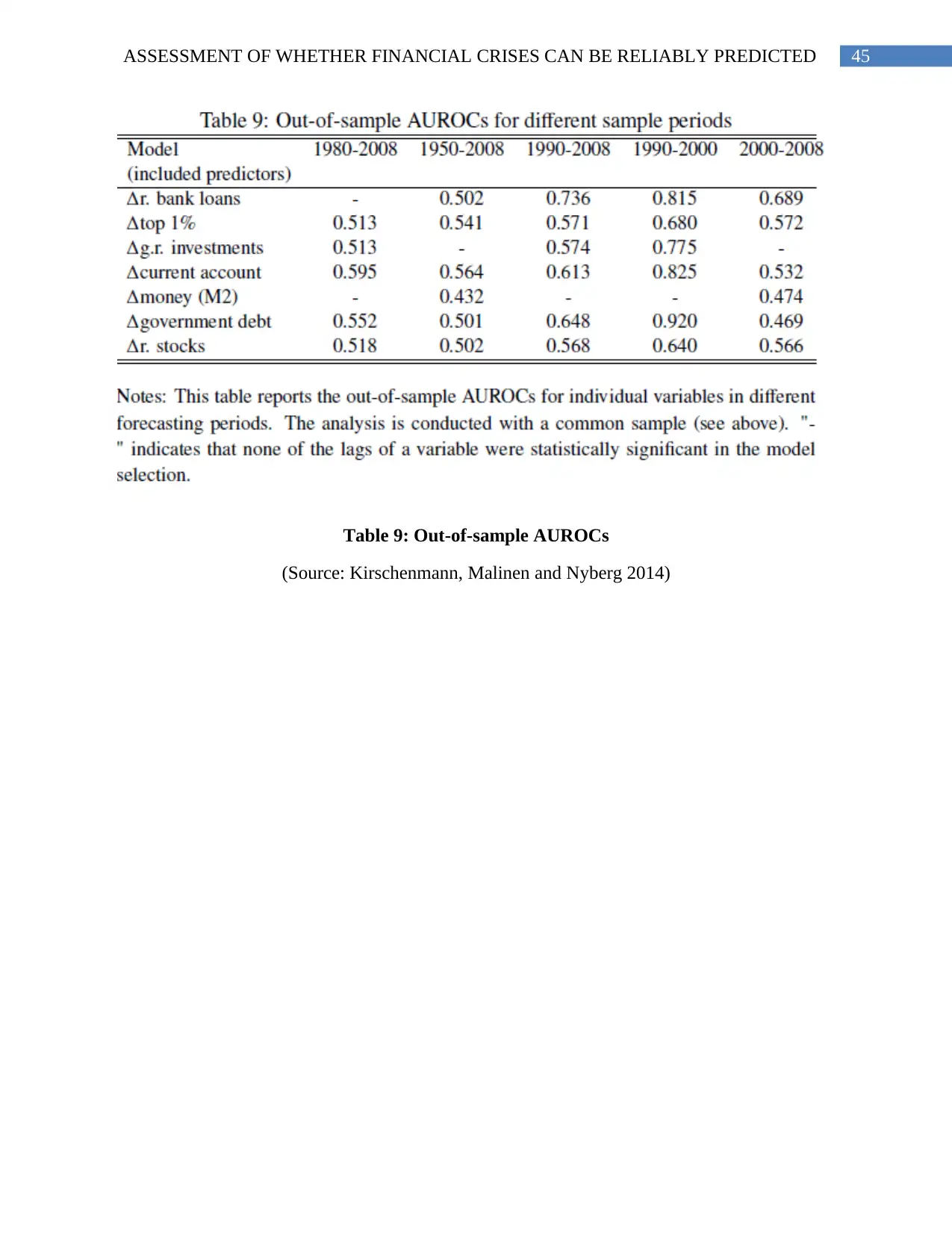
Table 9: Out-of-sample AUROCs
(Source: Kirschenmann, Malinen and Nyberg 2014)
Paraphrase This Document
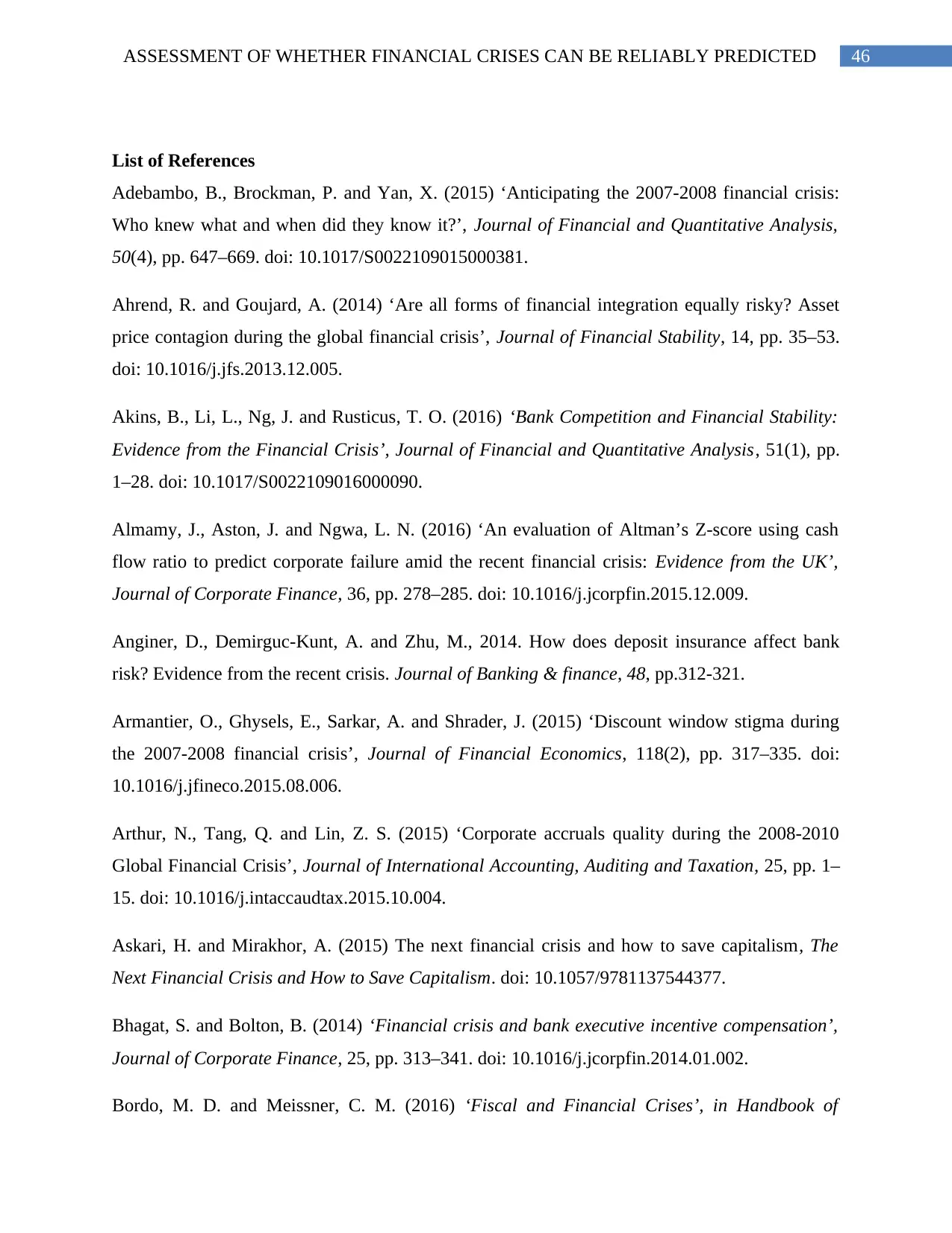
List of References
Adebambo, B., Brockman, P. and Yan, X. (2015) ‘Anticipating the 2007-2008 financial crisis:
Who knew what and when did they know it?’, Journal of Financial and Quantitative Analysis,
50(4), pp. 647–669. doi: 10.1017/S0022109015000381.
Ahrend, R. and Goujard, A. (2014) ‘Are all forms of financial integration equally risky? Asset
price contagion during the global financial crisis’, Journal of Financial Stability, 14, pp. 35–53.
doi: 10.1016/j.jfs.2013.12.005.
Akins, B., Li, L., Ng, J. and Rusticus, T. O. (2016) ‘Bank Competition and Financial Stability:
Evidence from the Financial Crisis’, Journal of Financial and Quantitative Analysis, 51(1), pp.
1–28. doi: 10.1017/S0022109016000090.
Almamy, J., Aston, J. and Ngwa, L. N. (2016) ‘An evaluation of Altman’s Z-score using cash
flow ratio to predict corporate failure amid the recent financial crisis: Evidence from the UK’,
Journal of Corporate Finance, 36, pp. 278–285. doi: 10.1016/j.jcorpfin.2015.12.009.
Anginer, D., Demirguc-Kunt, A. and Zhu, M., 2014. How does deposit insurance affect bank
risk? Evidence from the recent crisis. Journal of Banking & finance, 48, pp.312-321.
Armantier, O., Ghysels, E., Sarkar, A. and Shrader, J. (2015) ‘Discount window stigma during
the 2007-2008 financial crisis’, Journal of Financial Economics, 118(2), pp. 317–335. doi:
10.1016/j.jfineco.2015.08.006.
Arthur, N., Tang, Q. and Lin, Z. S. (2015) ‘Corporate accruals quality during the 2008-2010
Global Financial Crisis’, Journal of International Accounting, Auditing and Taxation, 25, pp. 1–
15. doi: 10.1016/j.intaccaudtax.2015.10.004.
Askari, H. and Mirakhor, A. (2015) The next financial crisis and how to save capitalism, The
Next Financial Crisis and How to Save Capitalism. doi: 10.1057/9781137544377.
Bhagat, S. and Bolton, B. (2014) ‘Financial crisis and bank executive incentive compensation’,
Journal of Corporate Finance, 25, pp. 313–341. doi: 10.1016/j.jcorpfin.2014.01.002.
Bordo, M. D. and Meissner, C. M. (2016) ‘Fiscal and Financial Crises’, in Handbook of
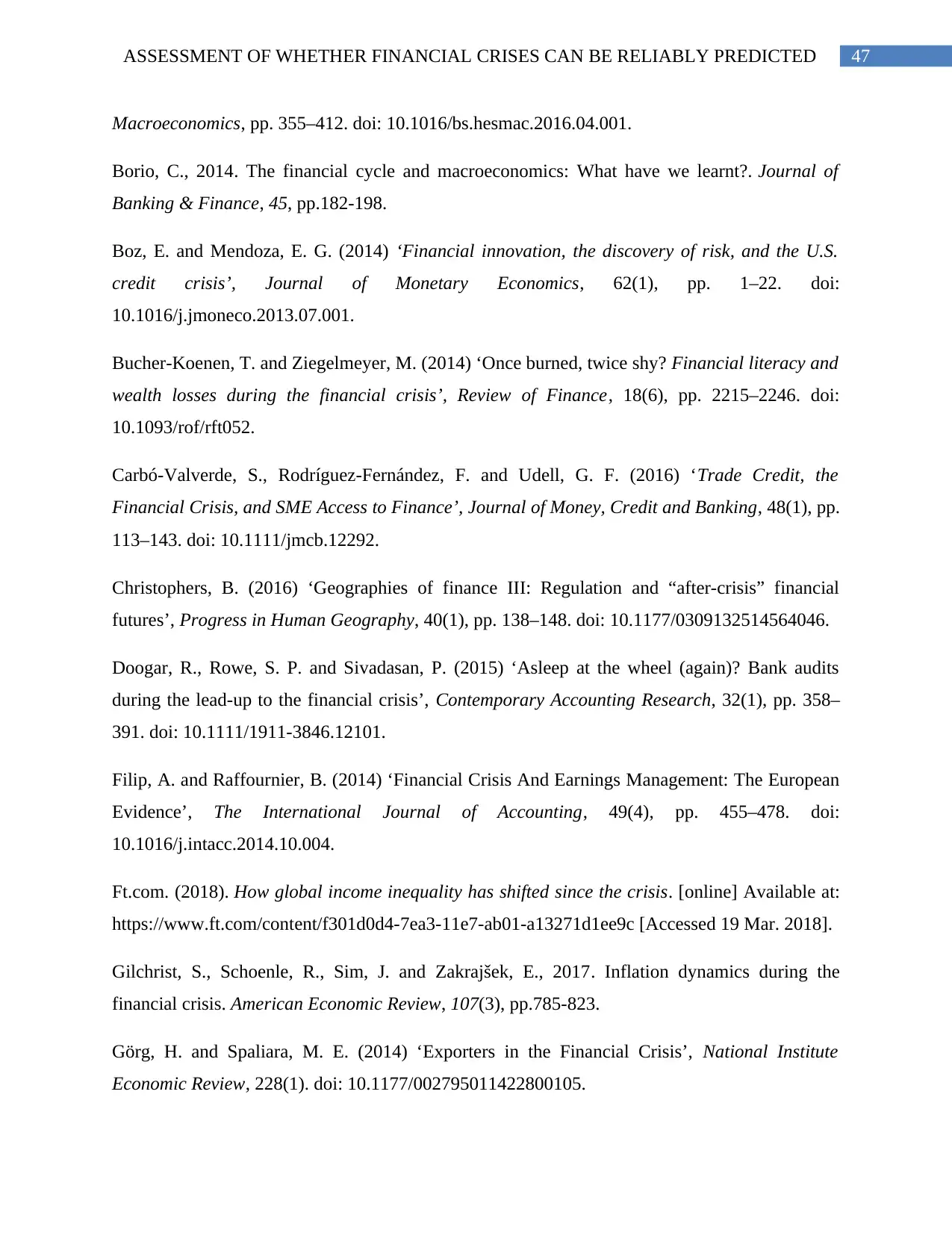
Macroeconomics, pp. 355–412. doi: 10.1016/bs.hesmac.2016.04.001.
Borio, C., 2014. The financial cycle and macroeconomics: What have we learnt?. Journal of
Banking & Finance, 45, pp.182-198.
Boz, E. and Mendoza, E. G. (2014) ‘Financial innovation, the discovery of risk, and the U.S.
credit crisis’, Journal of Monetary Economics, 62(1), pp. 1–22. doi:
10.1016/j.jmoneco.2013.07.001.
Bucher-Koenen, T. and Ziegelmeyer, M. (2014) ‘Once burned, twice shy? Financial literacy and
wealth losses during the financial crisis’, Review of Finance, 18(6), pp. 2215–2246. doi:
10.1093/rof/rft052.
Carbó-Valverde, S., Rodríguez-Fernández, F. and Udell, G. F. (2016) ‘Trade Credit, the
Financial Crisis, and SME Access to Finance’, Journal of Money, Credit and Banking, 48(1), pp.
113–143. doi: 10.1111/jmcb.12292.
Christophers, B. (2016) ‘Geographies of finance III: Regulation and “after-crisis” financial
futures’, Progress in Human Geography, 40(1), pp. 138–148. doi: 10.1177/0309132514564046.
Doogar, R., Rowe, S. P. and Sivadasan, P. (2015) ‘Asleep at the wheel (again)? Bank audits
during the lead-up to the financial crisis’, Contemporary Accounting Research, 32(1), pp. 358–
391. doi: 10.1111/1911-3846.12101.
Filip, A. and Raffournier, B. (2014) ‘Financial Crisis And Earnings Management: The European
Evidence’, The International Journal of Accounting, 49(4), pp. 455–478. doi:
10.1016/j.intacc.2014.10.004.
Ft.com. (2018). How global income inequality has shifted since the crisis. [online] Available at:
https://www.ft.com/content/f301d0d4-7ea3-11e7-ab01-a13271d1ee9c [Accessed 19 Mar. 2018].
Gilchrist, S., Schoenle, R., Sim, J. and Zakrajšek, E., 2017. Inflation dynamics during the
financial crisis. American Economic Review, 107(3), pp.785-823.
Görg, H. and Spaliara, M. E. (2014) ‘Exporters in the Financial Crisis’, National Institute
Economic Review, 228(1). doi: 10.1177/002795011422800105.
You're viewing a preview
Unlock full access by subscribing today!
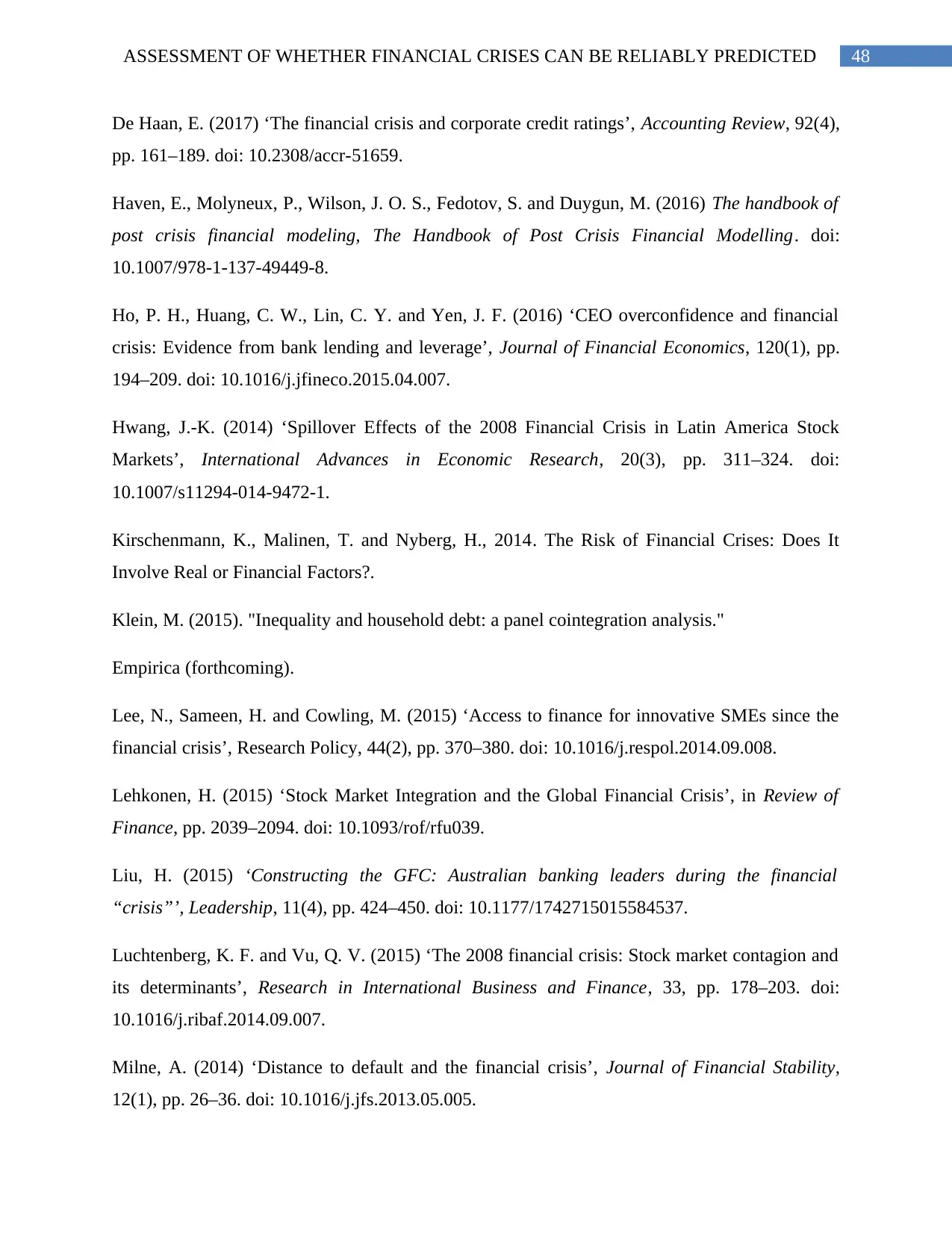
De Haan, E. (2017) ‘The financial crisis and corporate credit ratings’, Accounting Review, 92(4),
pp. 161–189. doi: 10.2308/accr-51659.
Haven, E., Molyneux, P., Wilson, J. O. S., Fedotov, S. and Duygun, M. (2016) The handbook of
post crisis financial modeling, The Handbook of Post Crisis Financial Modelling. doi:
10.1007/978-1-137-49449-8.
Ho, P. H., Huang, C. W., Lin, C. Y. and Yen, J. F. (2016) ‘CEO overconfidence and financial
crisis: Evidence from bank lending and leverage’, Journal of Financial Economics, 120(1), pp.
194–209. doi: 10.1016/j.jfineco.2015.04.007.
Hwang, J.-K. (2014) ‘Spillover Effects of the 2008 Financial Crisis in Latin America Stock
Markets’, International Advances in Economic Research, 20(3), pp. 311–324. doi:
10.1007/s11294-014-9472-1.
Kirschenmann, K., Malinen, T. and Nyberg, H., 2014. The Risk of Financial Crises: Does It
Involve Real or Financial Factors?.
Klein, M. (2015). "Inequality and household debt: a panel cointegration analysis."
Empirica (forthcoming).
Lee, N., Sameen, H. and Cowling, M. (2015) ‘Access to finance for innovative SMEs since the
financial crisis’, Research Policy, 44(2), pp. 370–380. doi: 10.1016/j.respol.2014.09.008.
Lehkonen, H. (2015) ‘Stock Market Integration and the Global Financial Crisis’, in Review of
Finance, pp. 2039–2094. doi: 10.1093/rof/rfu039.
Liu, H. (2015) ‘Constructing the GFC: Australian banking leaders during the financial
“crisis”’, Leadership, 11(4), pp. 424–450. doi: 10.1177/1742715015584537.
Luchtenberg, K. F. and Vu, Q. V. (2015) ‘The 2008 financial crisis: Stock market contagion and
its determinants’, Research in International Business and Finance, 33, pp. 178–203. doi:
10.1016/j.ribaf.2014.09.007.
Milne, A. (2014) ‘Distance to default and the financial crisis’, Journal of Financial Stability,
12(1), pp. 26–36. doi: 10.1016/j.jfs.2013.05.005.
Paraphrase This Document
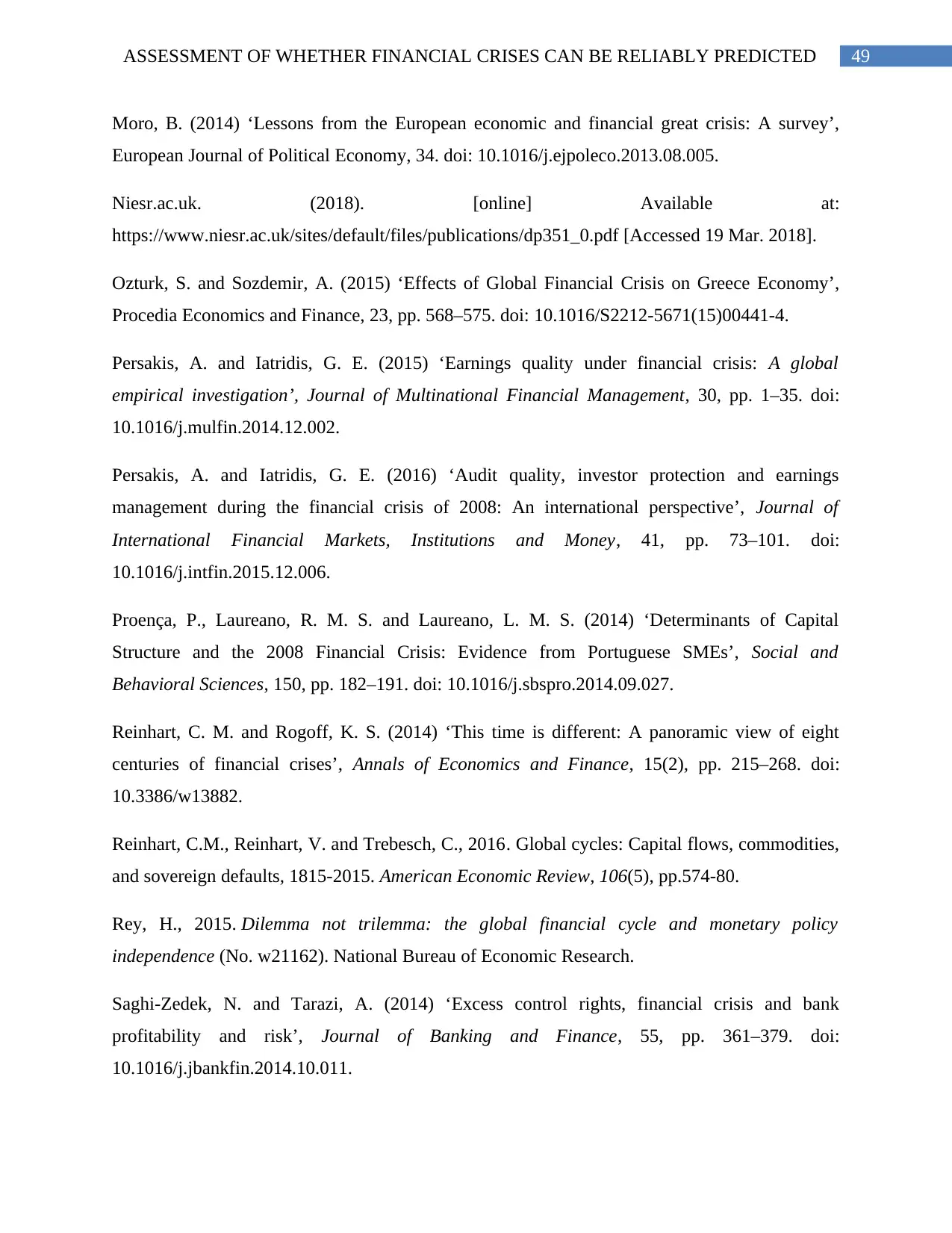
Moro, B. (2014) ‘Lessons from the European economic and financial great crisis: A survey’,
European Journal of Political Economy, 34. doi: 10.1016/j.ejpoleco.2013.08.005.
Niesr.ac.uk. (2018). [online] Available at:
https://www.niesr.ac.uk/sites/default/files/publications/dp351_0.pdf [Accessed 19 Mar. 2018].
Ozturk, S. and Sozdemir, A. (2015) ‘Effects of Global Financial Crisis on Greece Economy’,
Procedia Economics and Finance, 23, pp. 568–575. doi: 10.1016/S2212-5671(15)00441-4.
Persakis, A. and Iatridis, G. E. (2015) ‘Earnings quality under financial crisis: A global
empirical investigation’, Journal of Multinational Financial Management, 30, pp. 1–35. doi:
10.1016/j.mulfin.2014.12.002.
Persakis, A. and Iatridis, G. E. (2016) ‘Audit quality, investor protection and earnings
management during the financial crisis of 2008: An international perspective’, Journal of
International Financial Markets, Institutions and Money, 41, pp. 73–101. doi:
10.1016/j.intfin.2015.12.006.
Proença, P., Laureano, R. M. S. and Laureano, L. M. S. (2014) ‘Determinants of Capital
Structure and the 2008 Financial Crisis: Evidence from Portuguese SMEs’, Social and
Behavioral Sciences, 150, pp. 182–191. doi: 10.1016/j.sbspro.2014.09.027.
Reinhart, C. M. and Rogoff, K. S. (2014) ‘This time is different: A panoramic view of eight
centuries of financial crises’, Annals of Economics and Finance, 15(2), pp. 215–268. doi:
10.3386/w13882.
Reinhart, C.M., Reinhart, V. and Trebesch, C., 2016. Global cycles: Capital flows, commodities,
and sovereign defaults, 1815-2015. American Economic Review, 106(5), pp.574-80.
Rey, H., 2015. Dilemma not trilemma: the global financial cycle and monetary policy
independence (No. w21162). National Bureau of Economic Research.
Saghi-Zedek, N. and Tarazi, A. (2014) ‘Excess control rights, financial crisis and bank
profitability and risk’, Journal of Banking and Finance, 55, pp. 361–379. doi:
10.1016/j.jbankfin.2014.10.011.
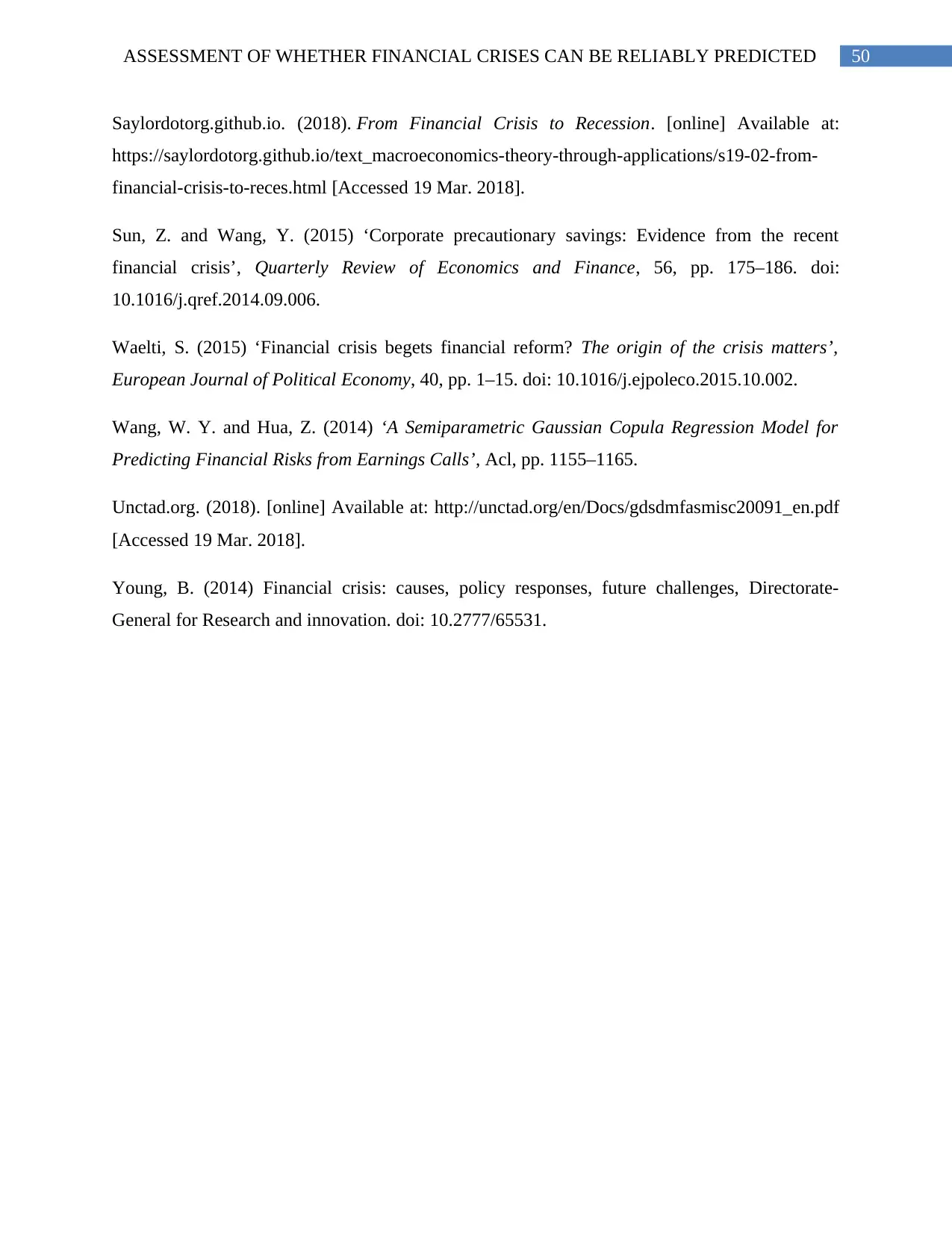
Saylordotorg.github.io. (2018). From Financial Crisis to Recession. [online] Available at:
https://saylordotorg.github.io/text_macroeconomics-theory-through-applications/s19-02-from-
financial-crisis-to-reces.html [Accessed 19 Mar. 2018].
Sun, Z. and Wang, Y. (2015) ‘Corporate precautionary savings: Evidence from the recent
financial crisis’, Quarterly Review of Economics and Finance, 56, pp. 175–186. doi:
10.1016/j.qref.2014.09.006.
Waelti, S. (2015) ‘Financial crisis begets financial reform? The origin of the crisis matters’,
European Journal of Political Economy, 40, pp. 1–15. doi: 10.1016/j.ejpoleco.2015.10.002.
Wang, W. Y. and Hua, Z. (2014) ‘A Semiparametric Gaussian Copula Regression Model for
Predicting Financial Risks from Earnings Calls’, Acl, pp. 1155–1165.
Unctad.org. (2018). [online] Available at: http://unctad.org/en/Docs/gdsdmfasmisc20091_en.pdf
[Accessed 19 Mar. 2018].
Young, B. (2014) Financial crisis: causes, policy responses, future challenges, Directorate-
General for Research and innovation. doi: 10.2777/65531.
You're viewing a preview
Unlock full access by subscribing today!
Your All-in-One AI-Powered Toolkit for Academic Success.
+13062052269
info@desklib.com
Available 24*7 on WhatsApp / Email
![[object Object]](/_next/static/media/star-bottom.7253800d.svg)
© 2024 | Zucol Services PVT LTD | All rights reserved.